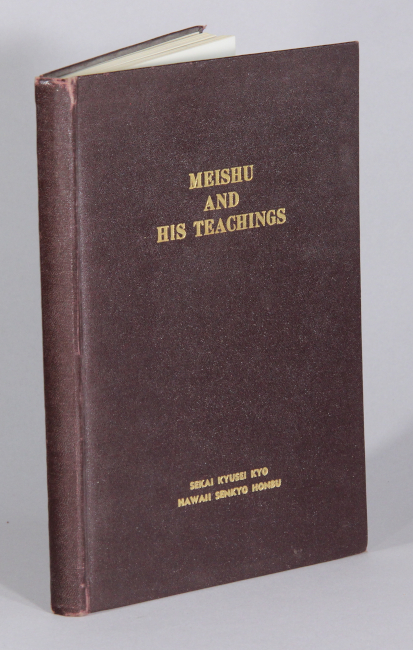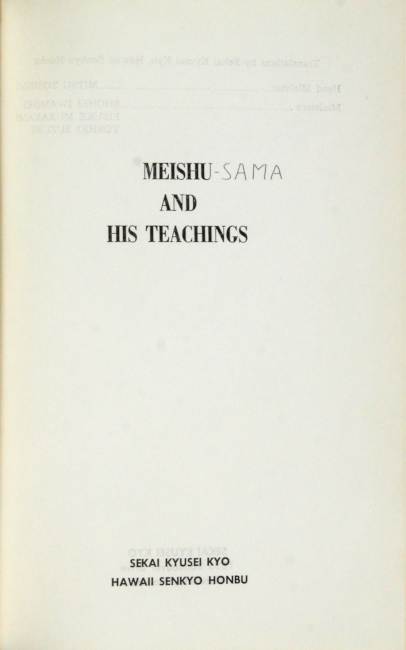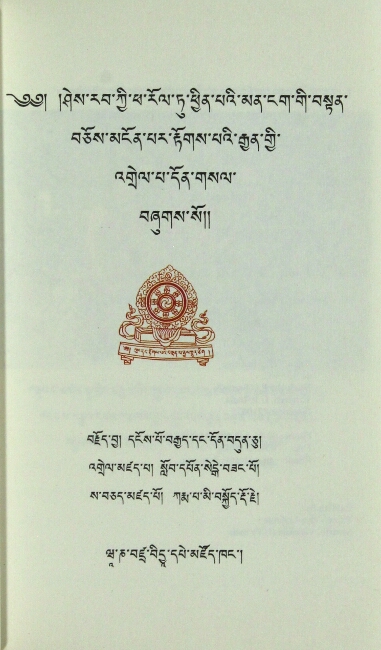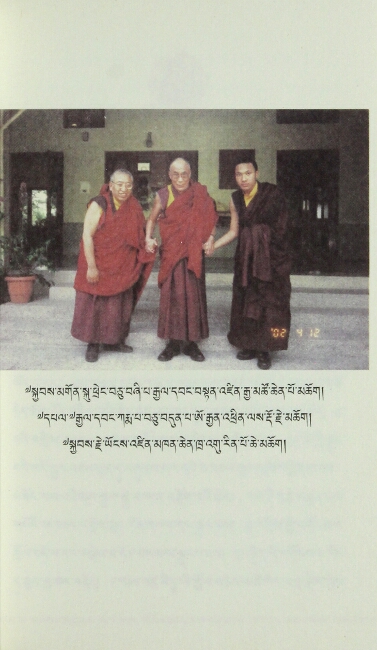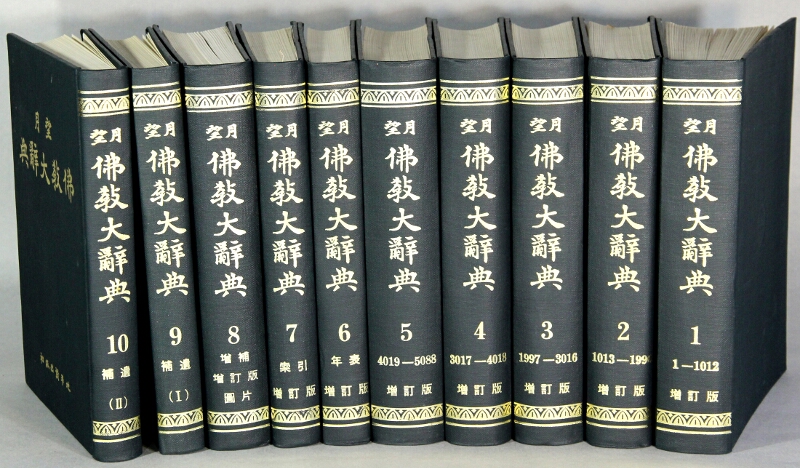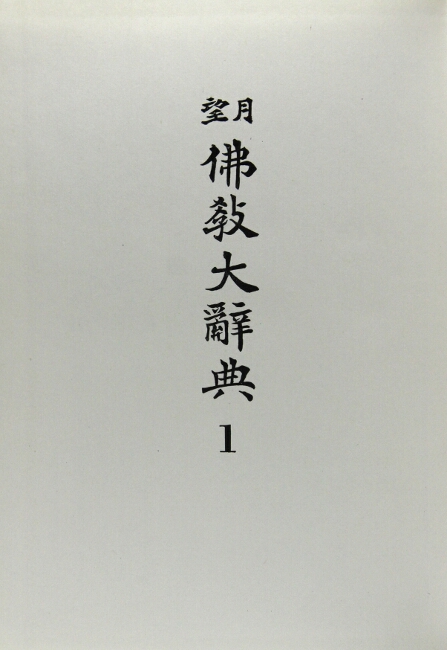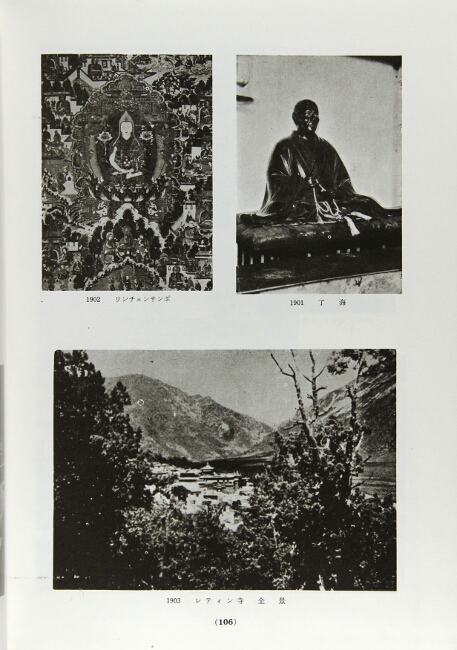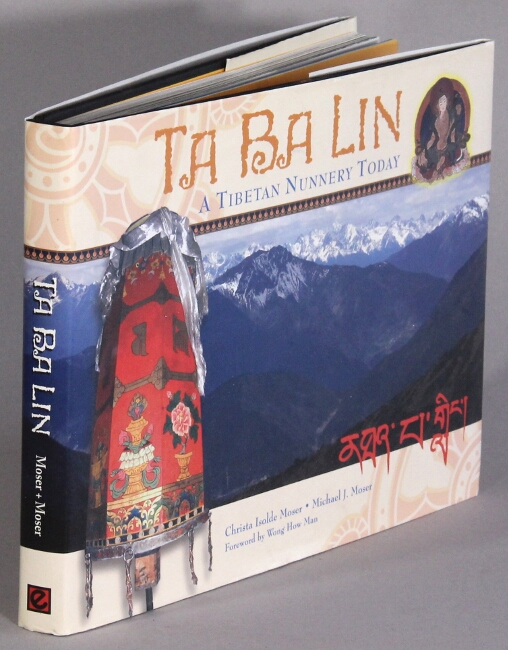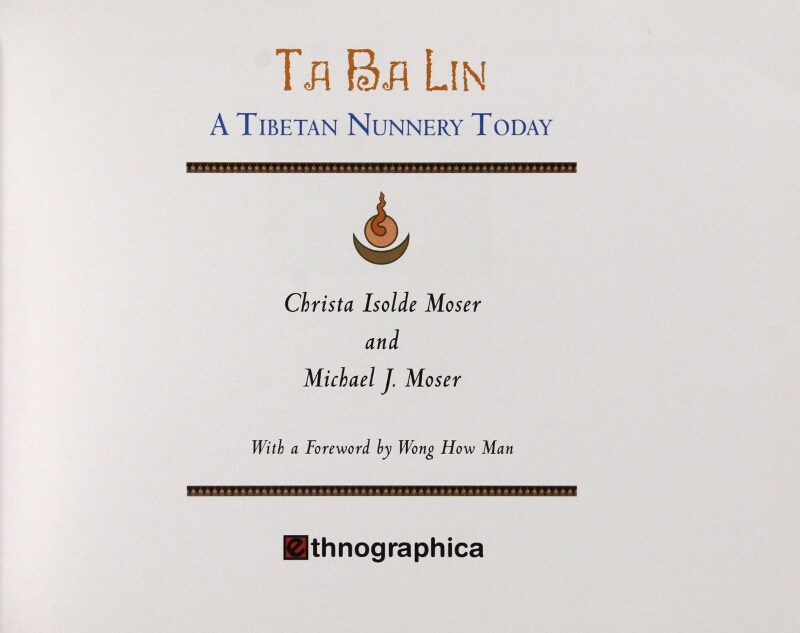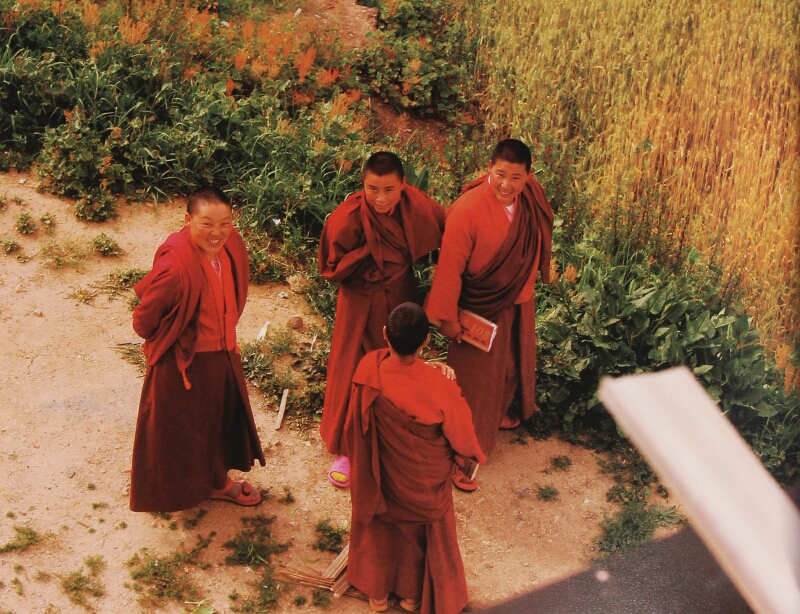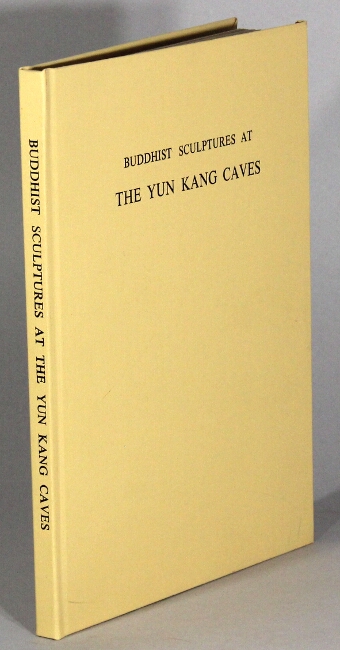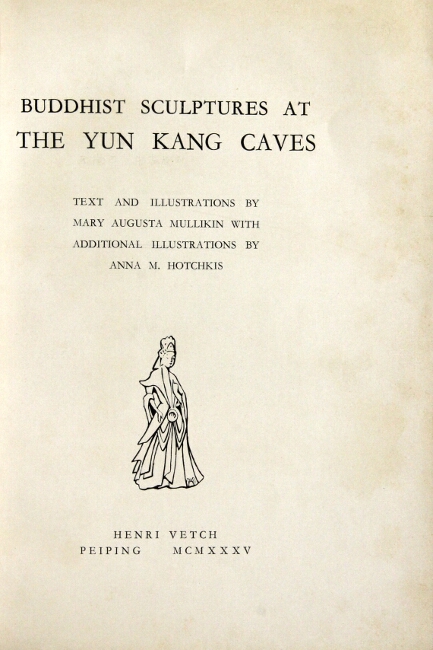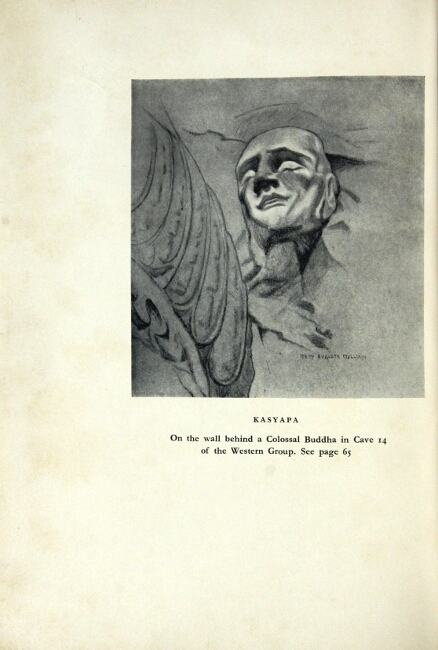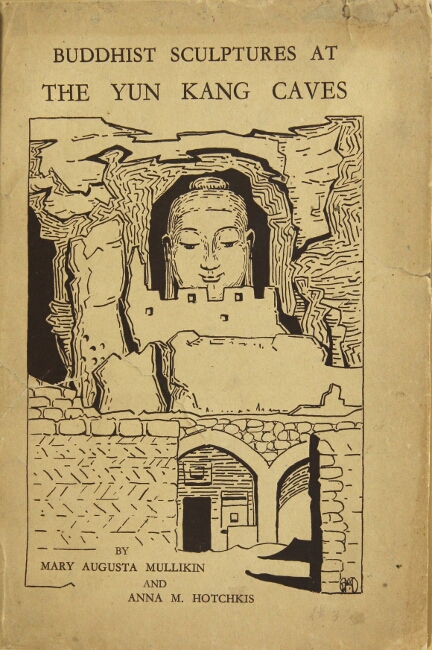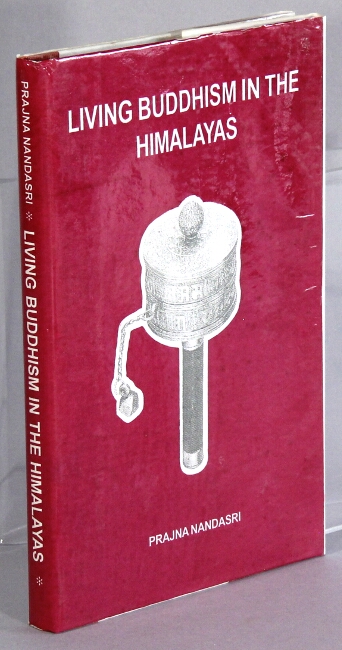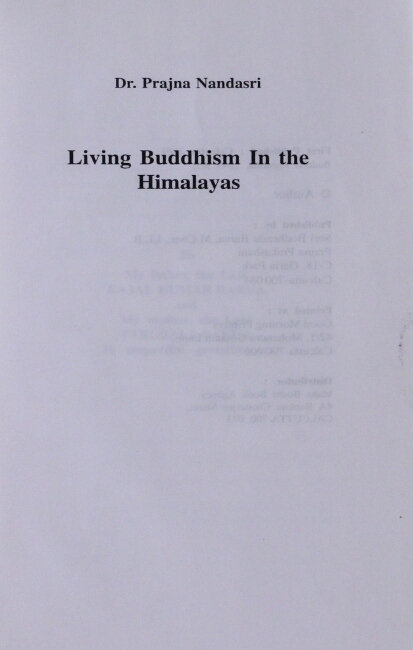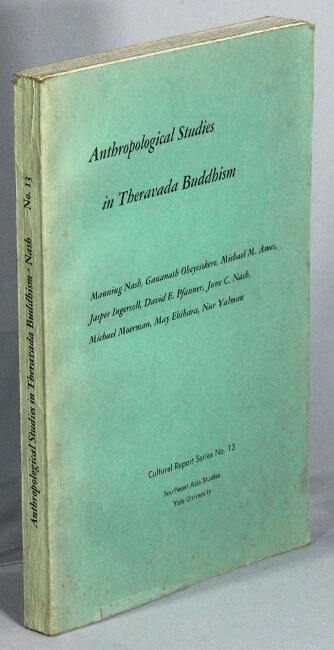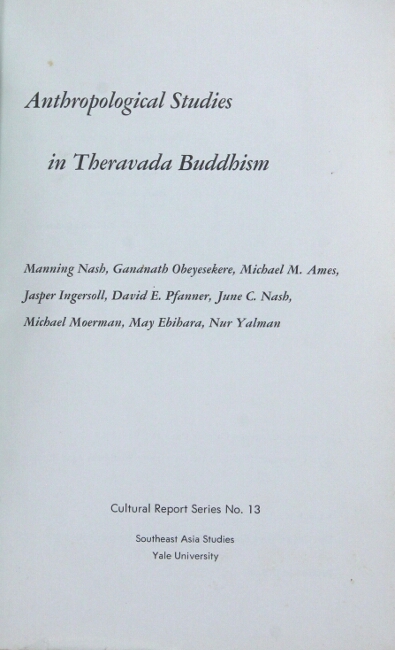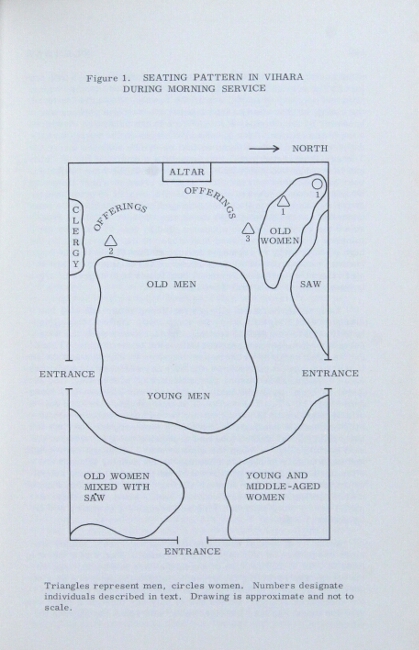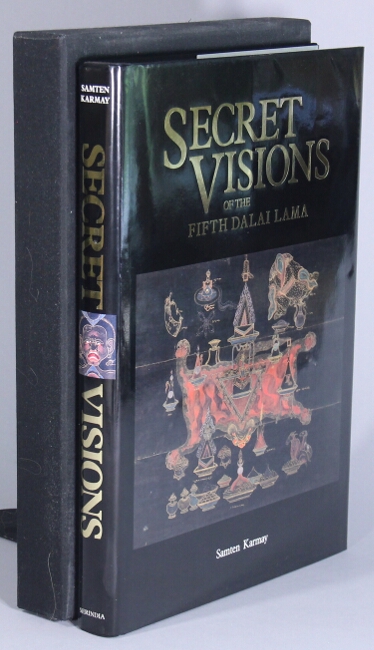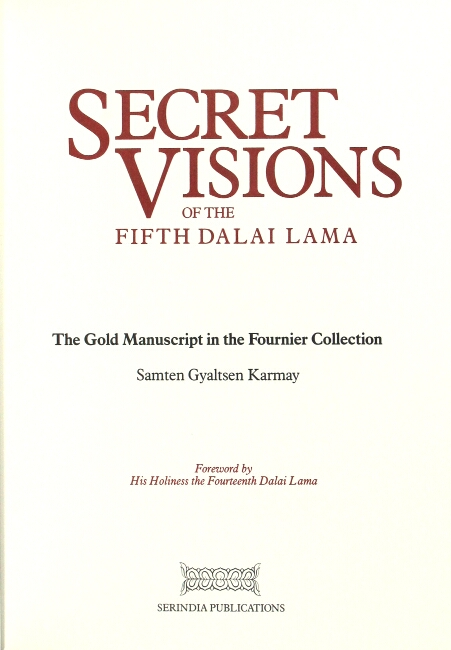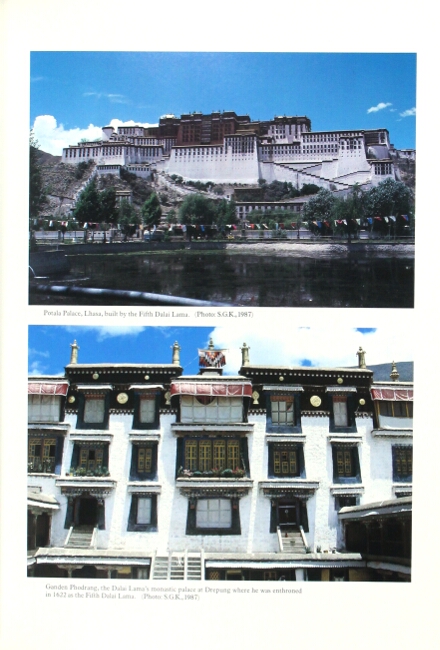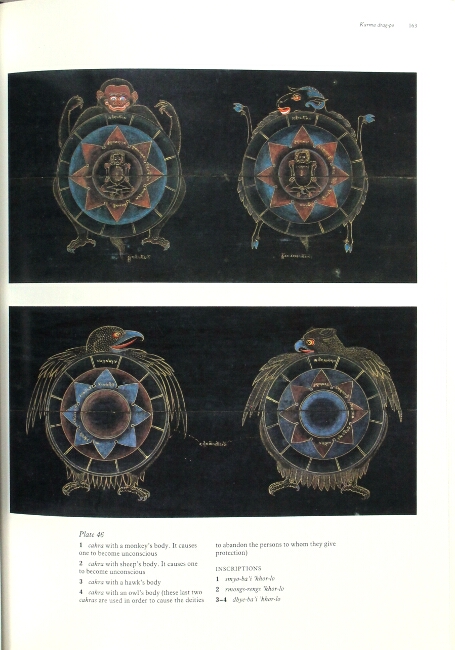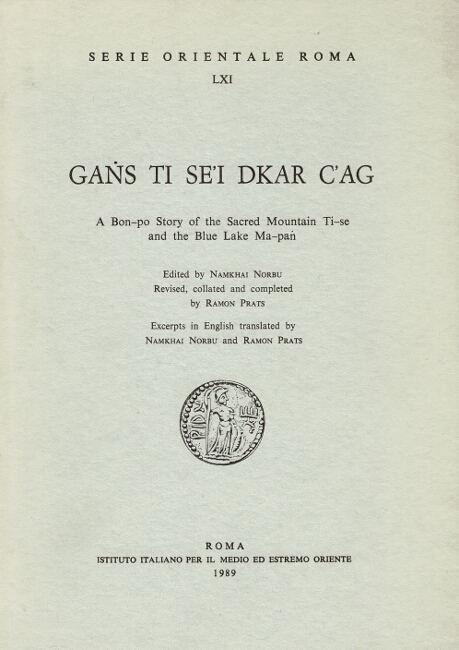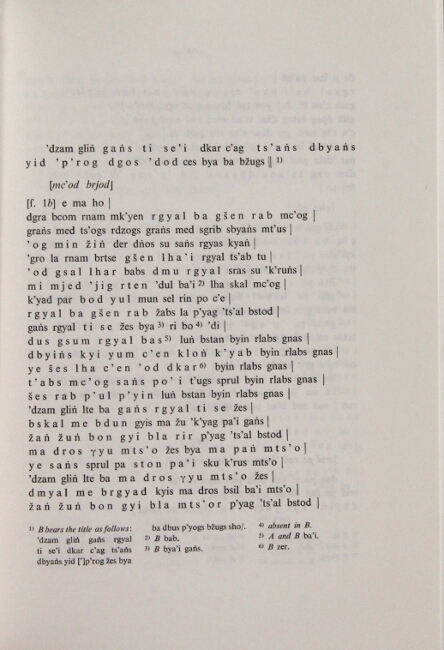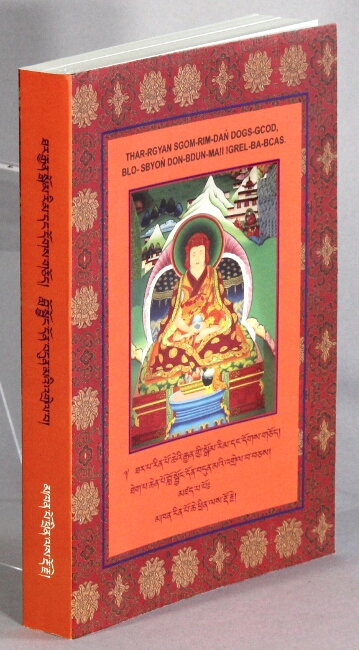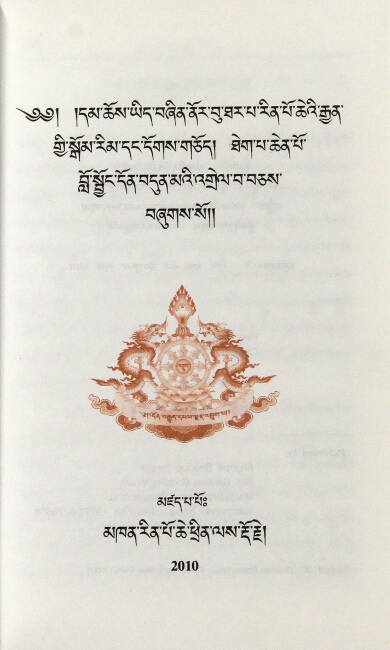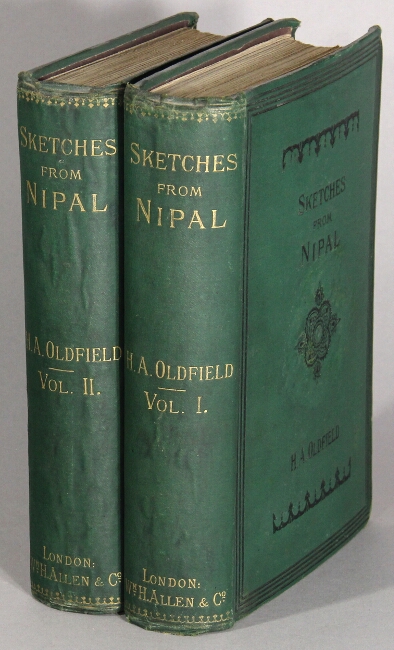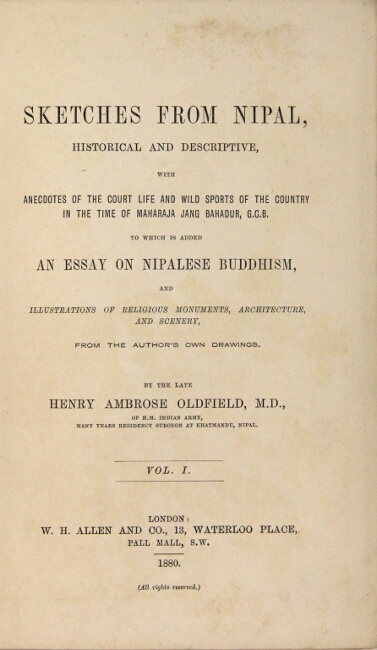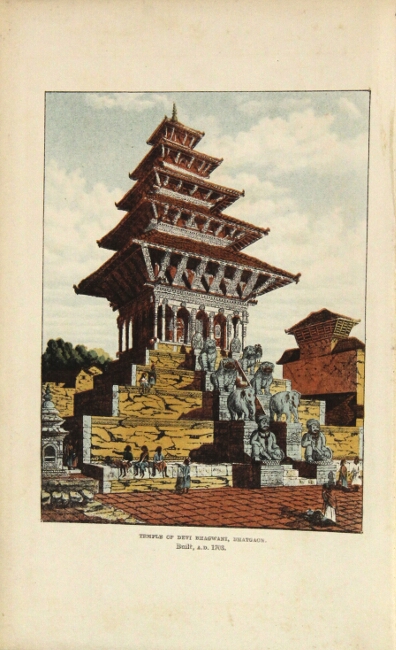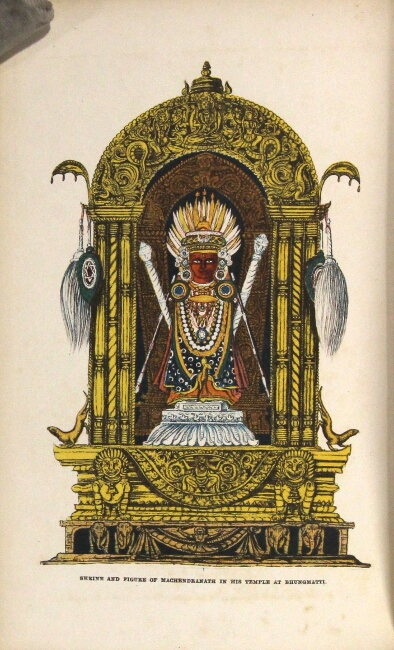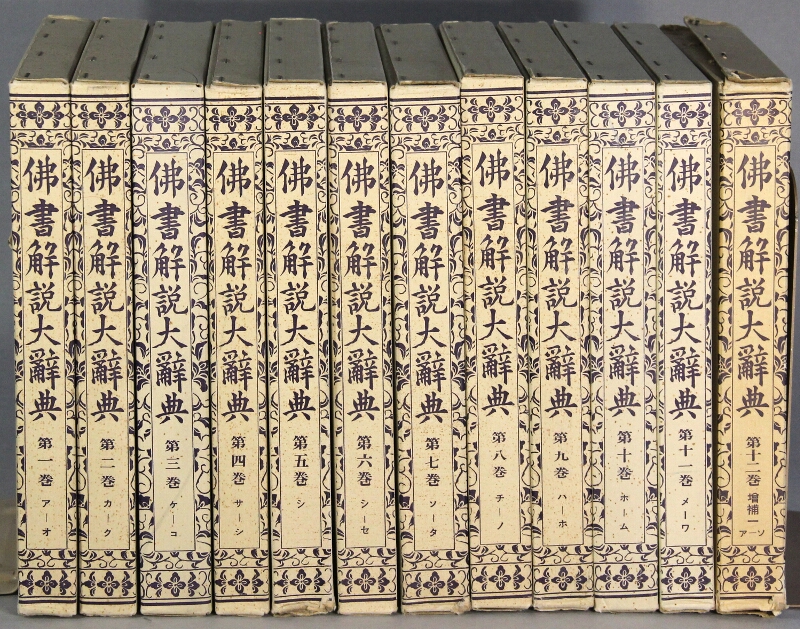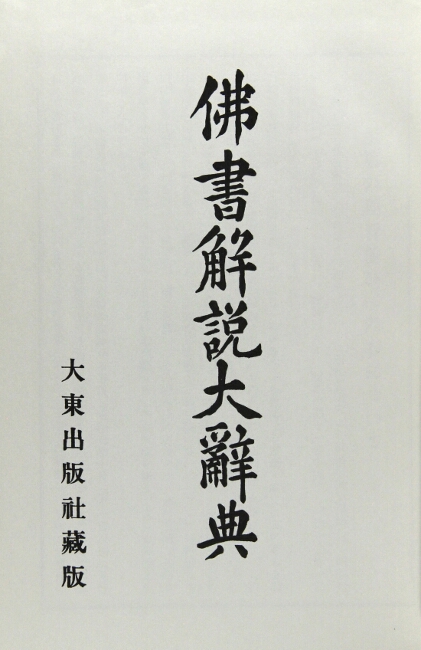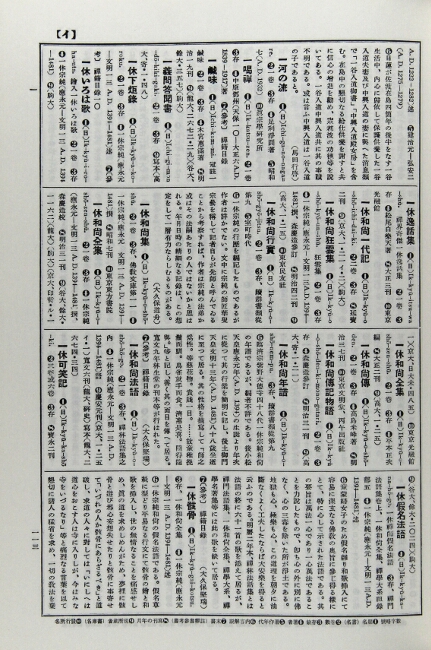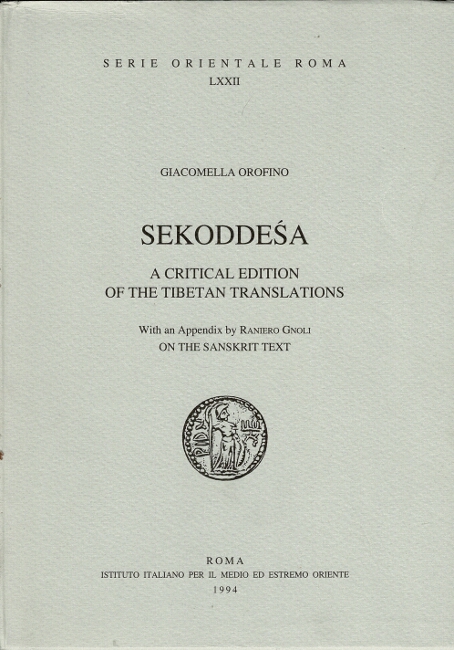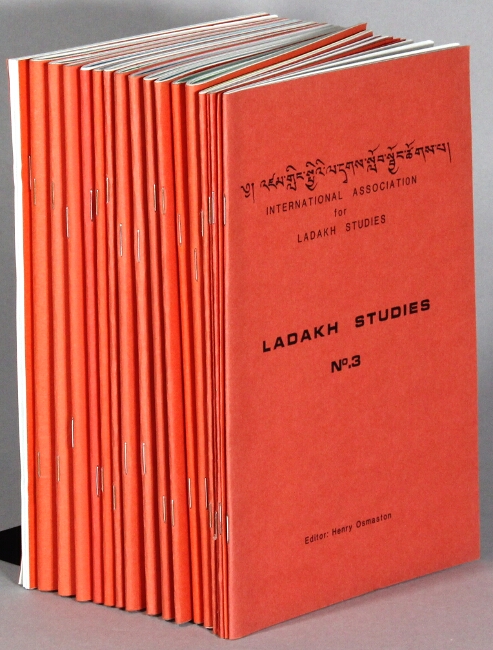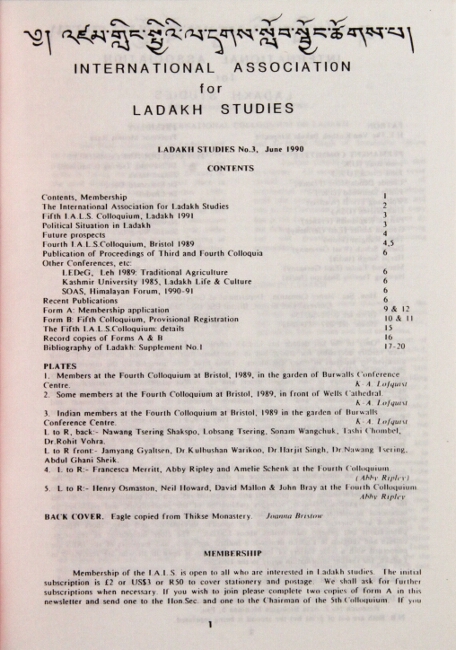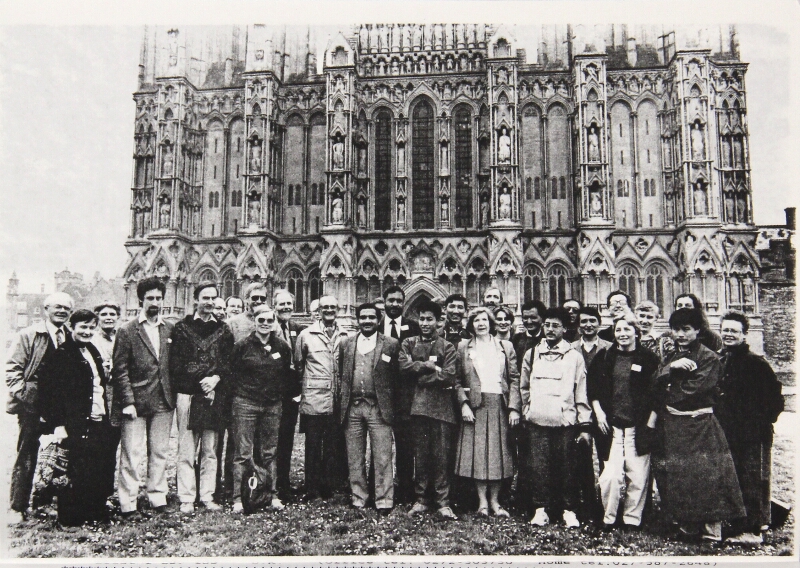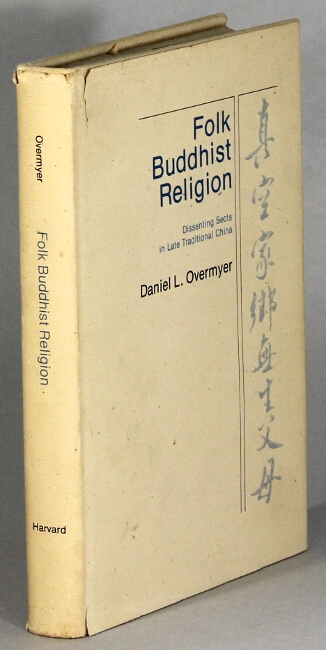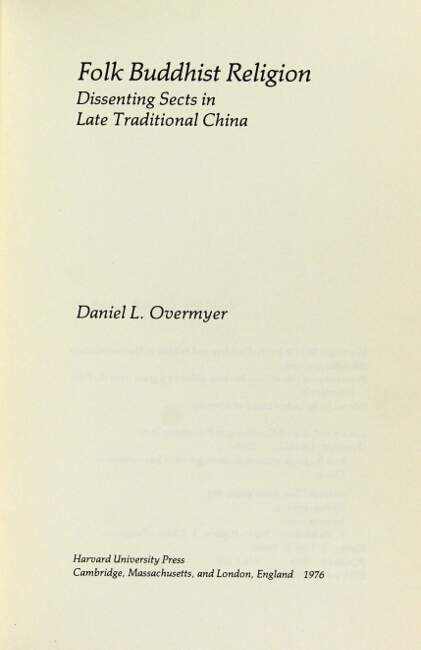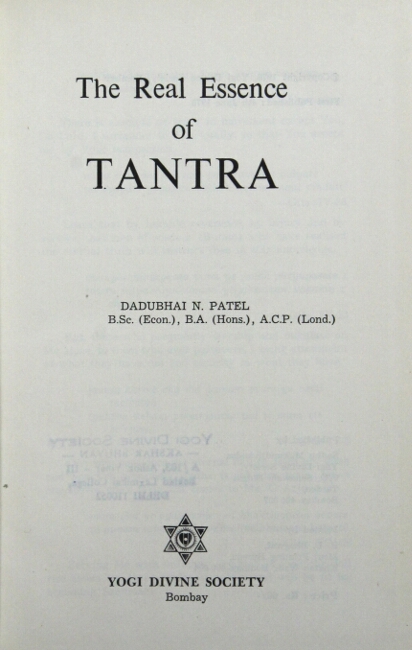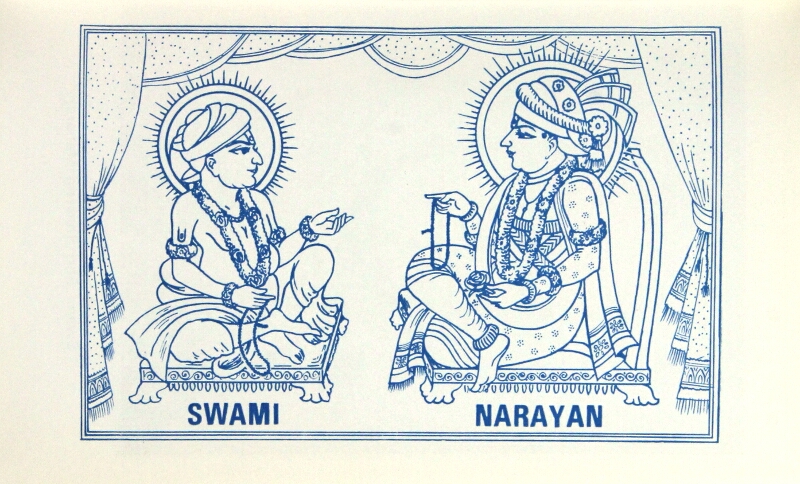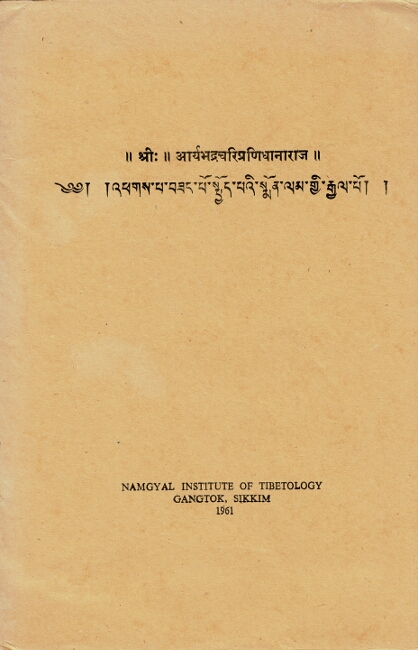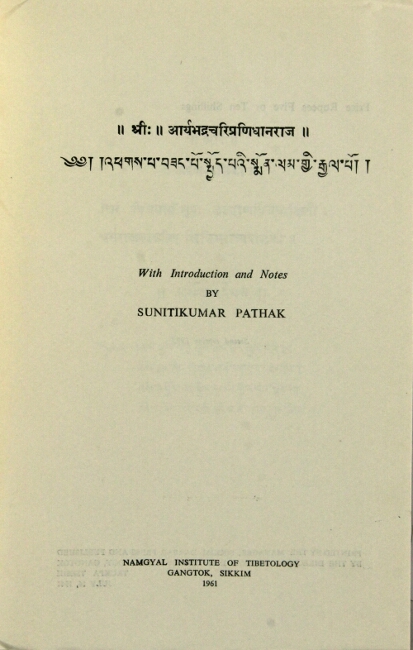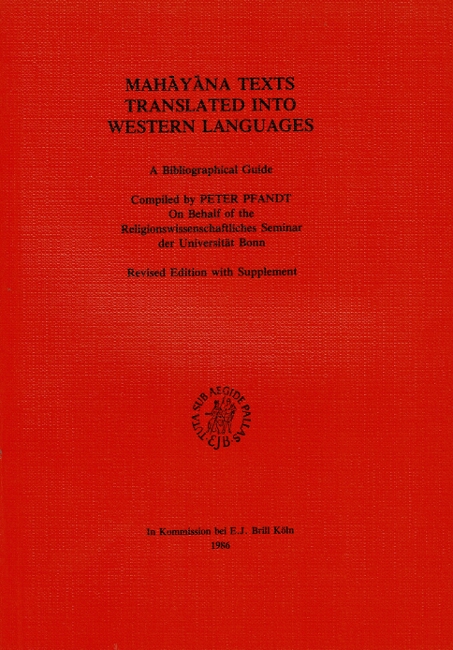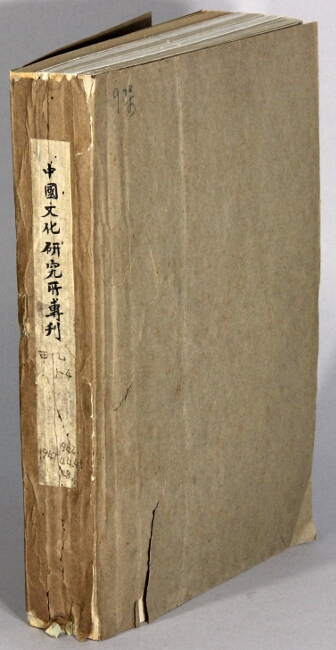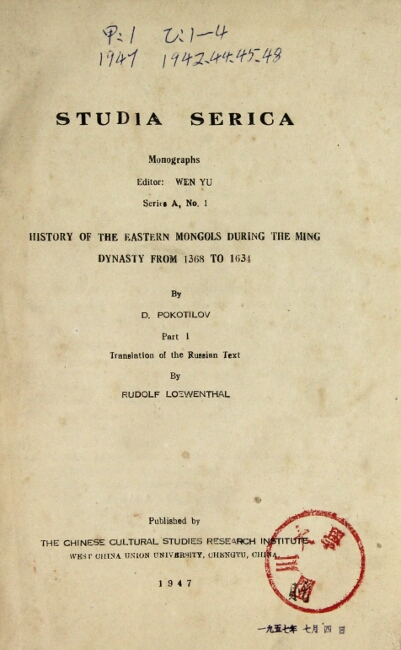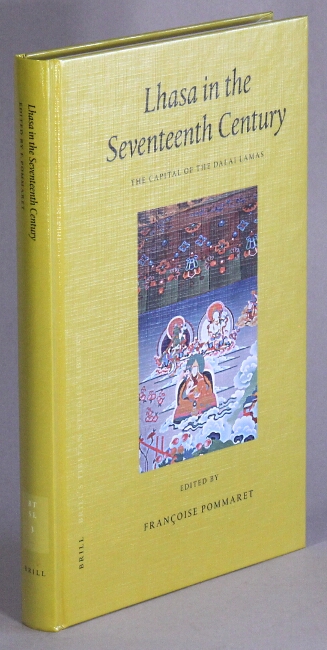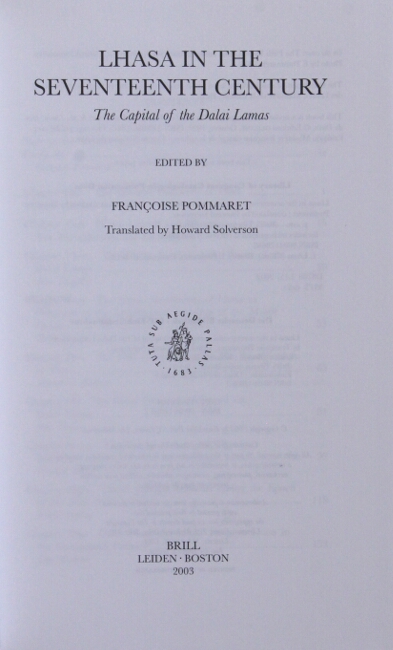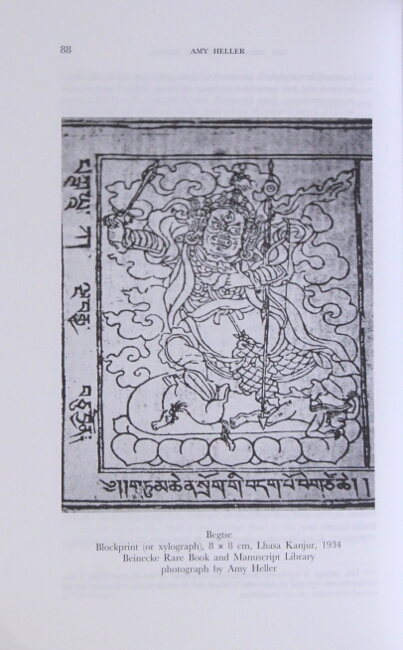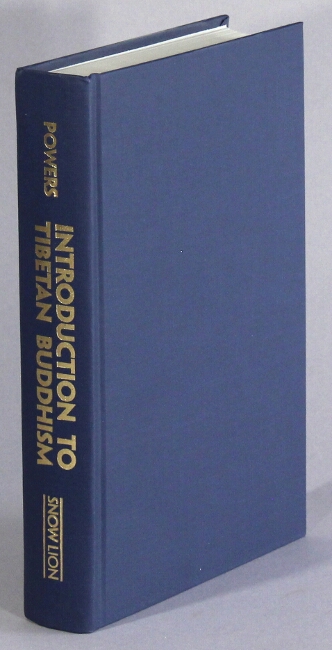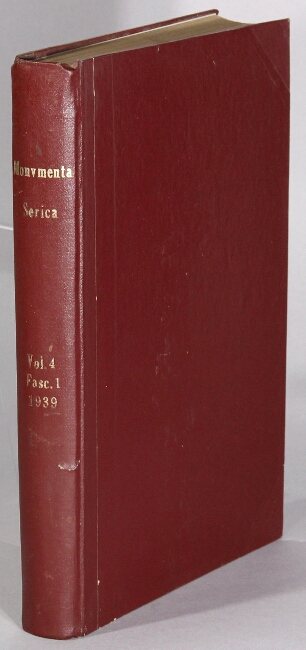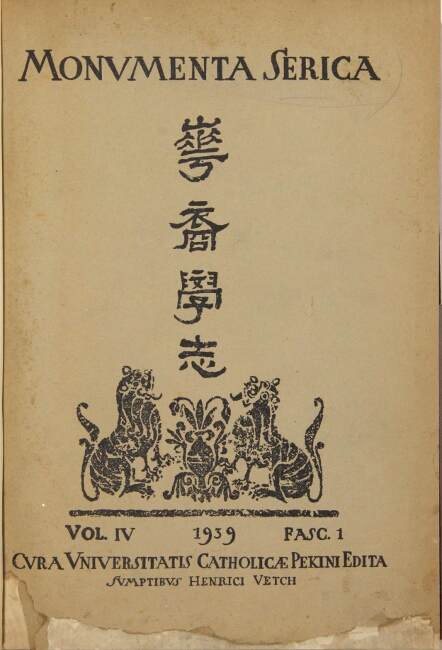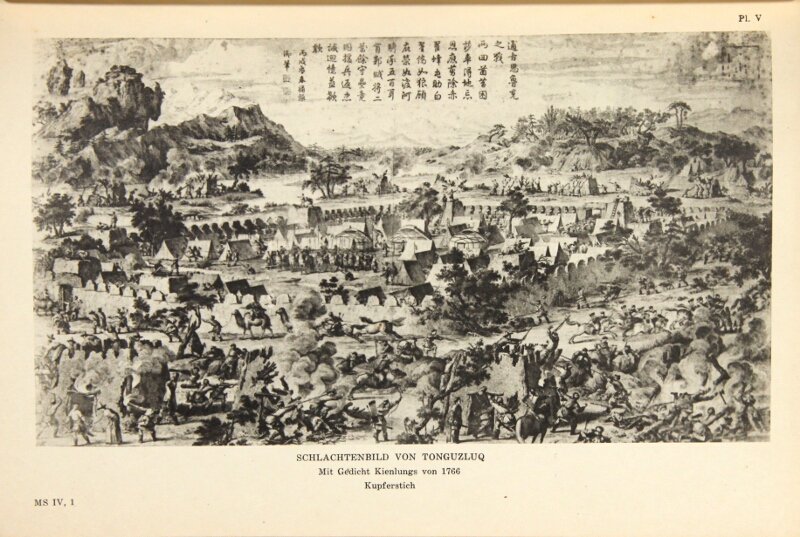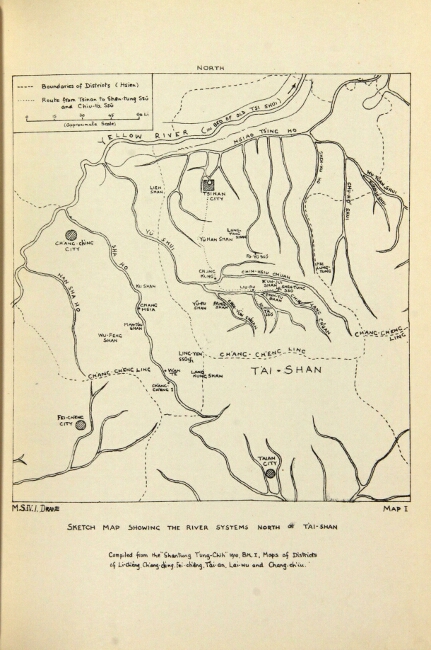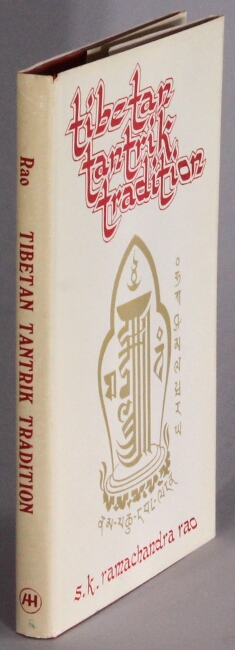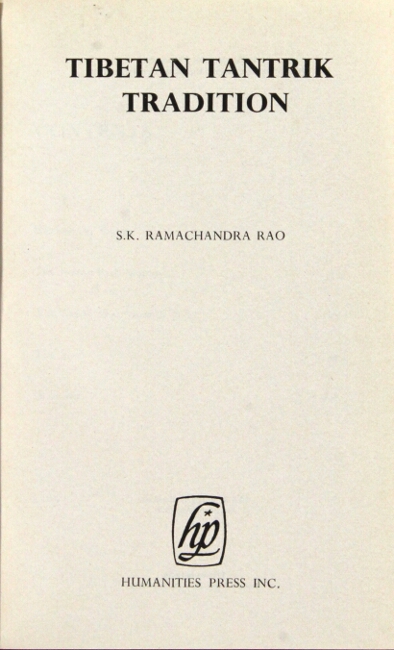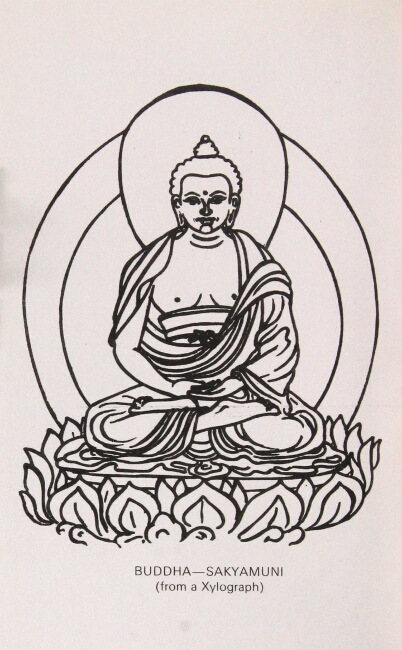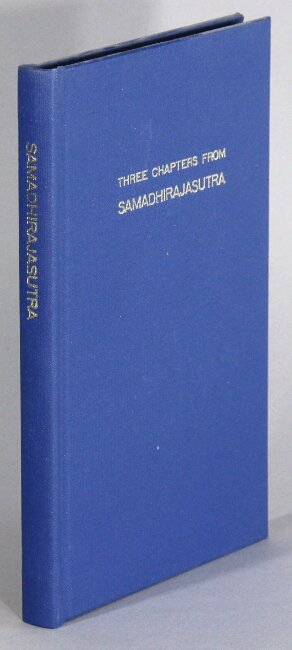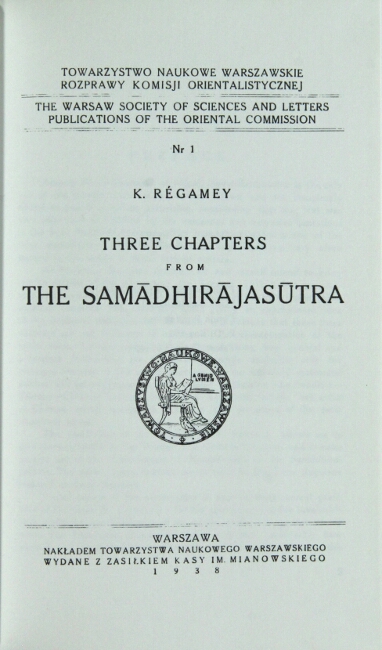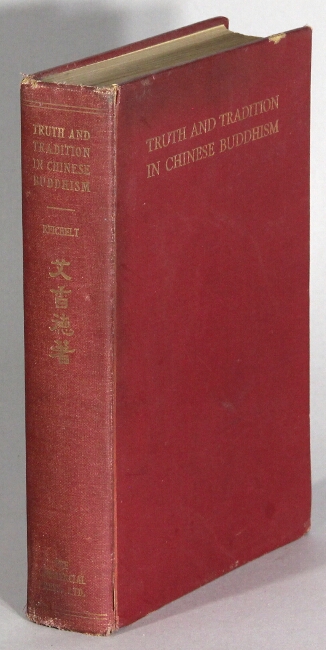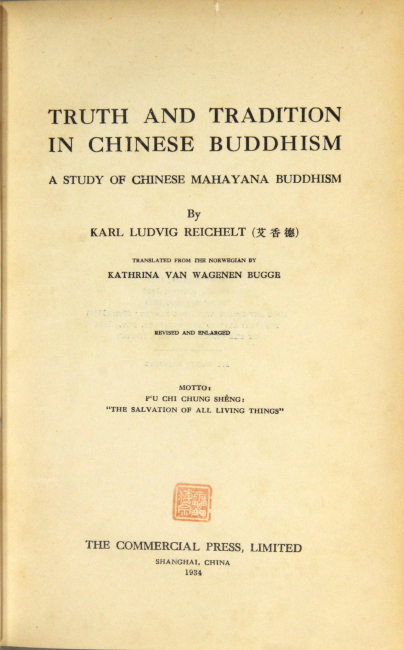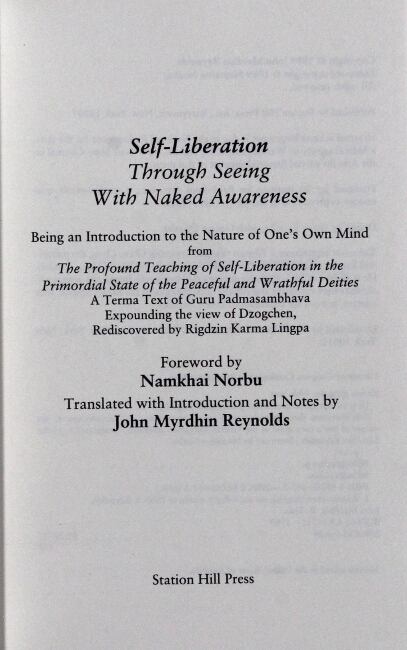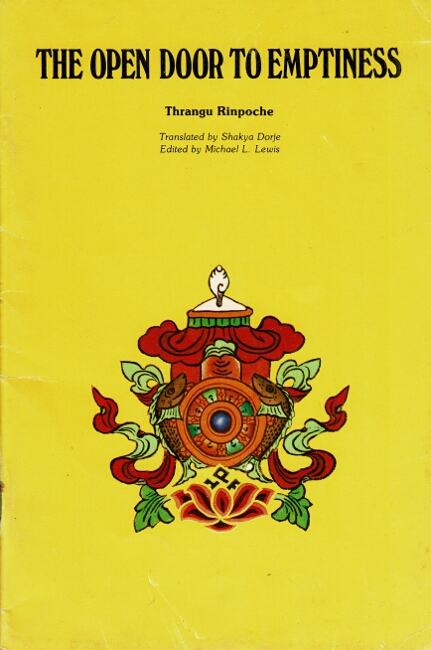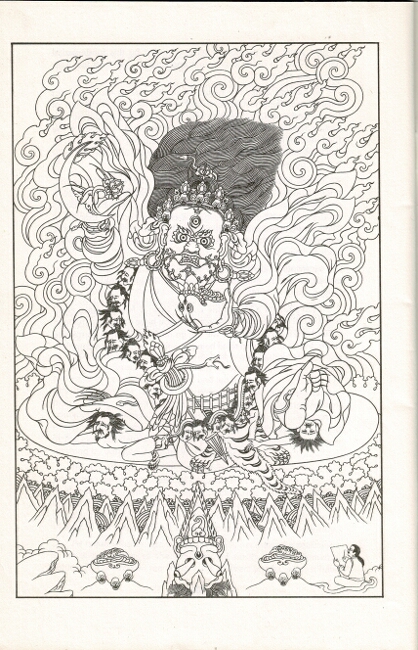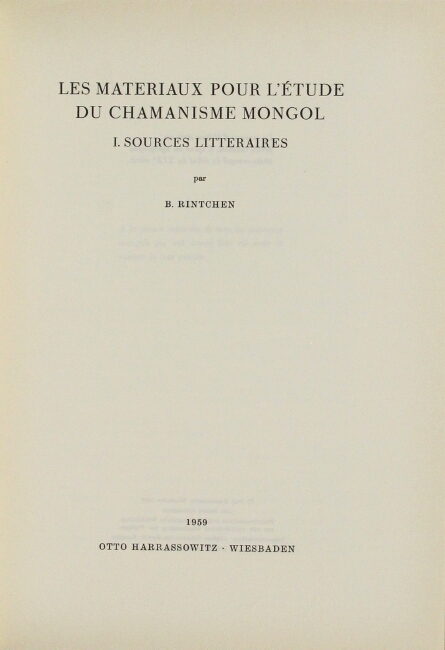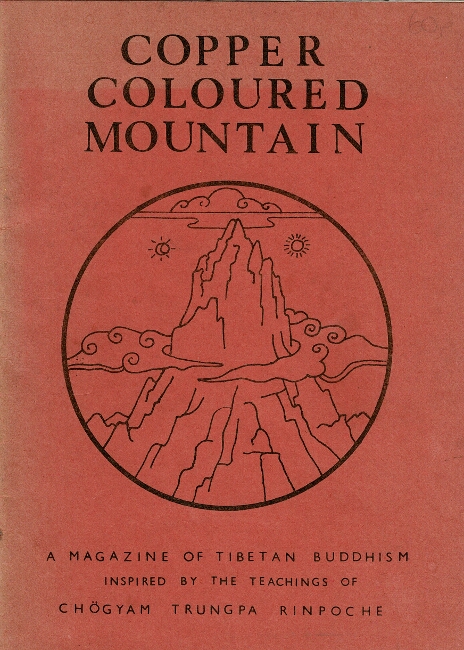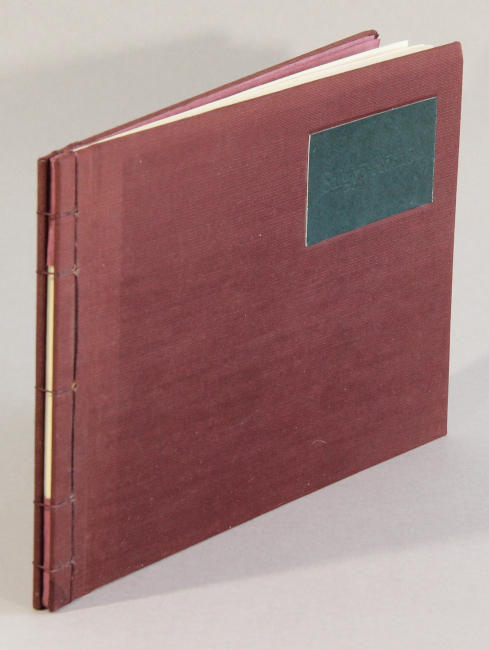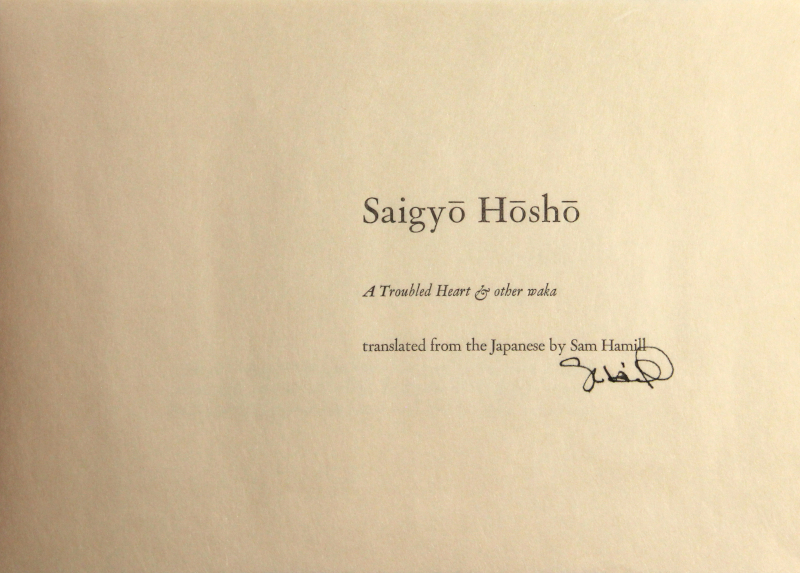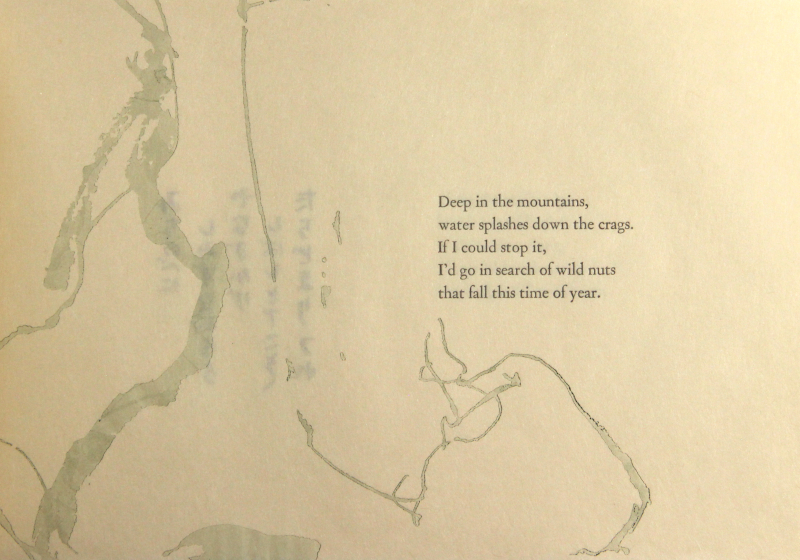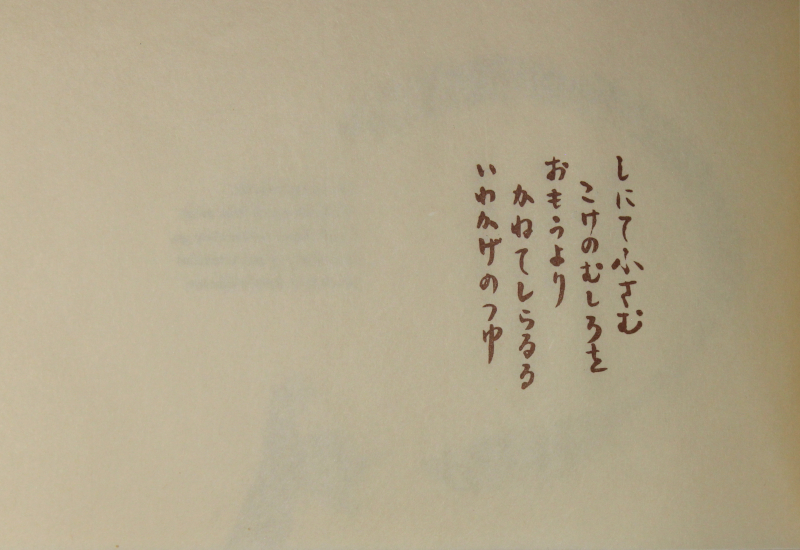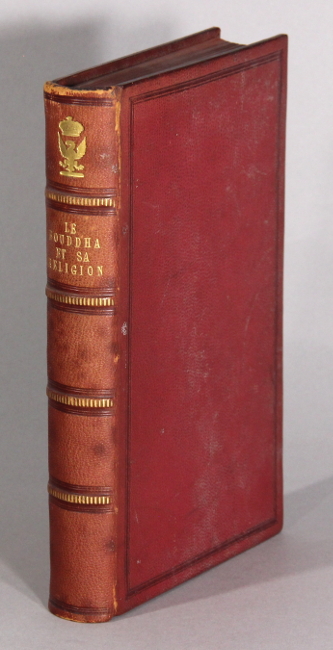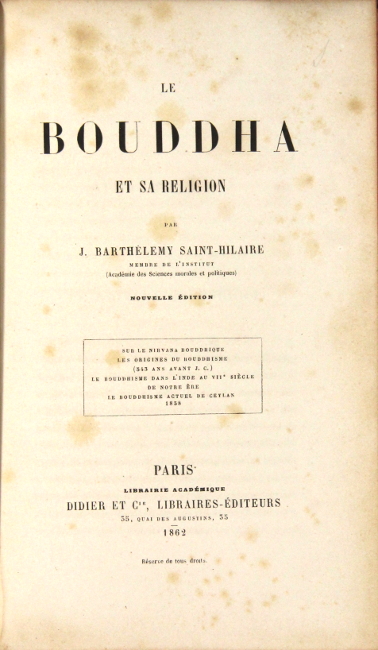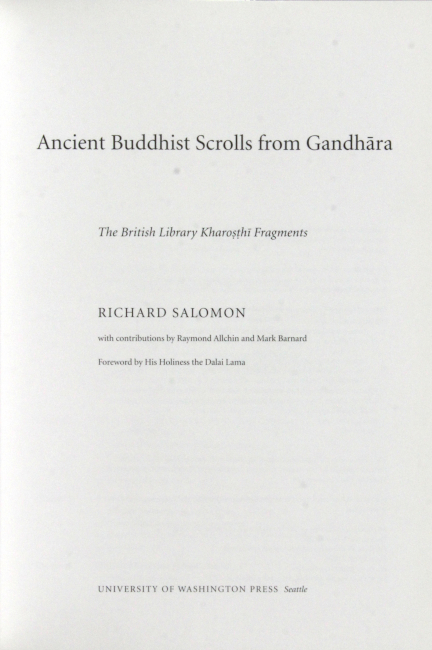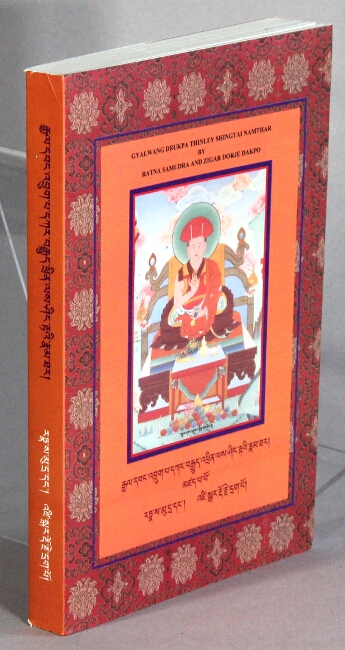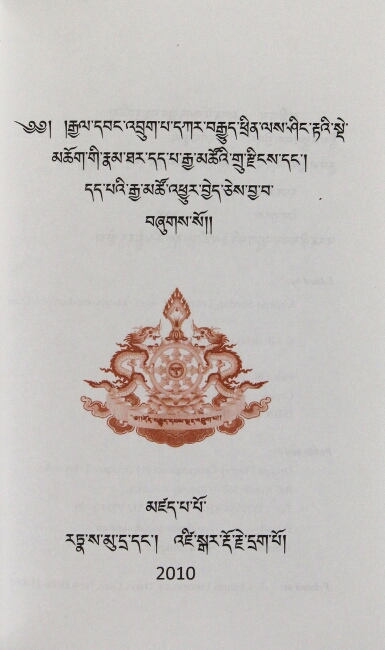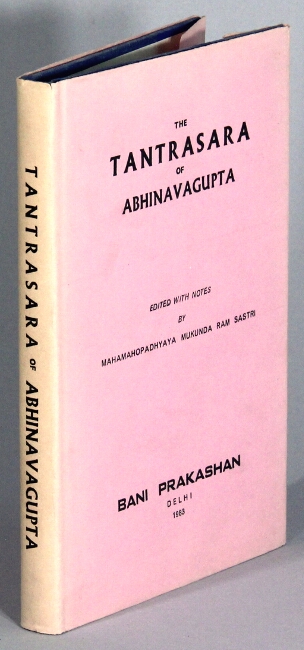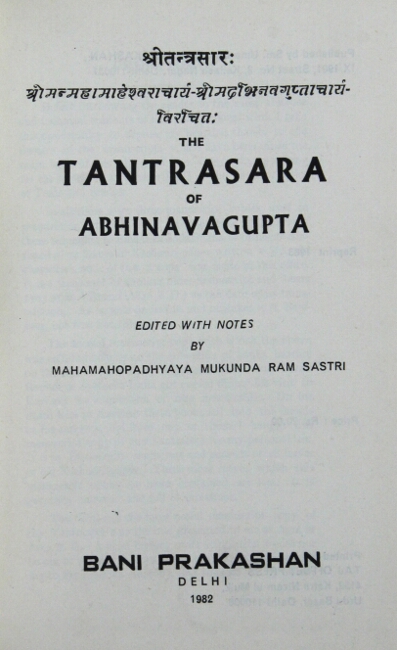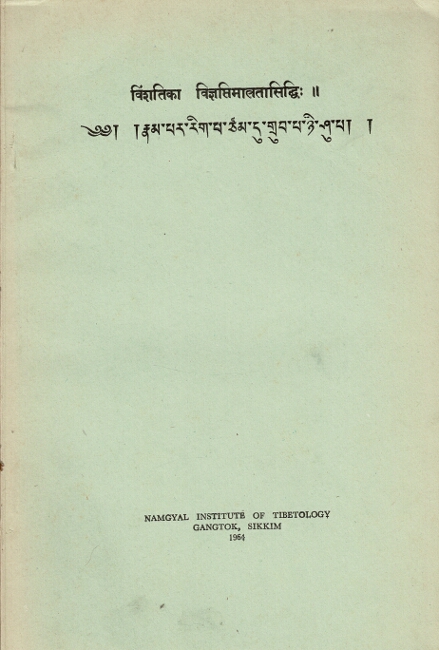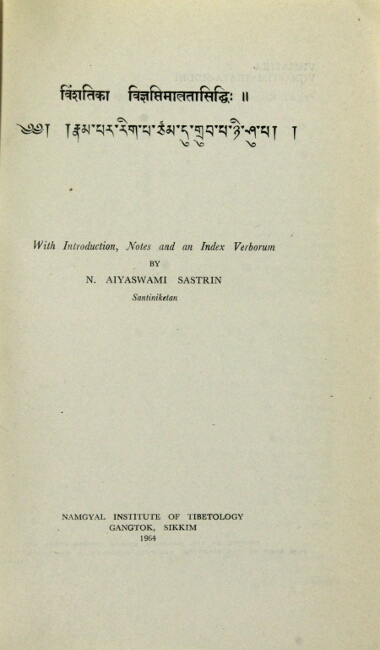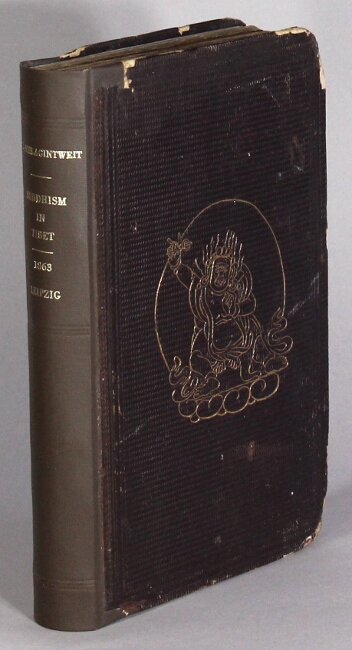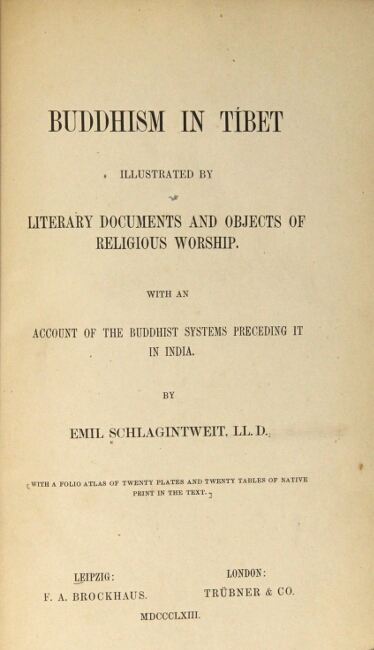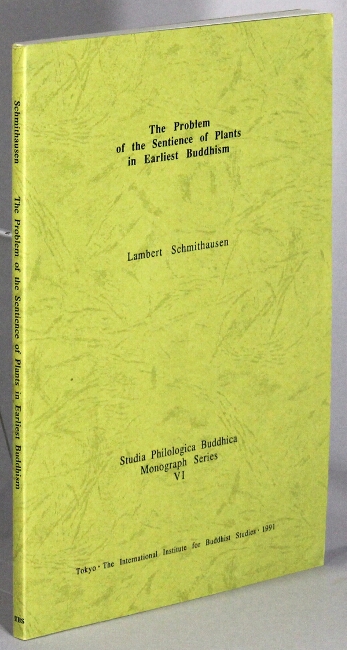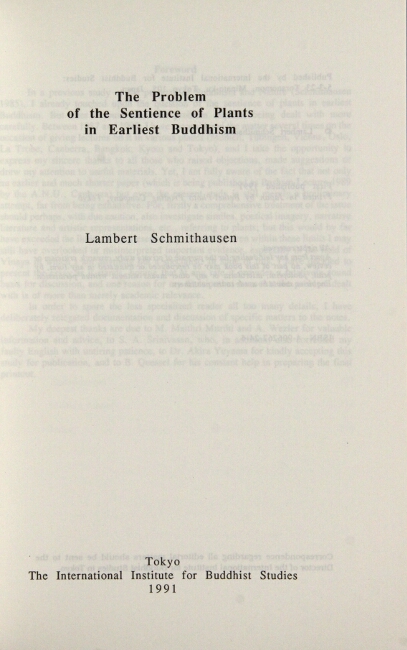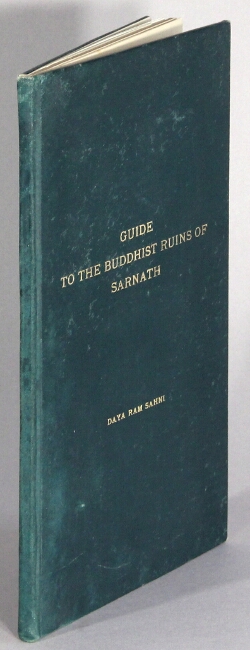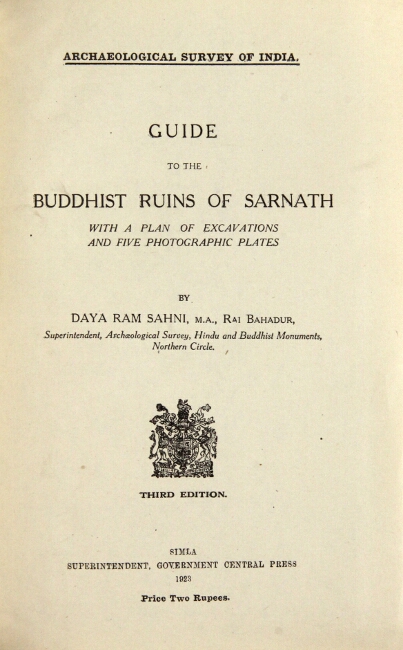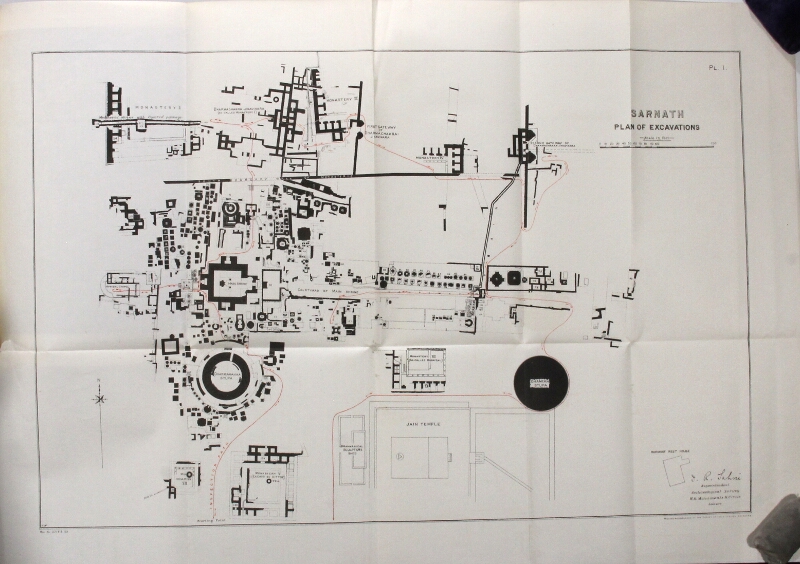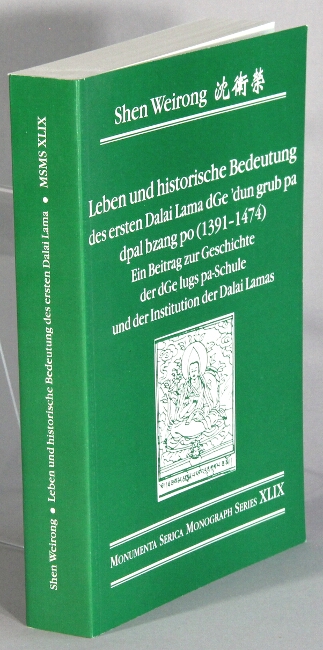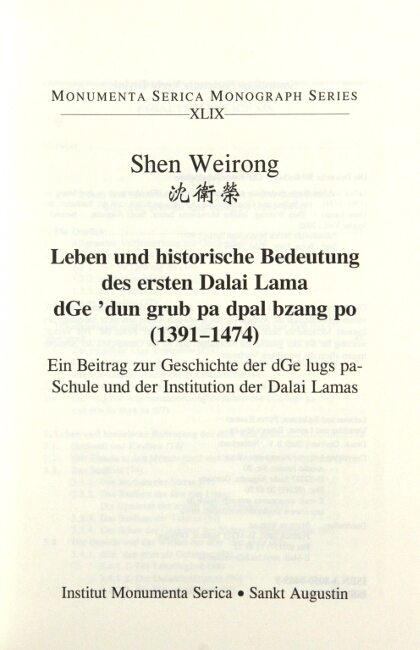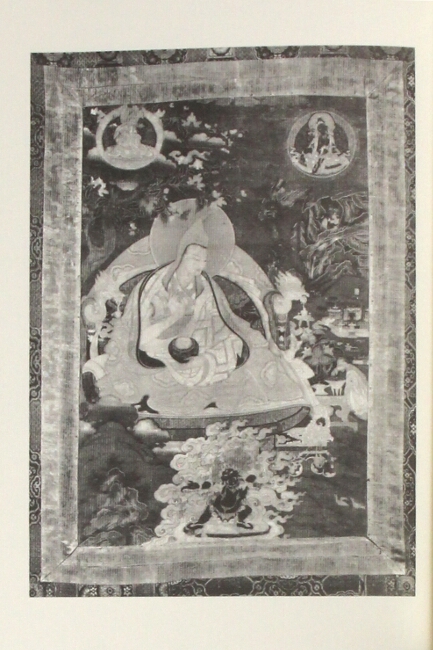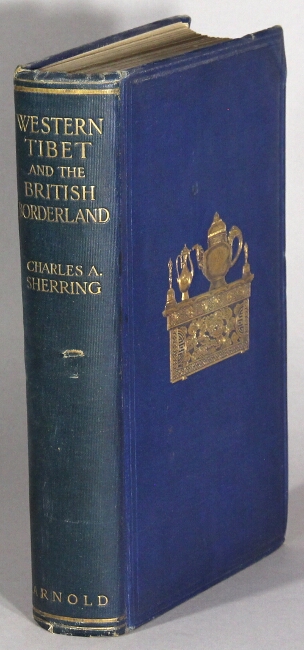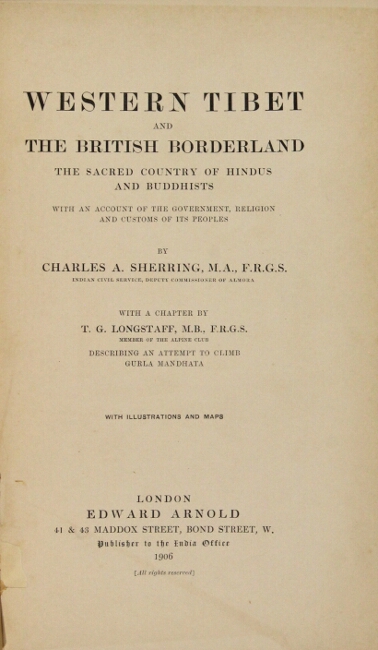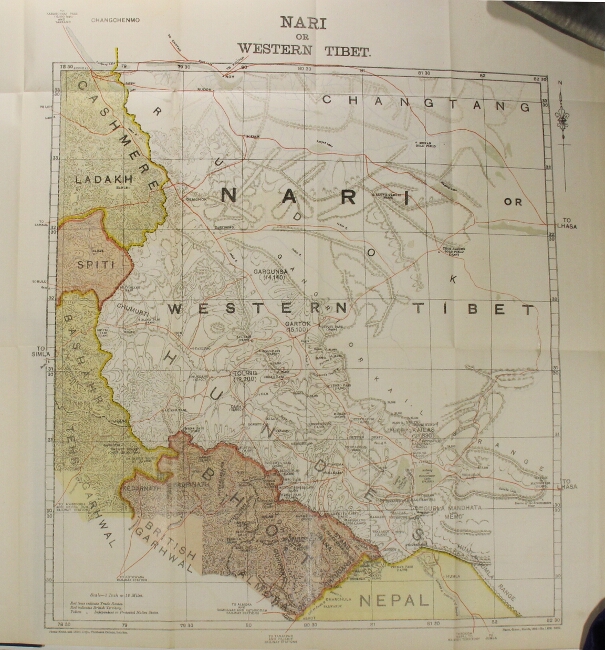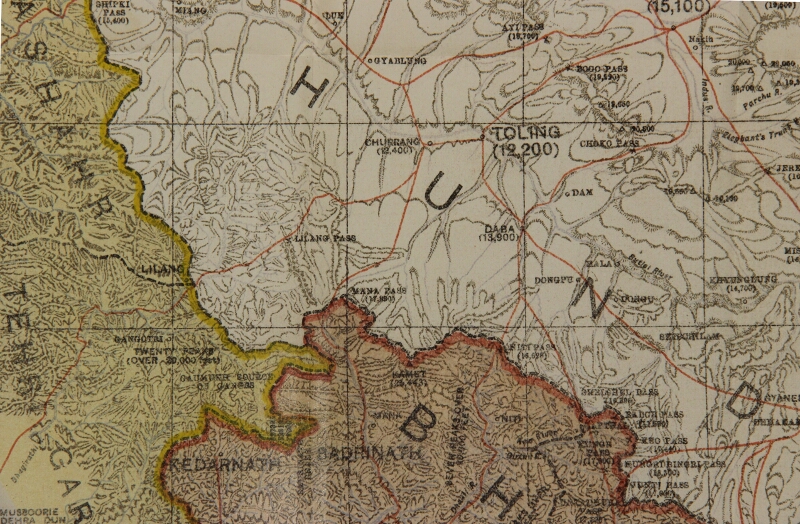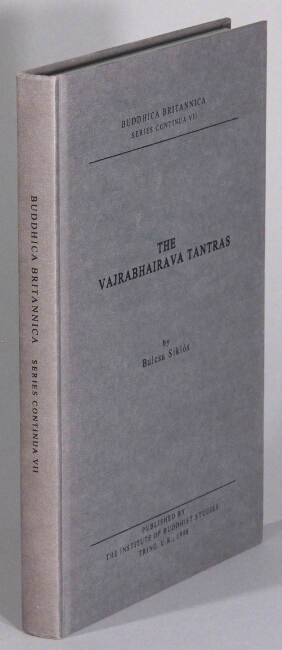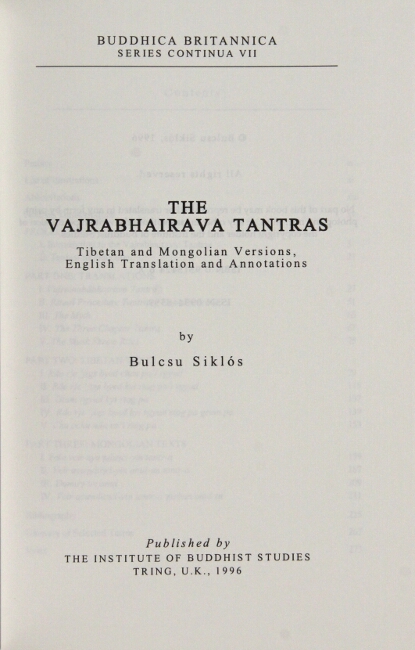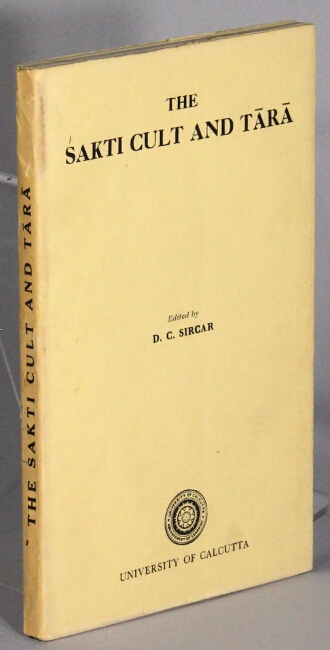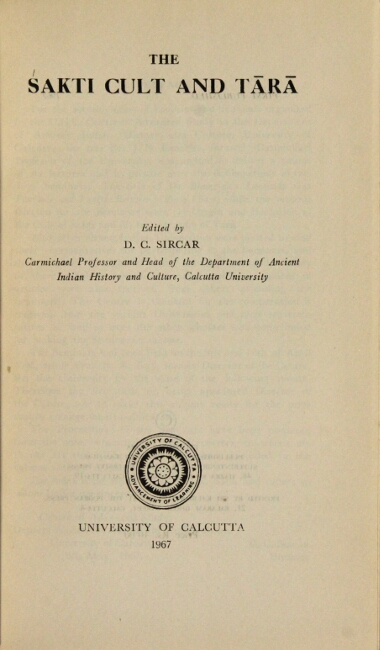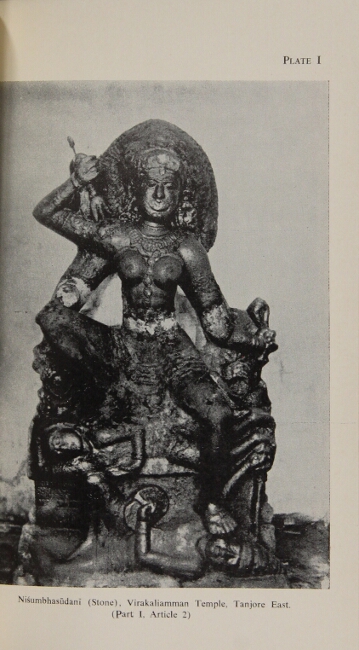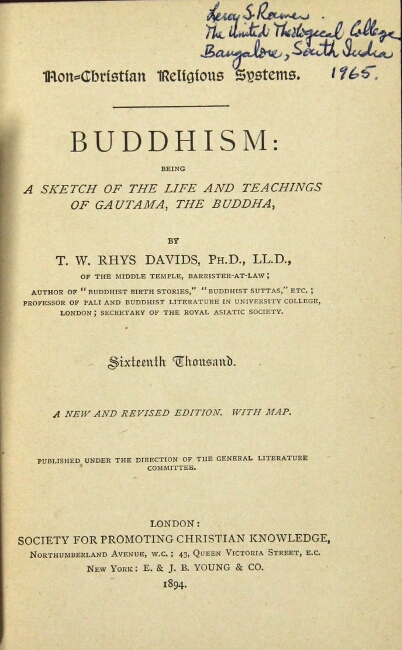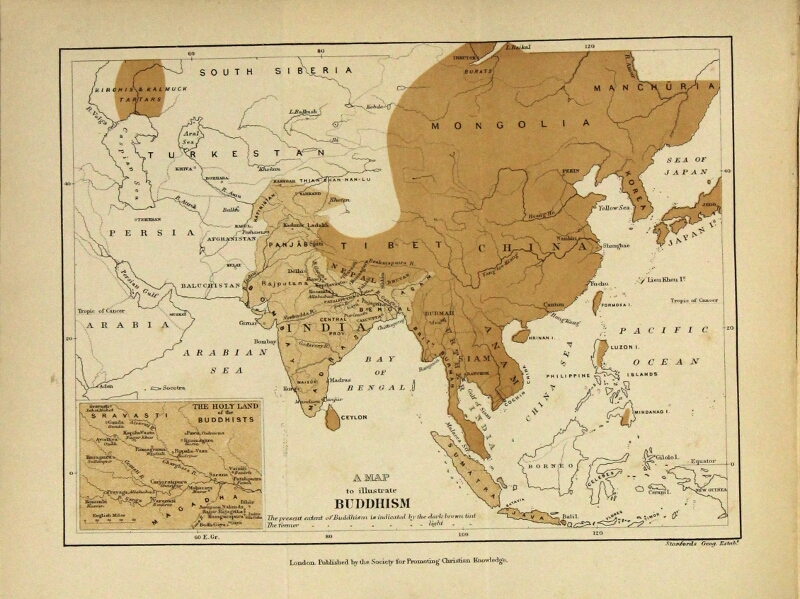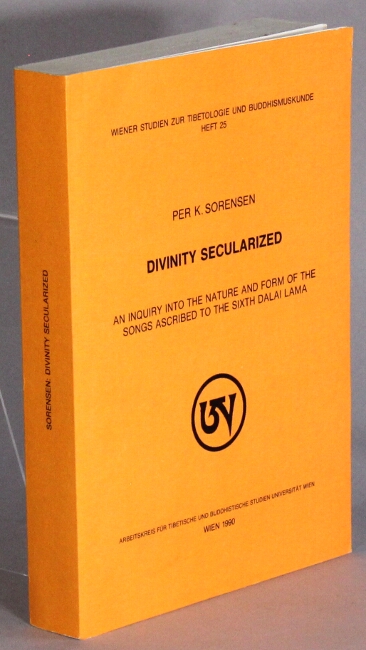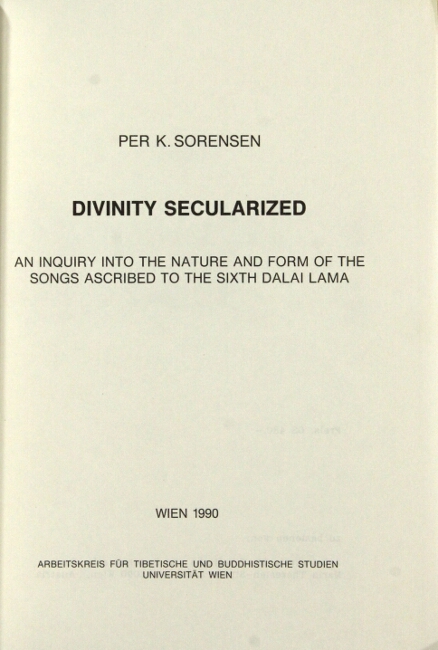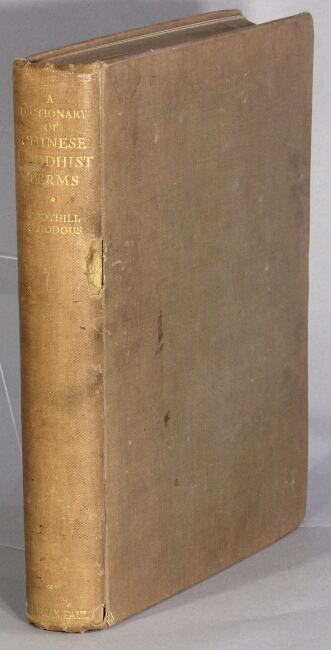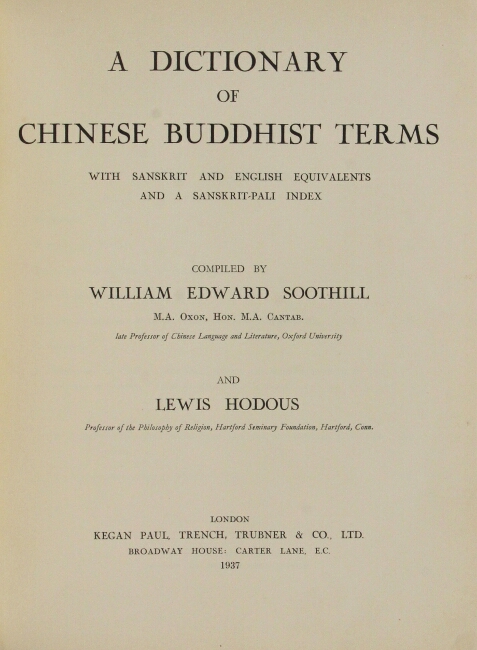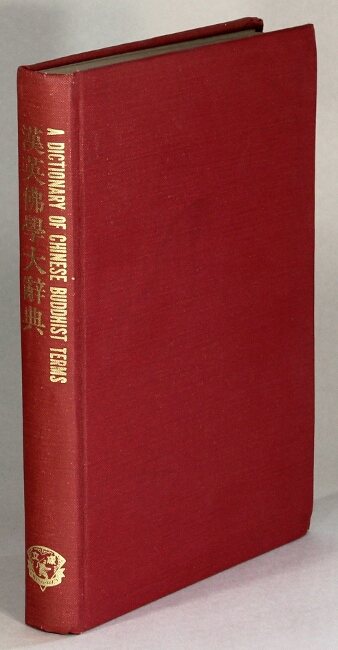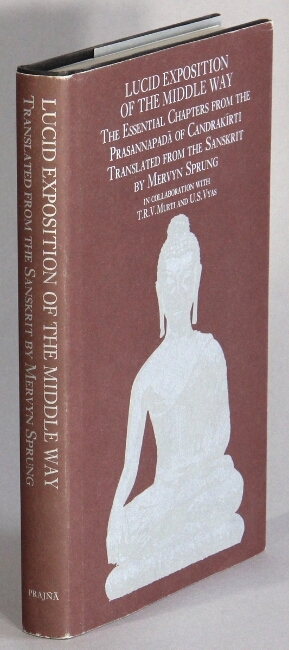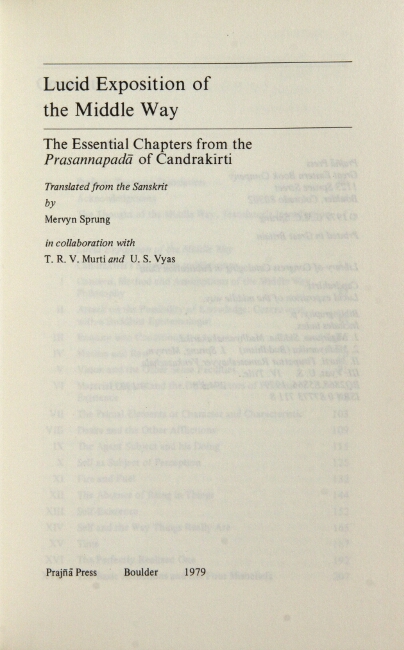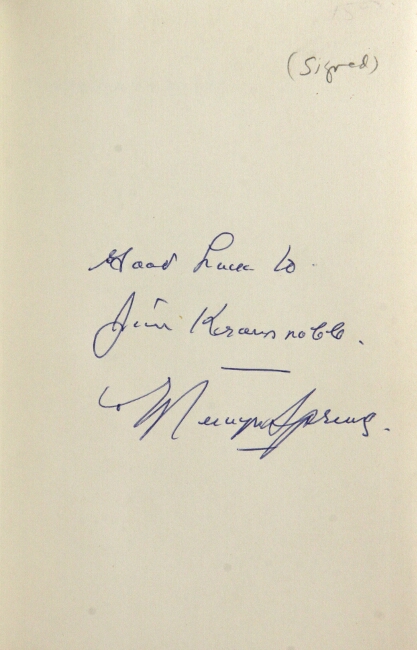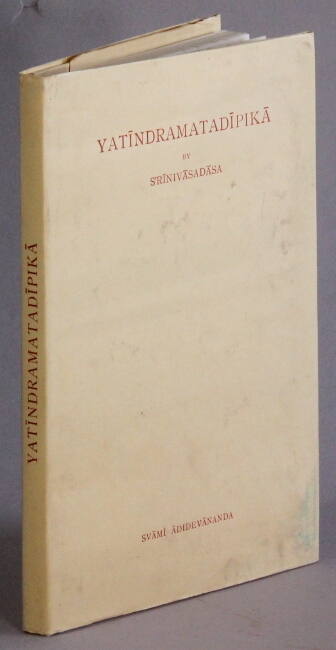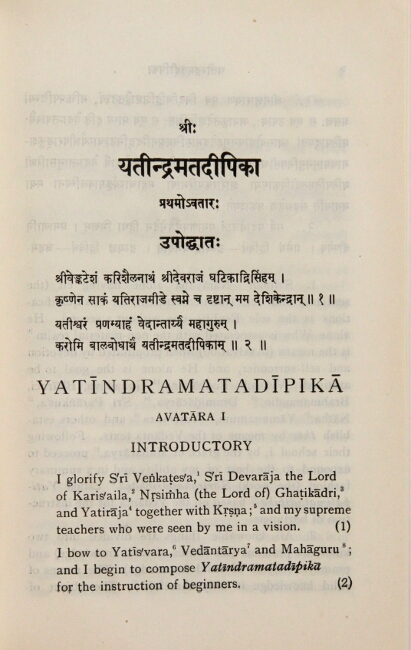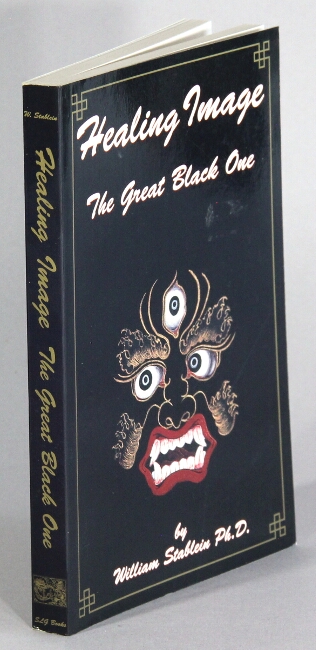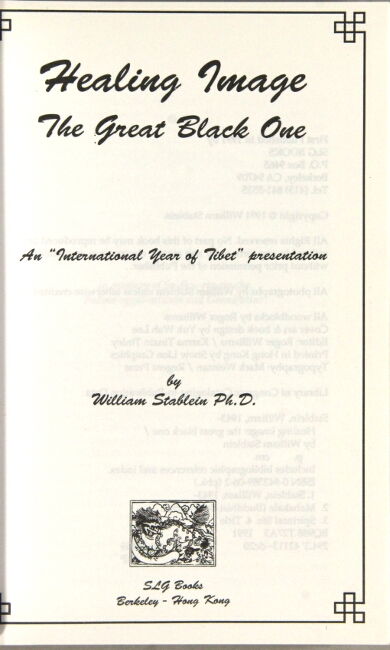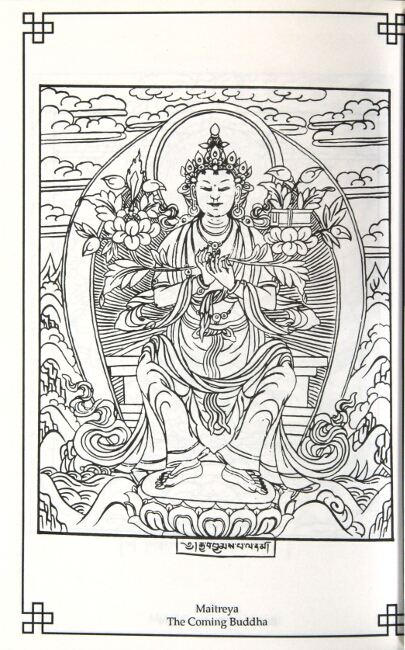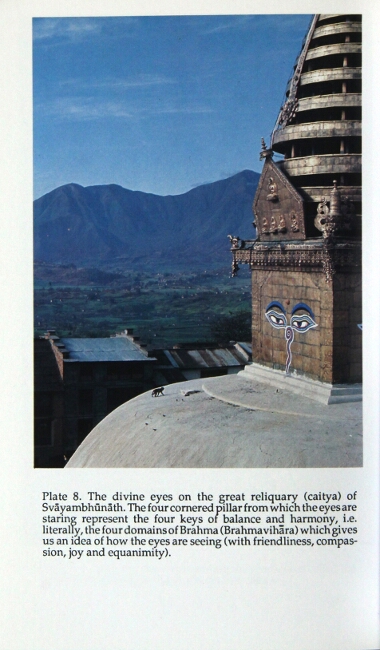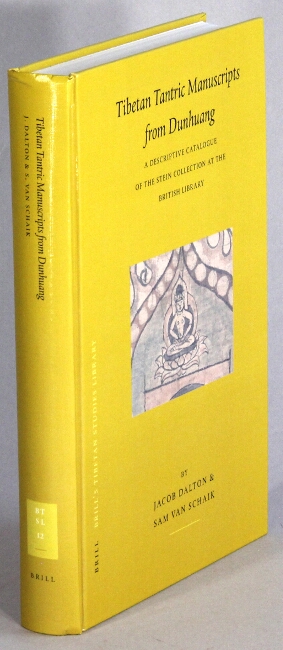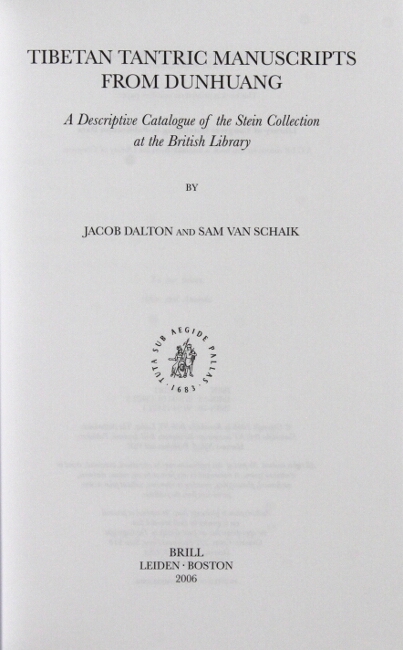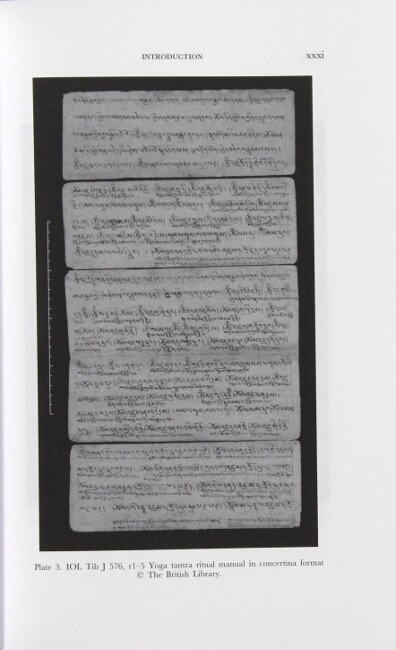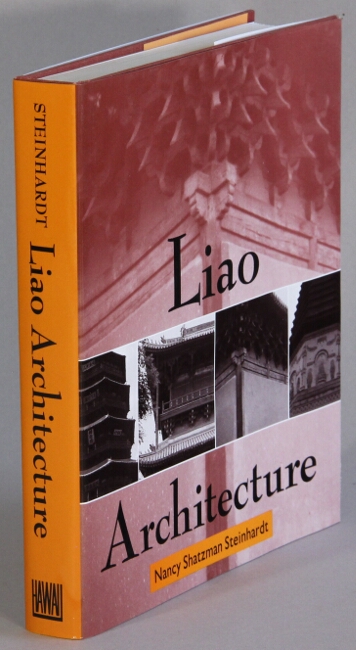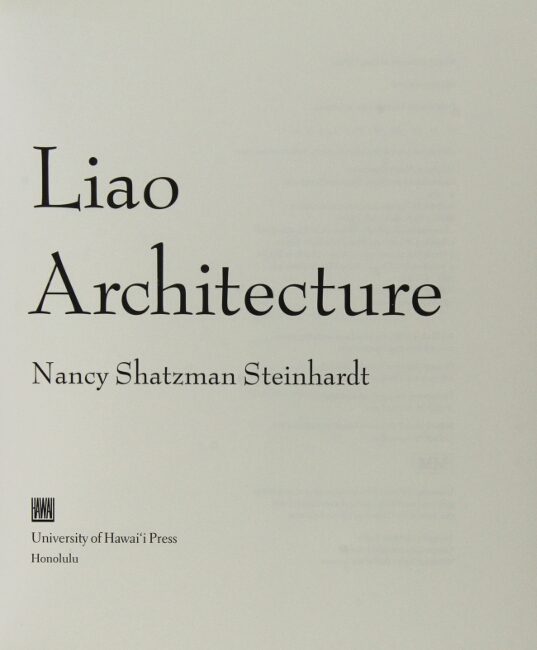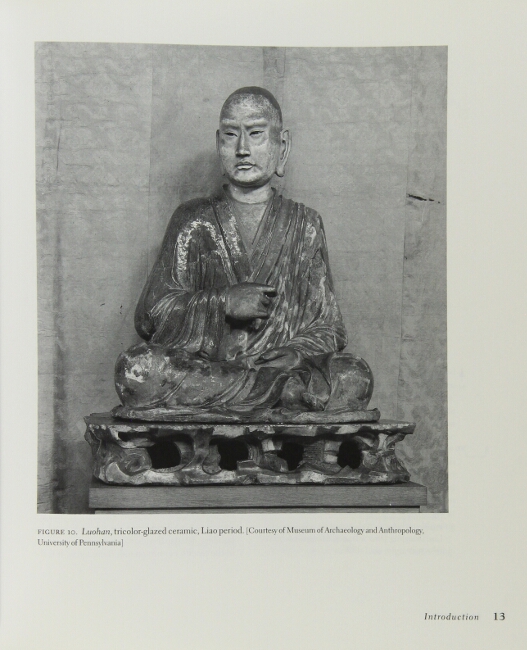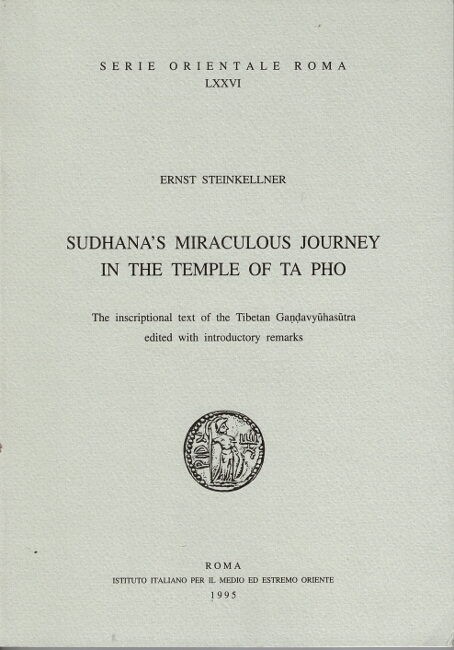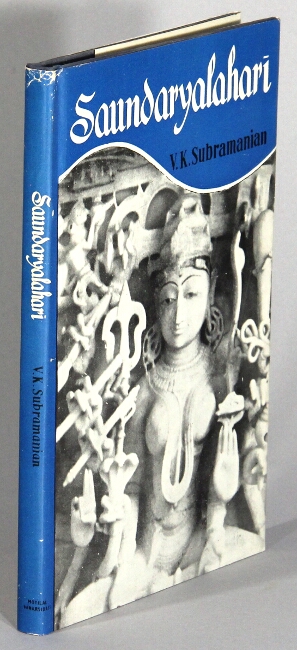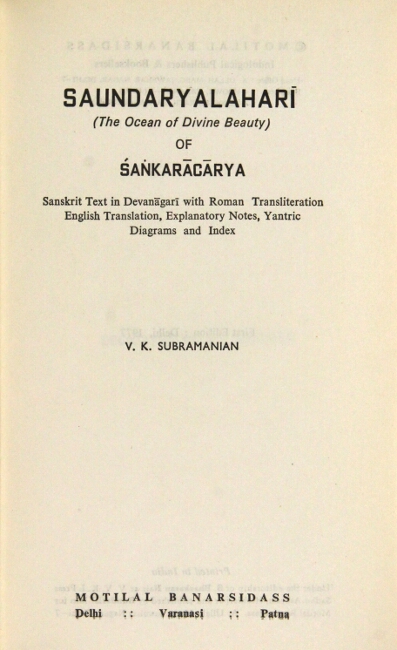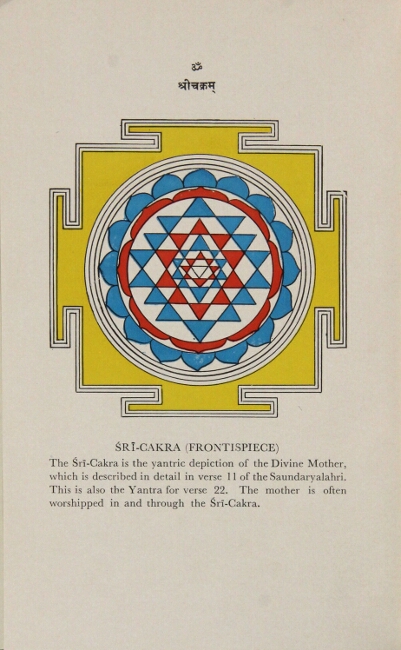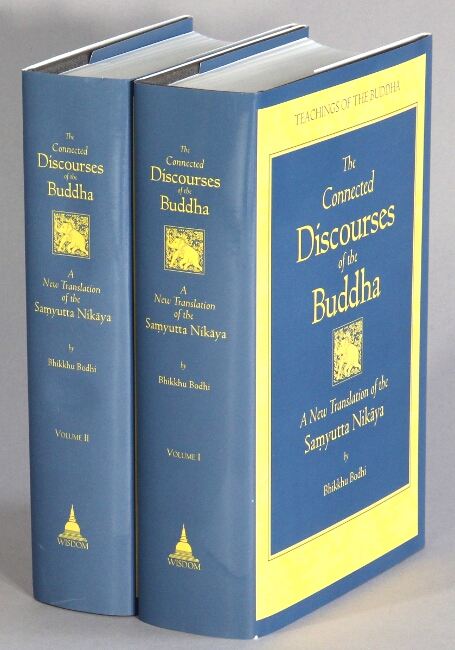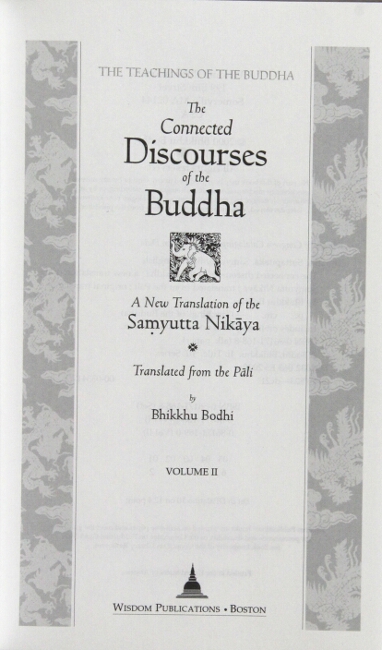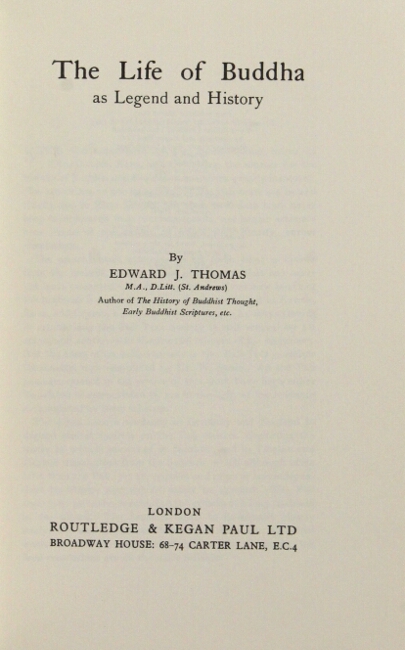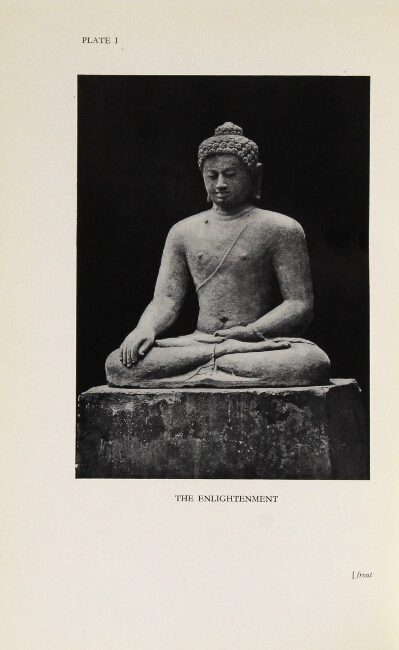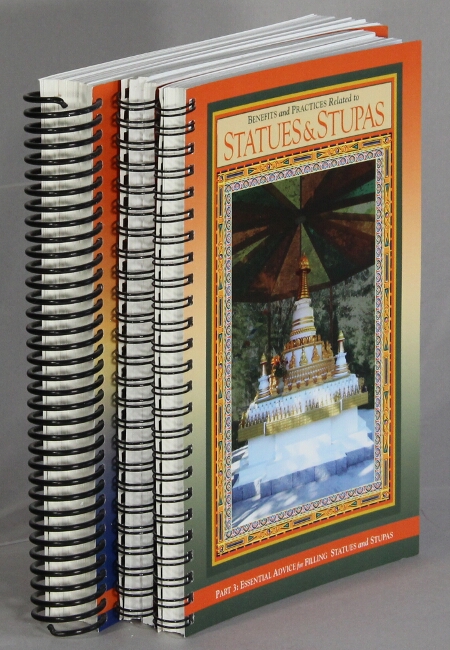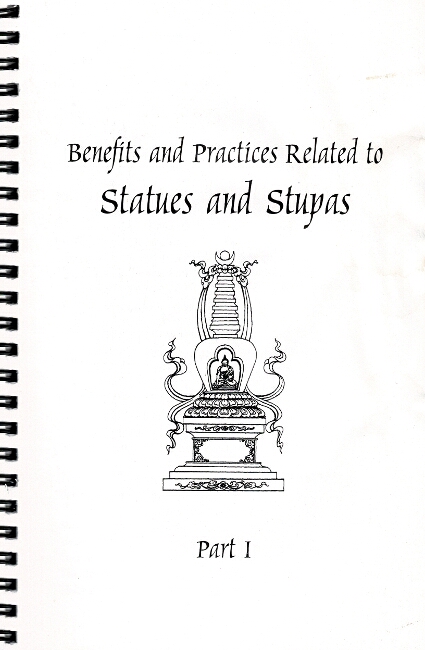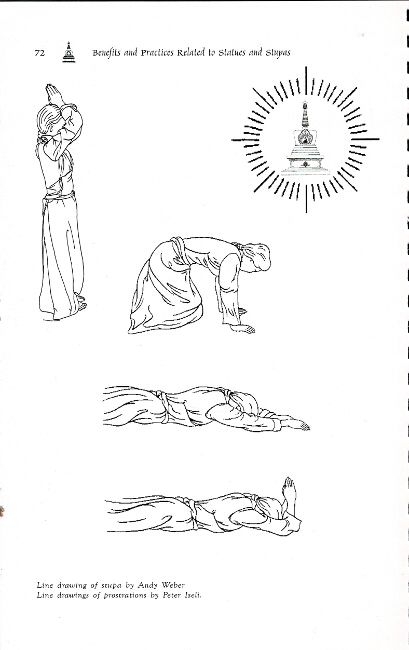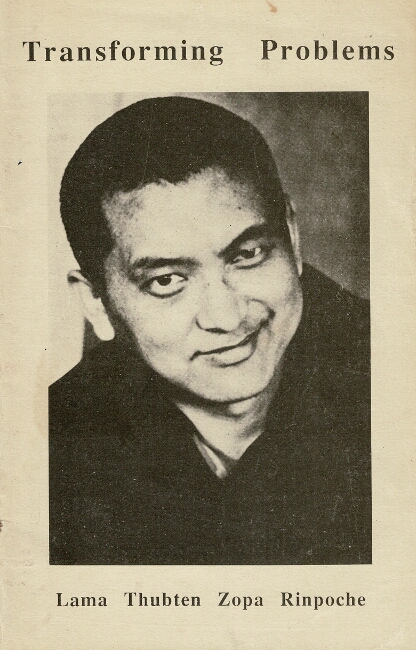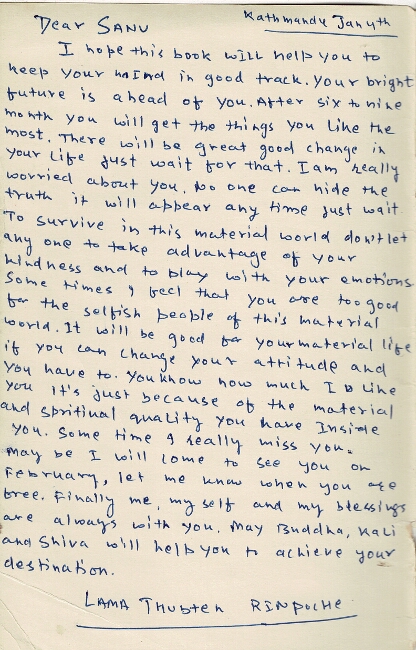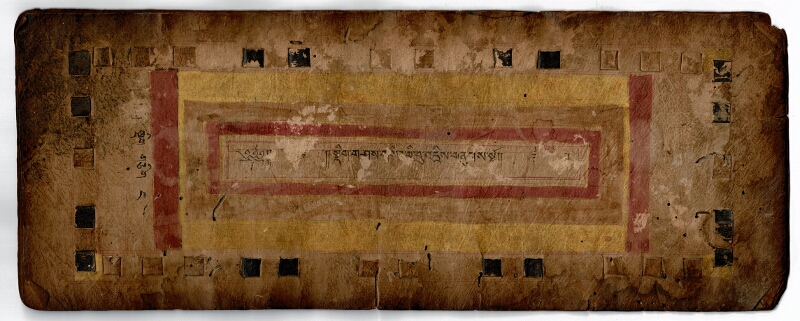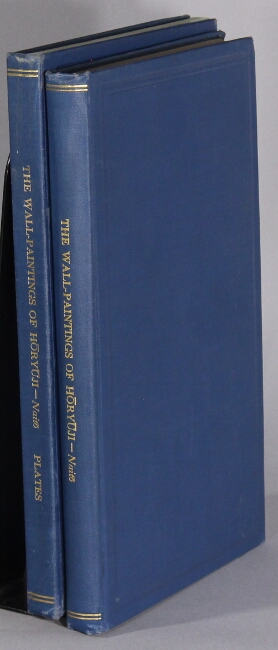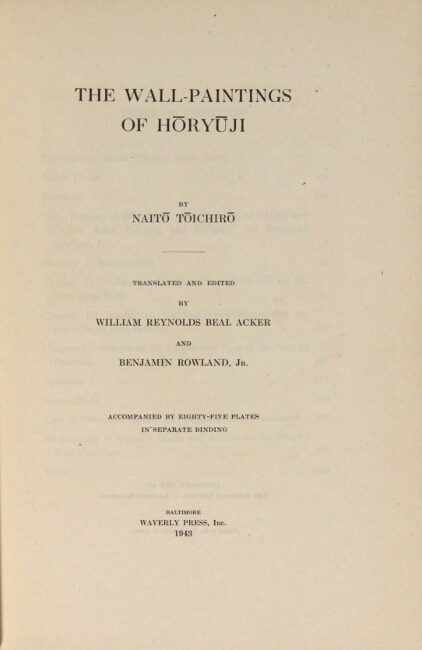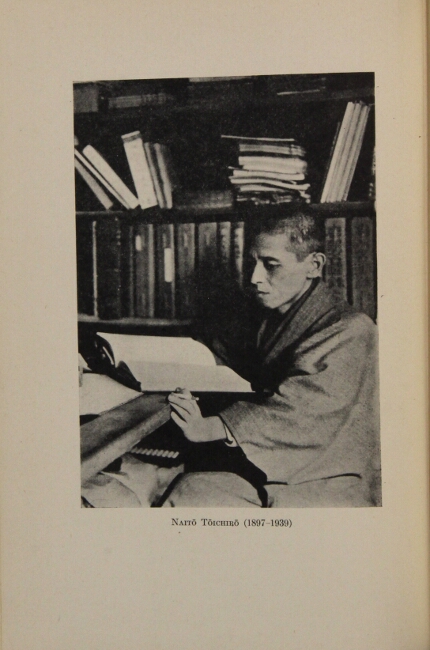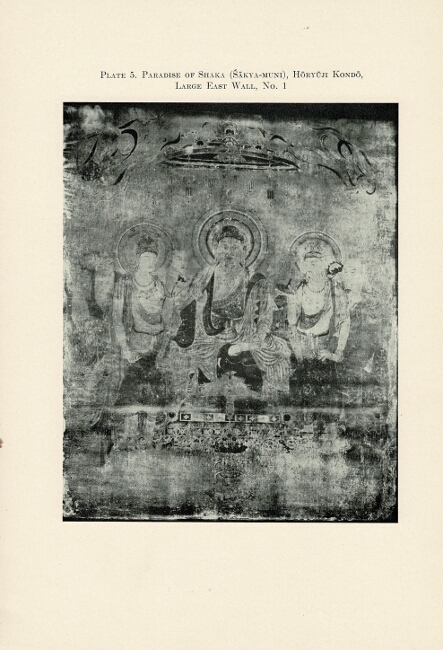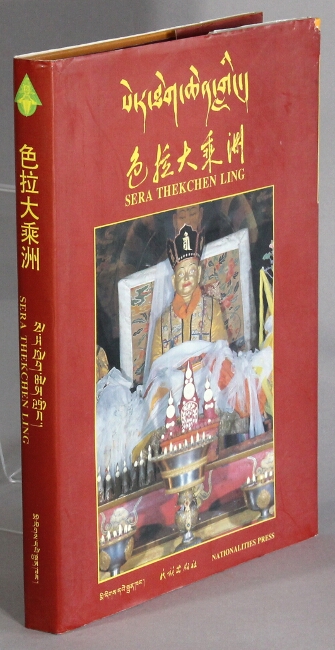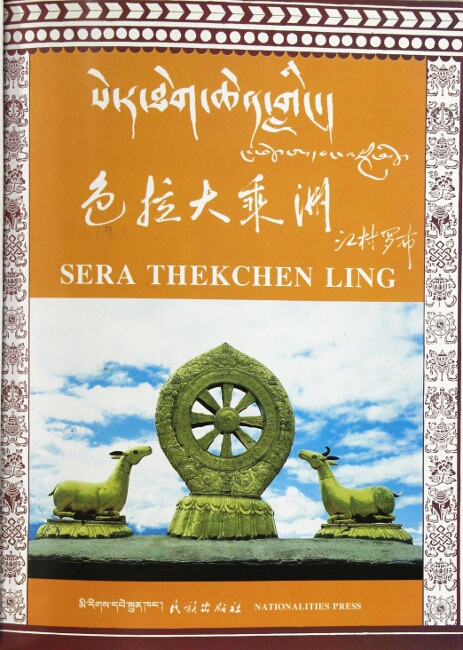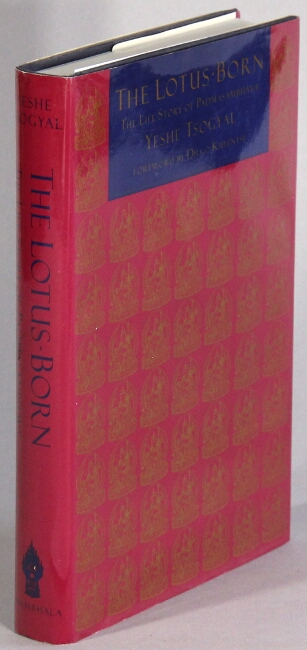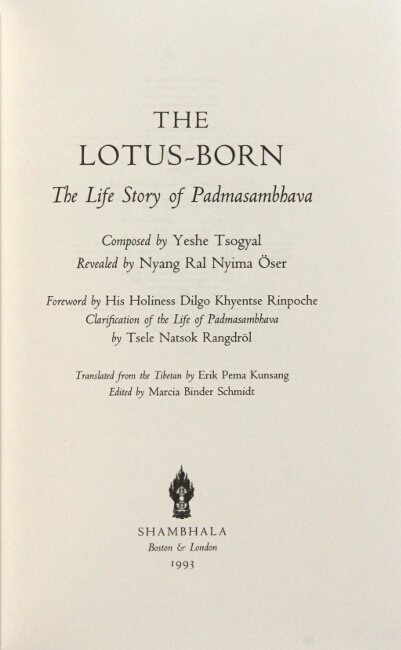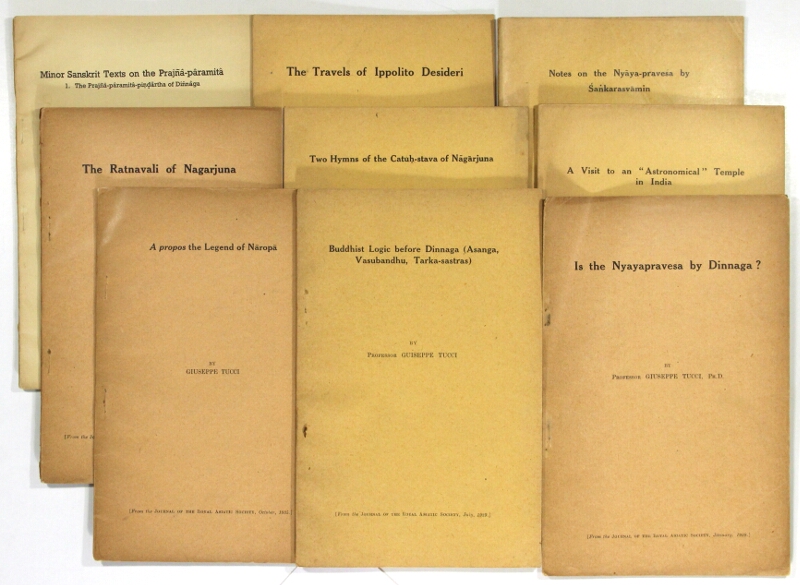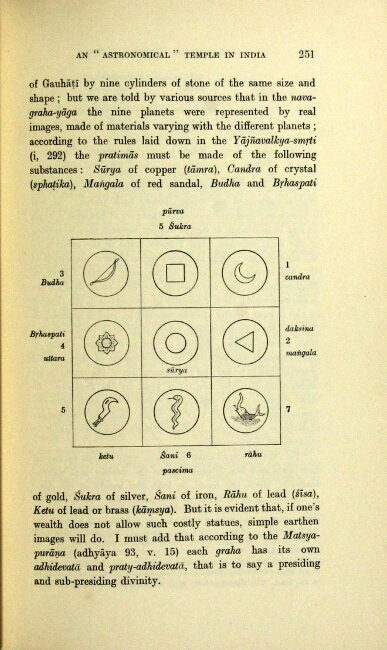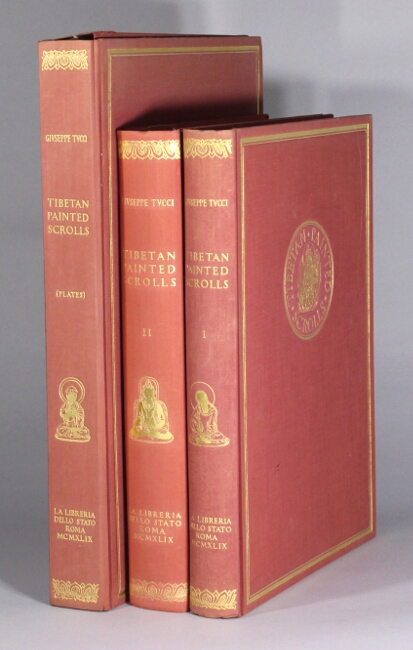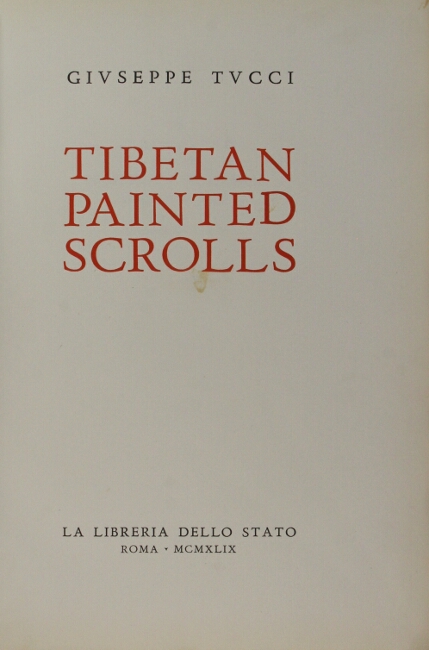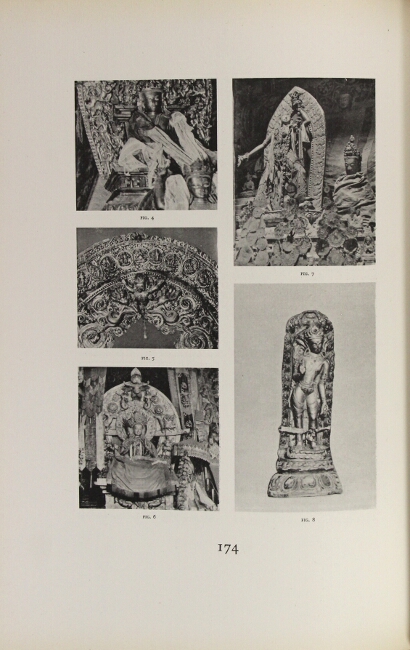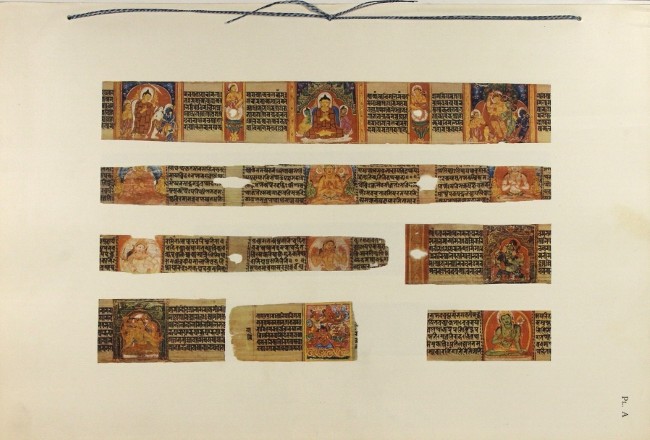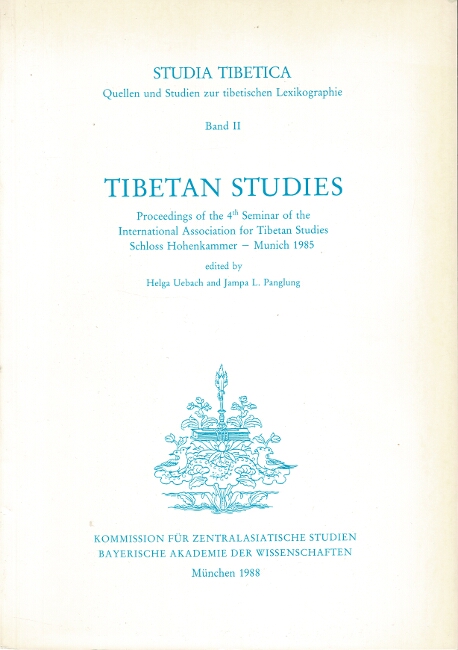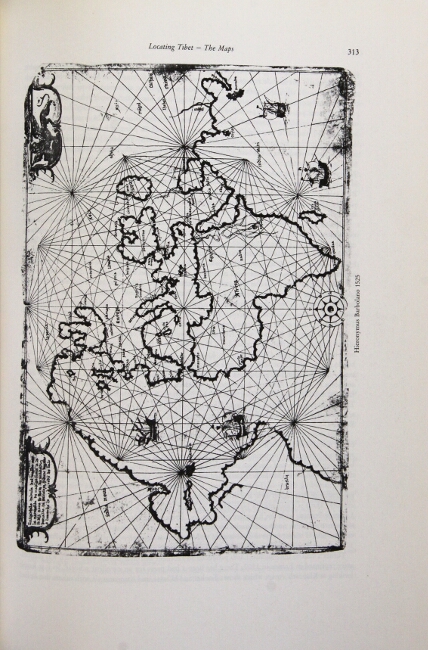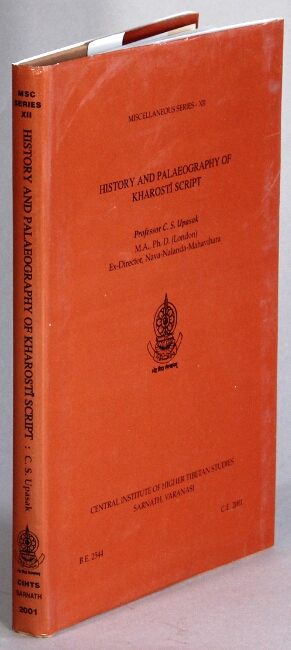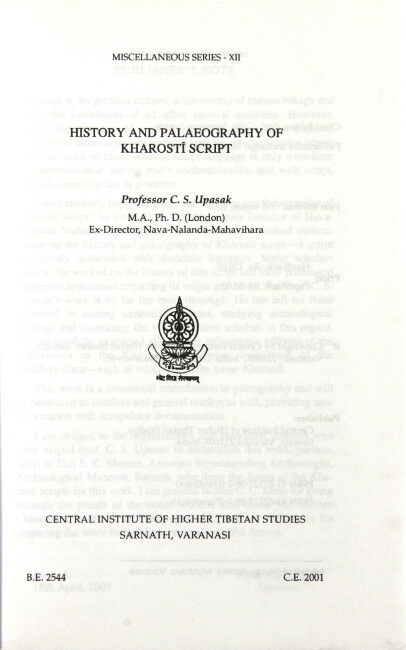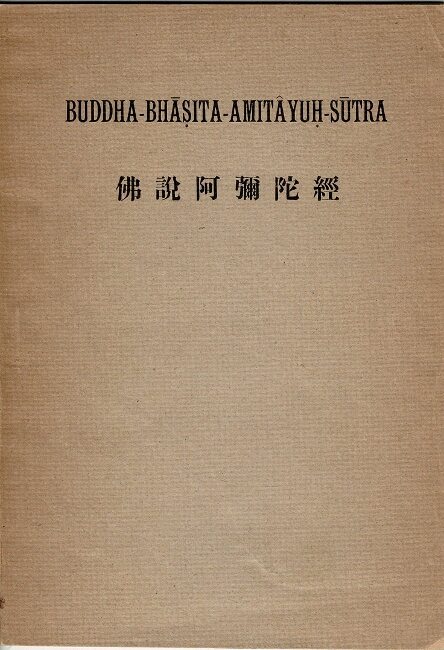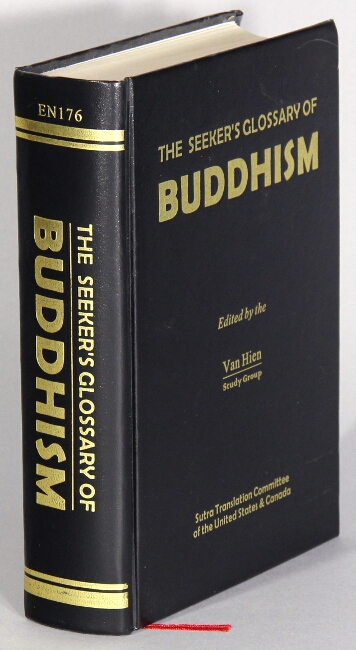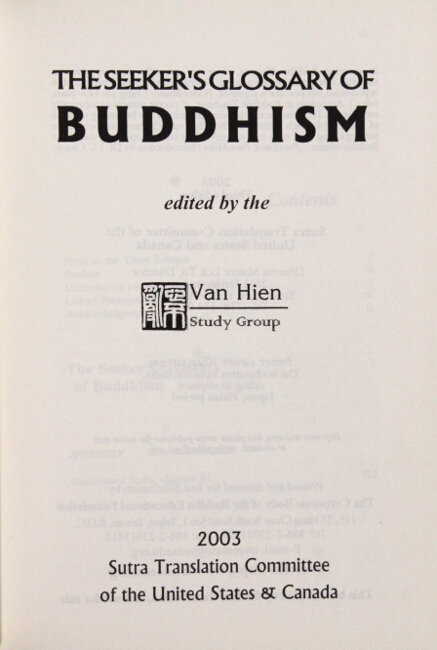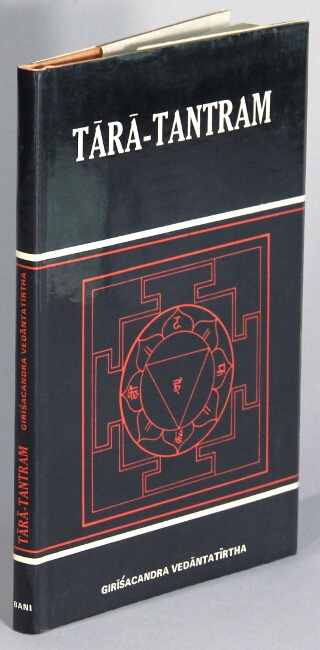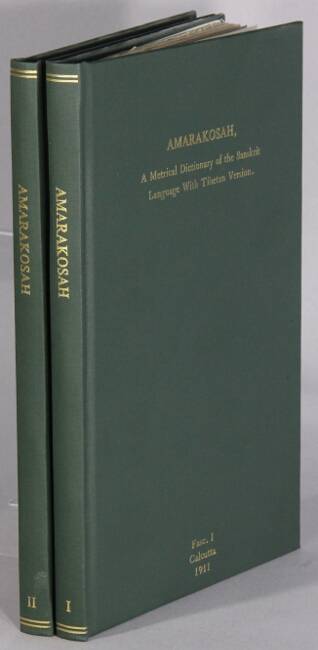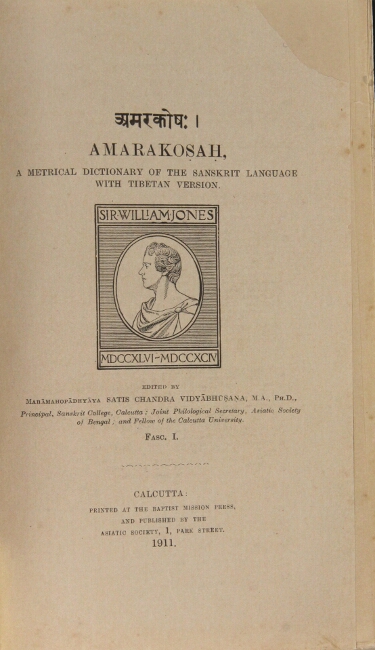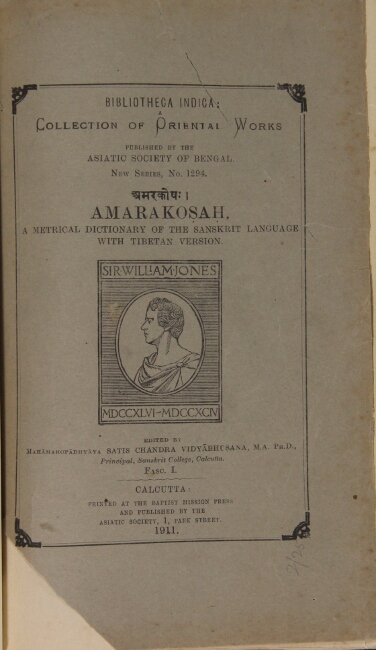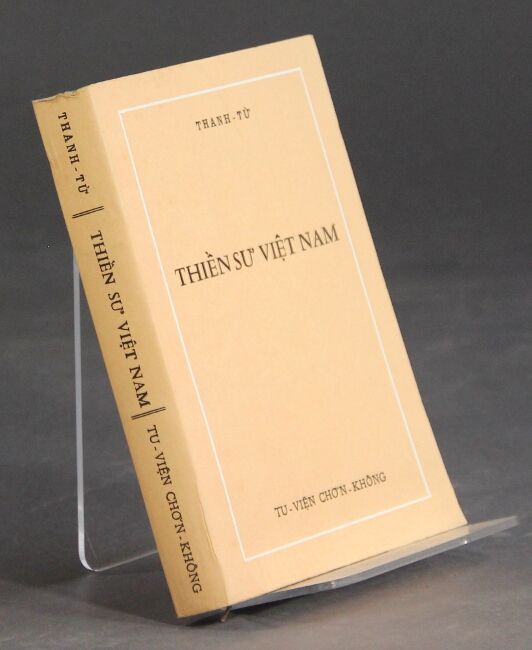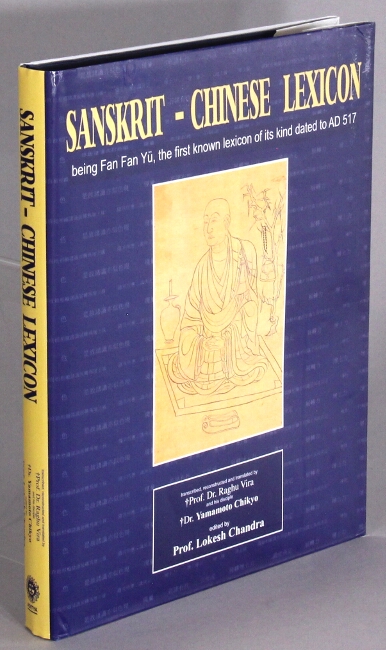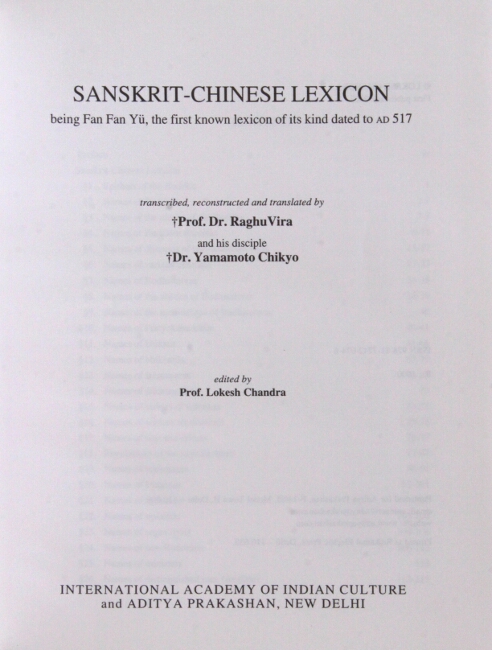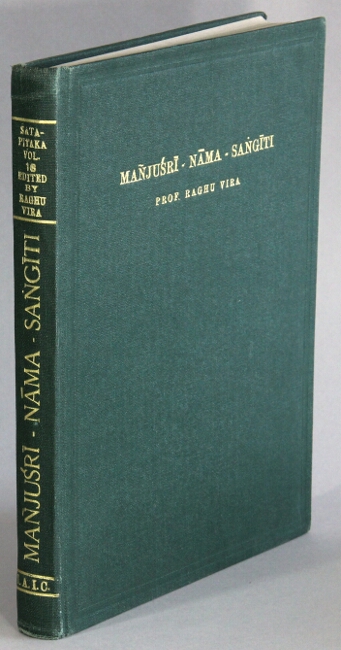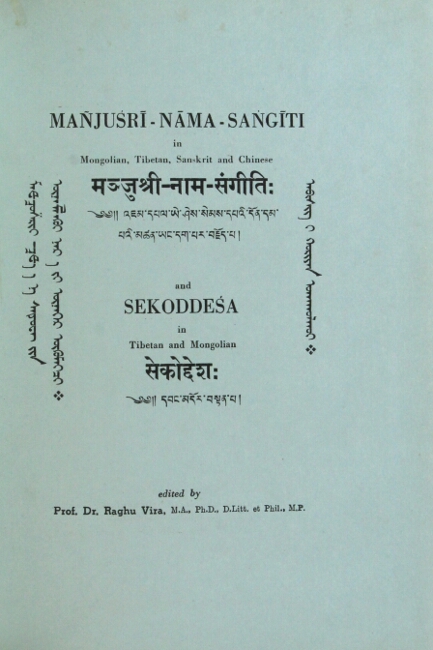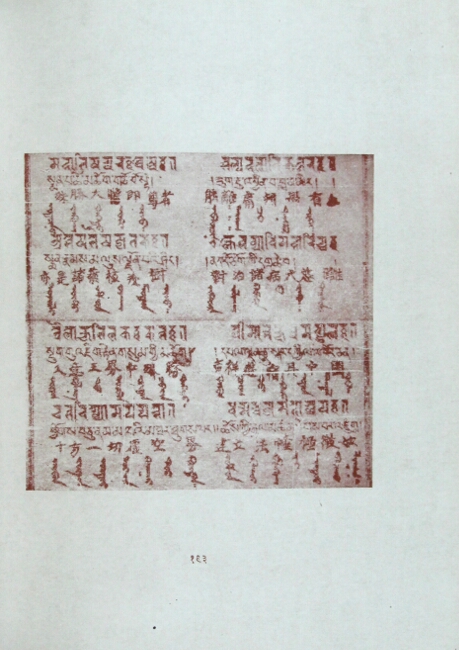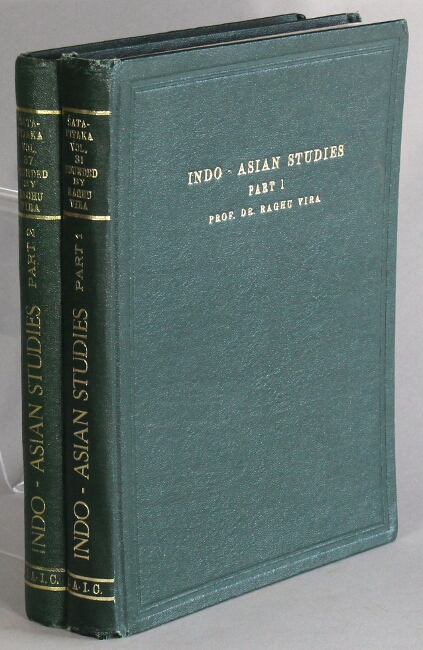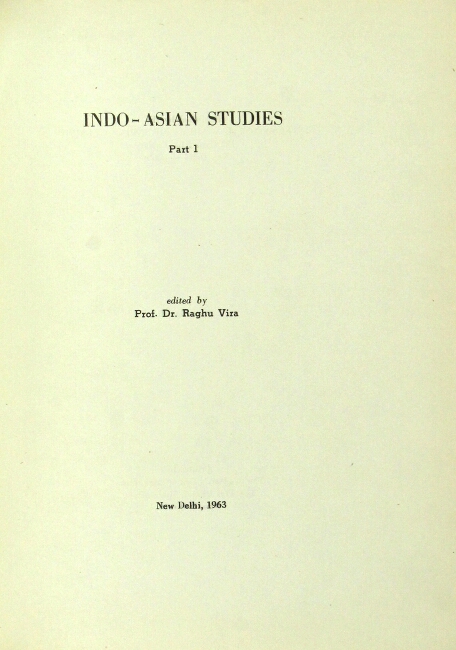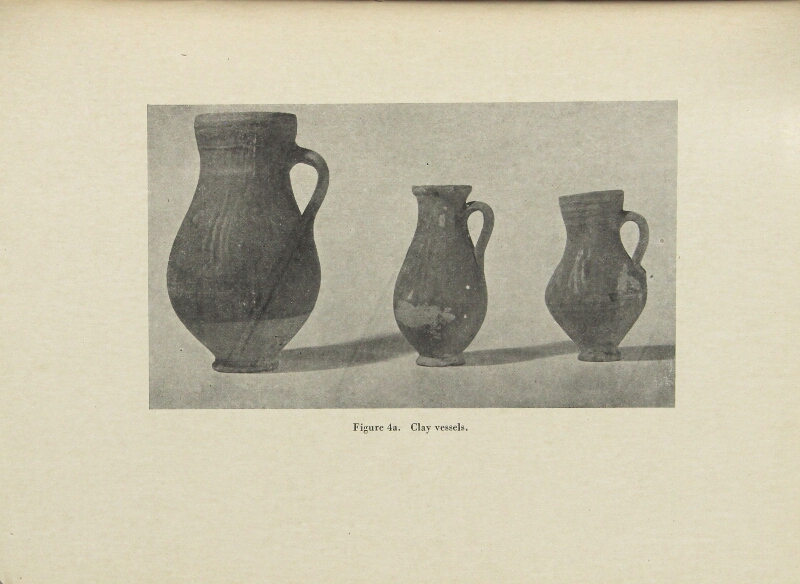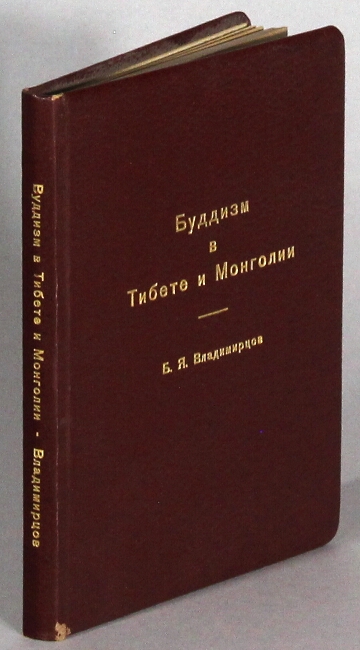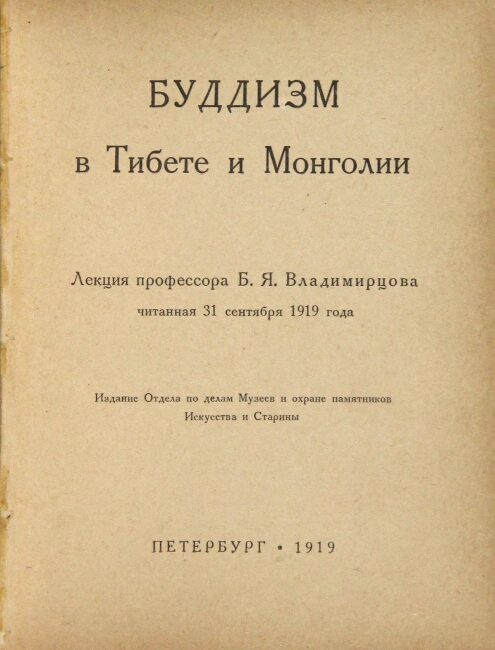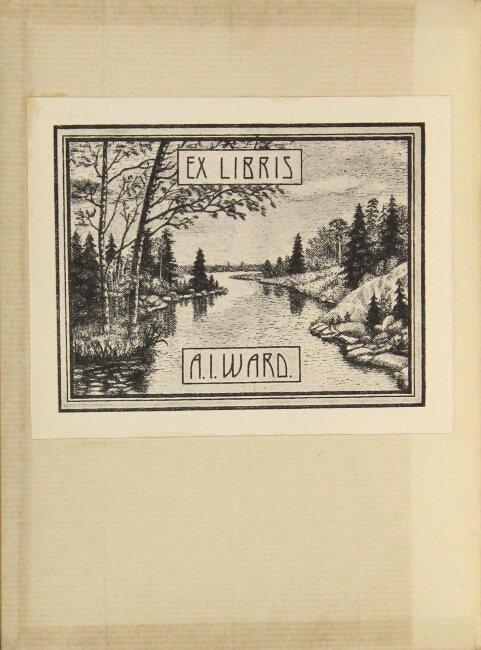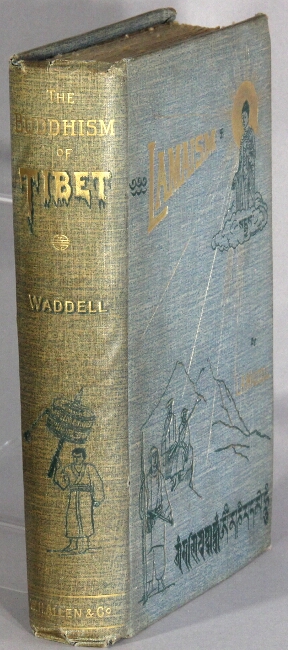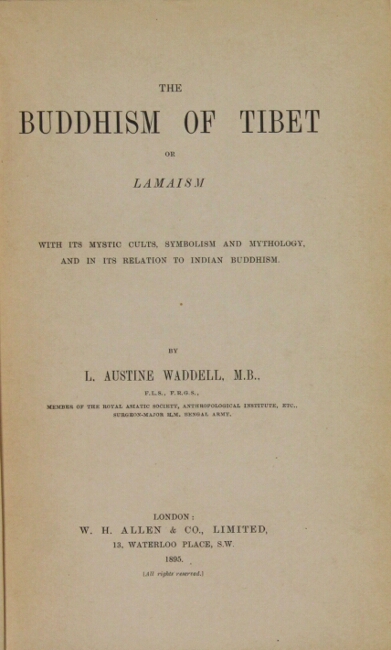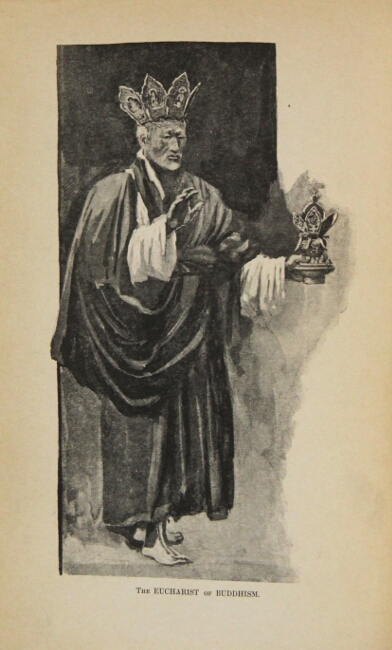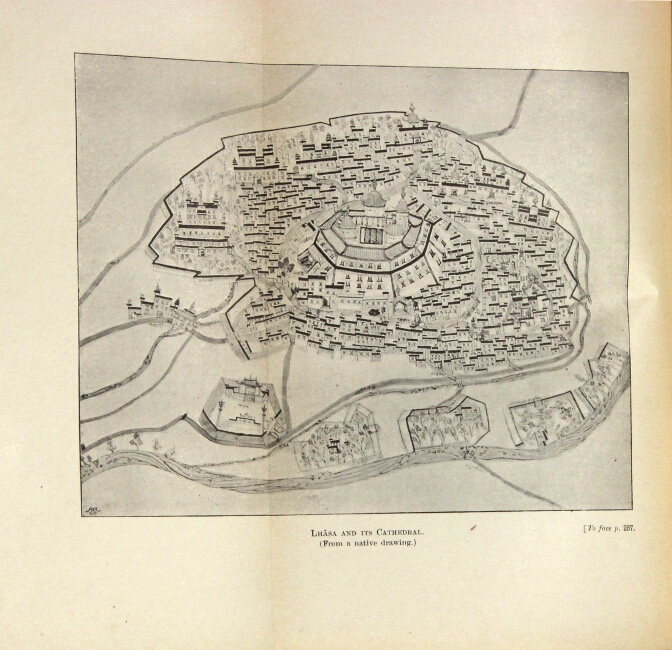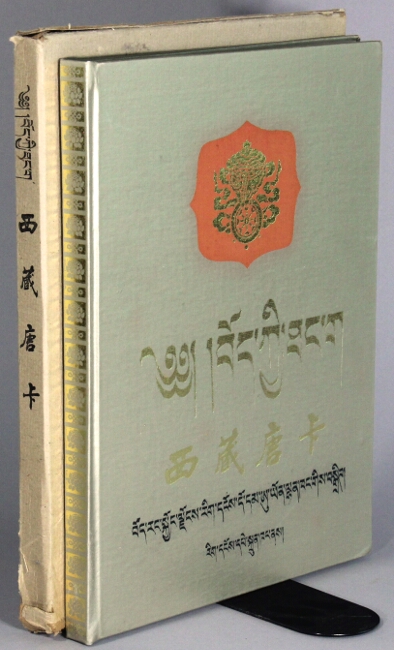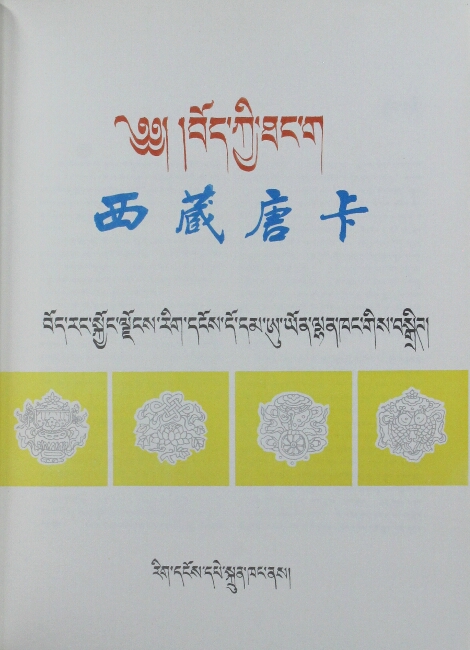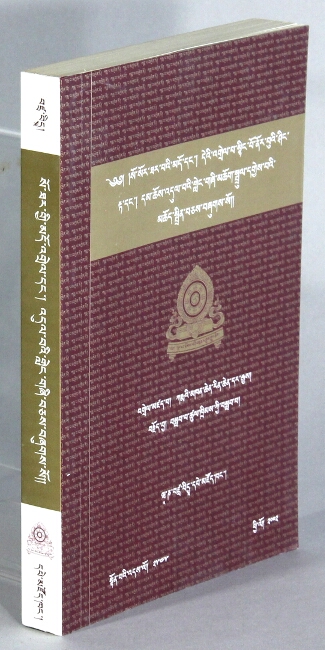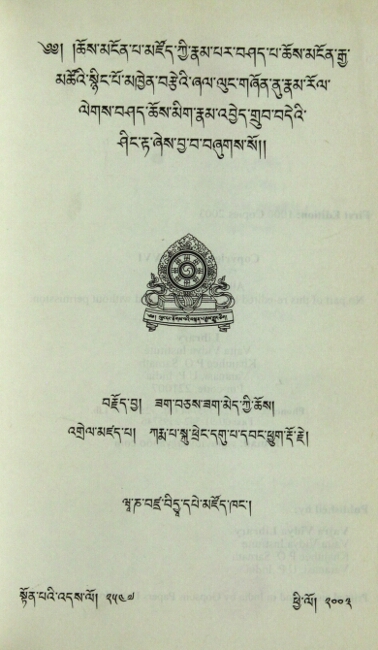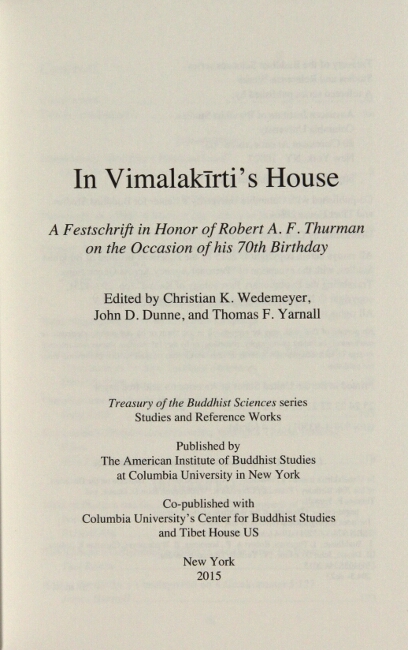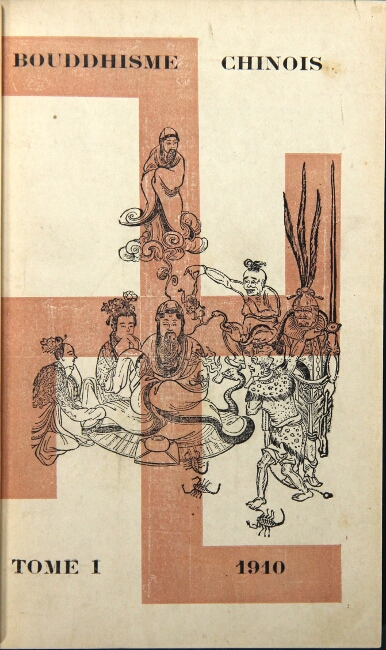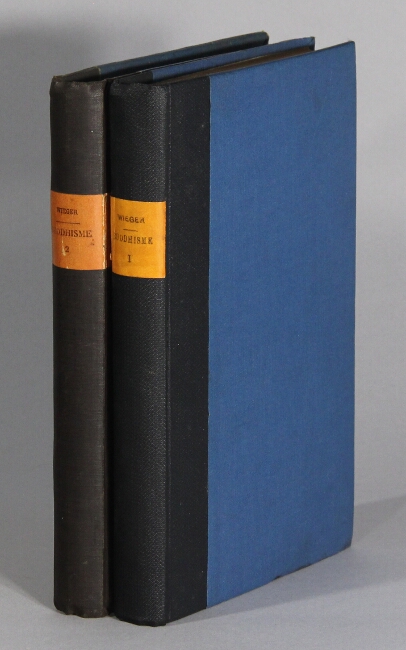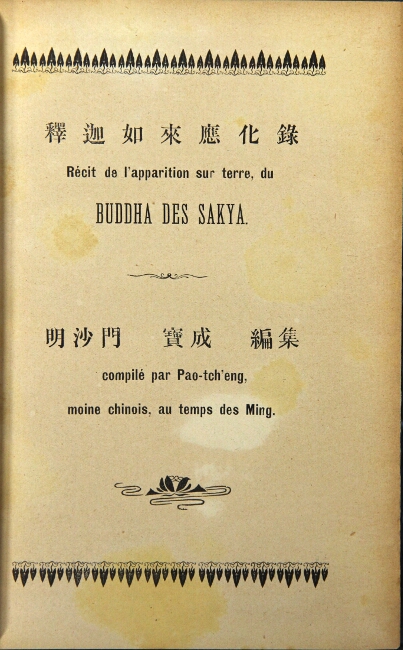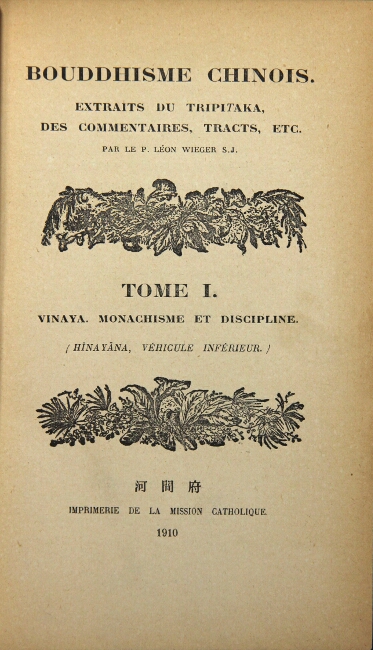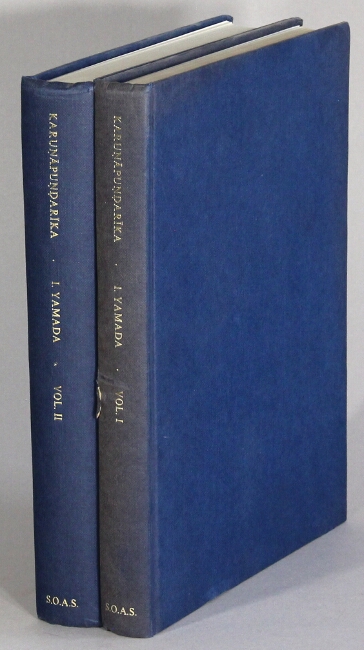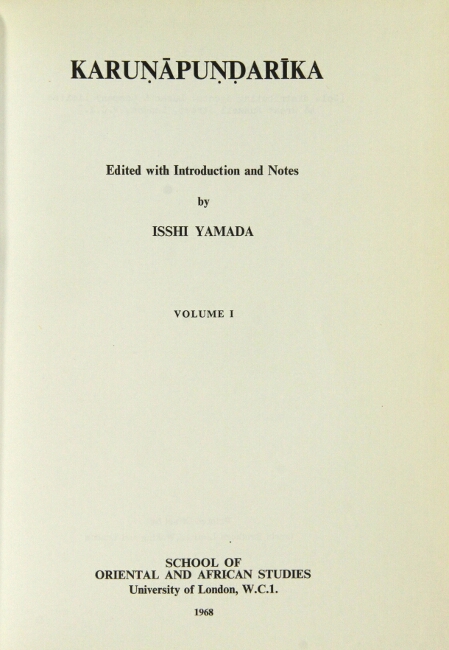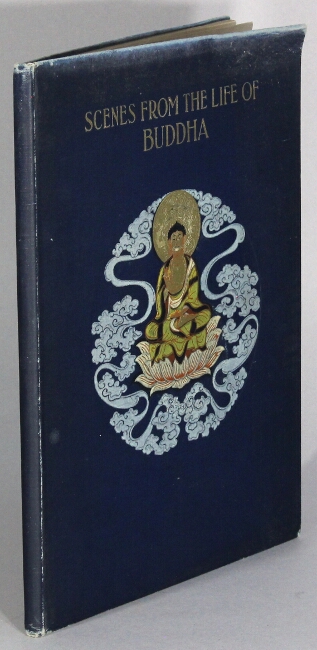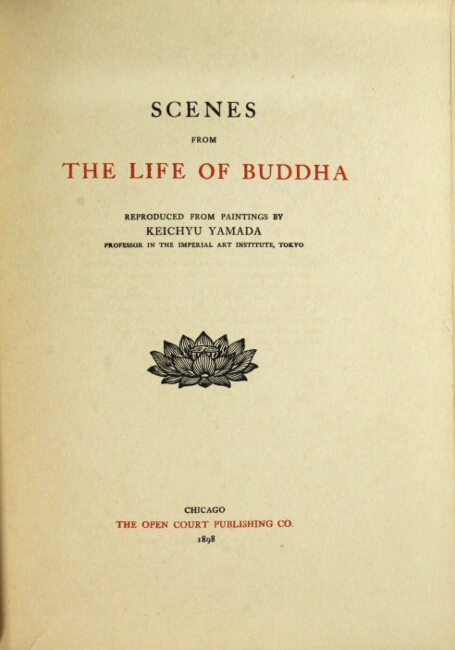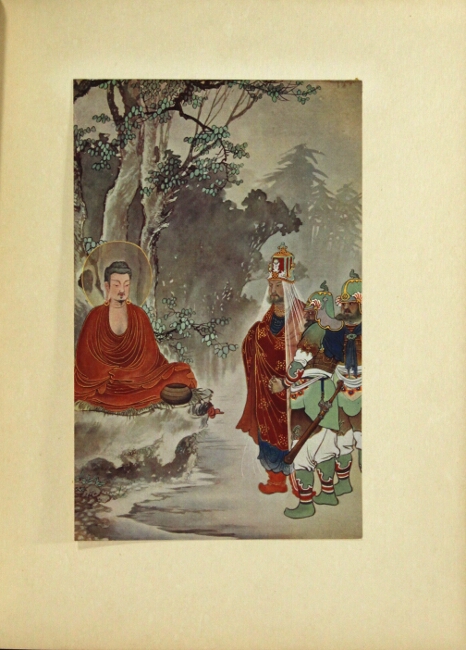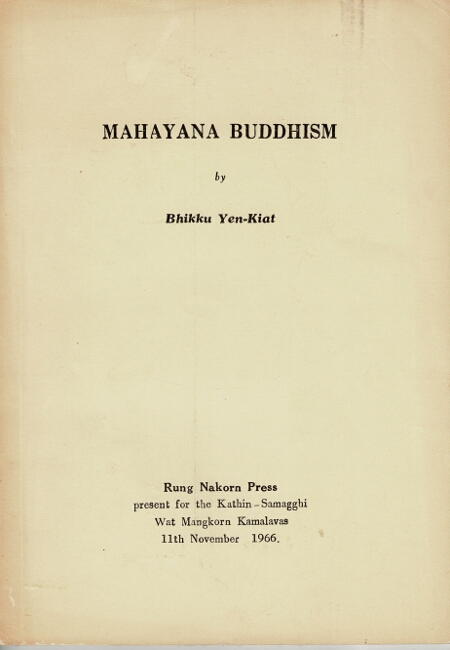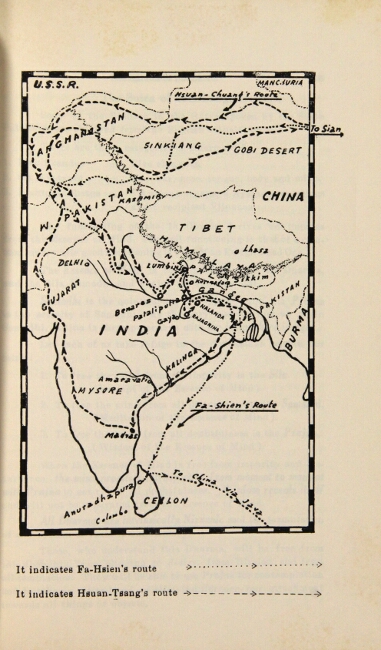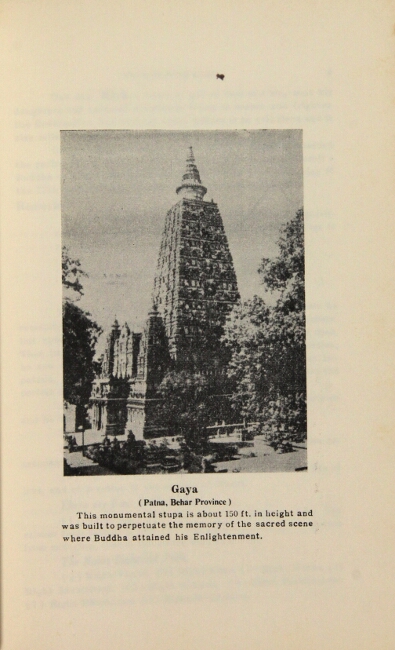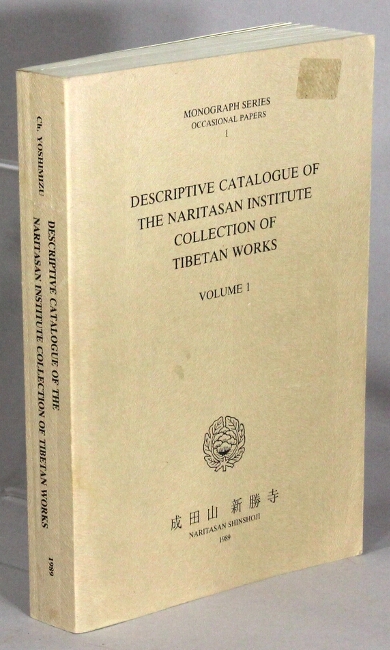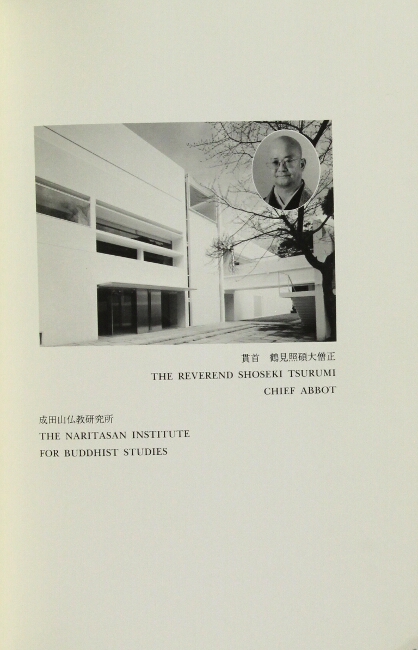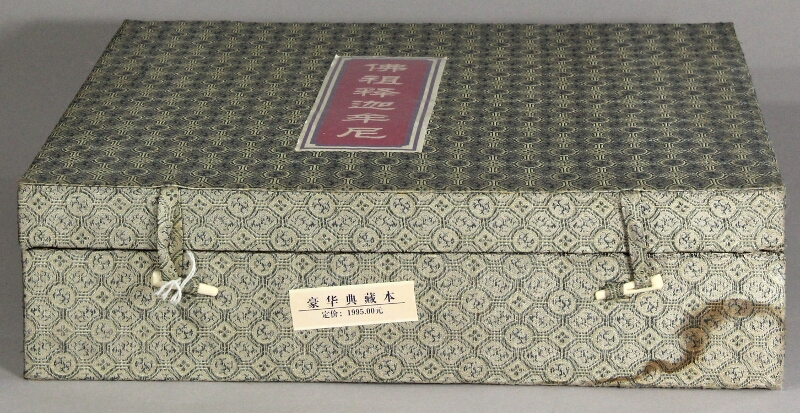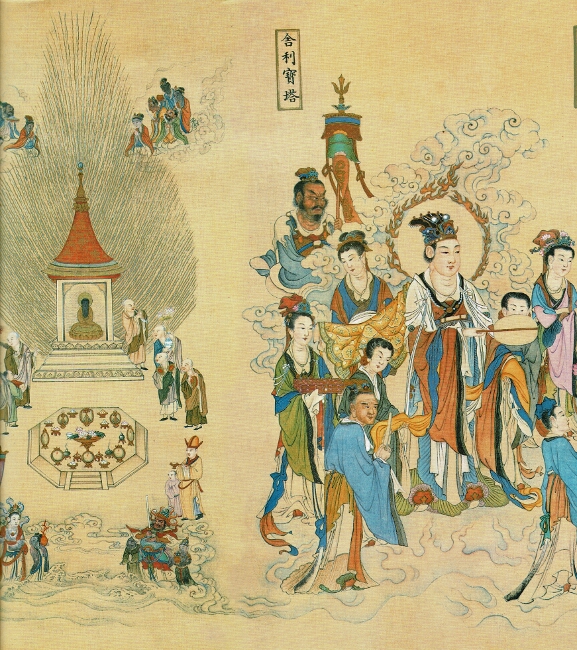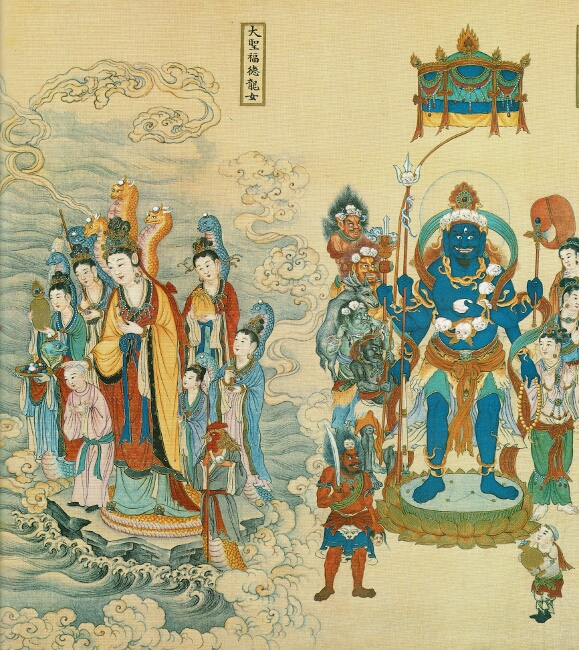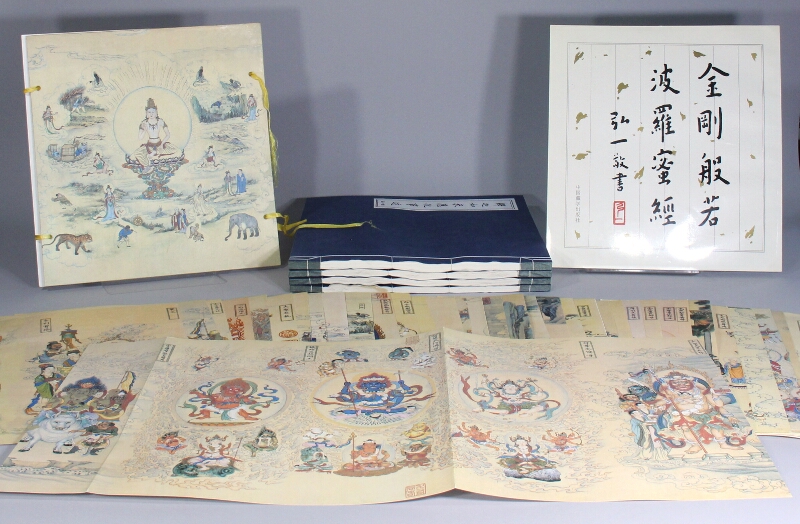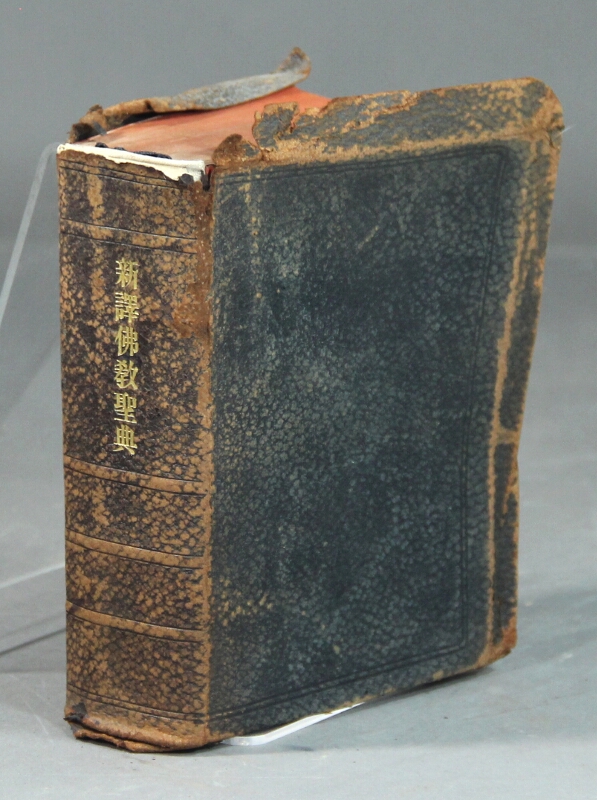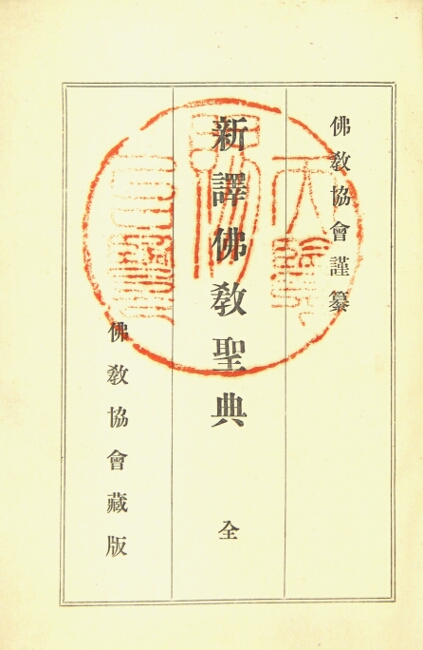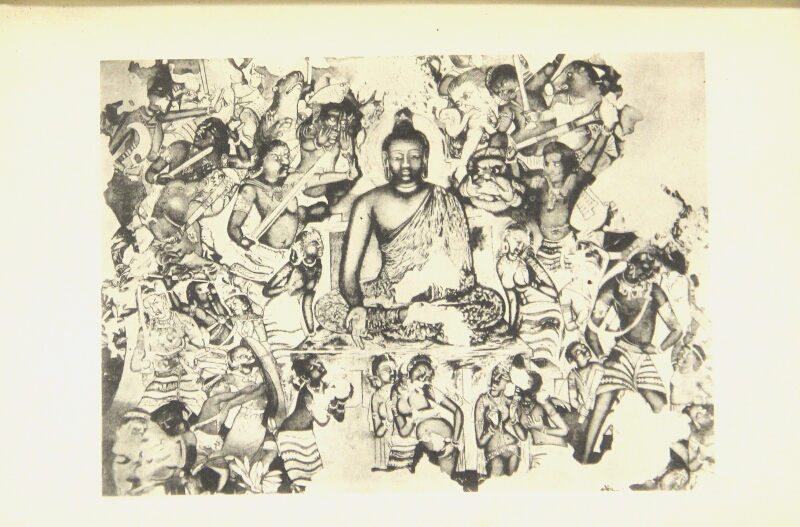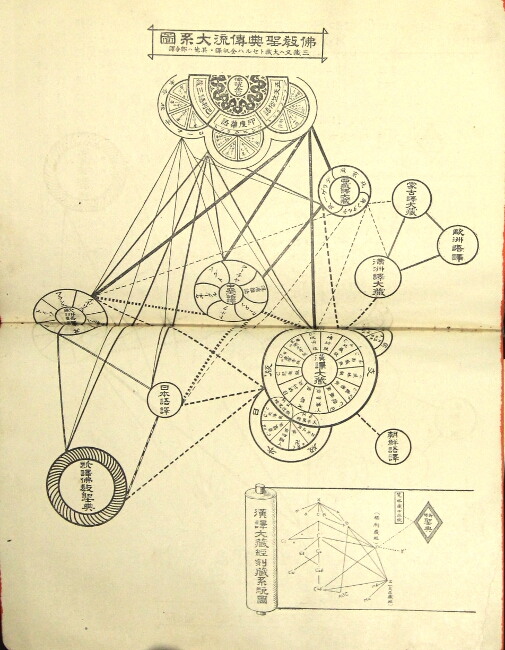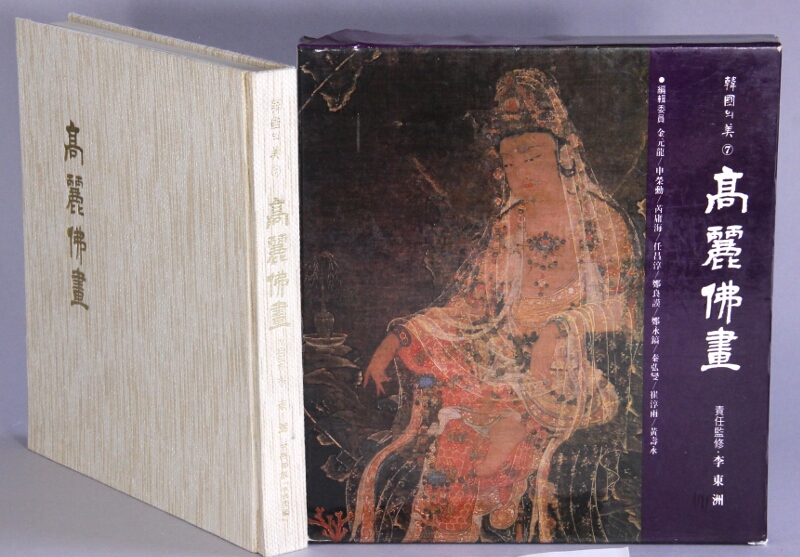101. Meishu and his teachings / 明主の御教え. [Honolulu]: Sekai Kyusei Kyo, [ca 1965].
$75
8vo, pp. [8], 90, 100, [8]; parallel text in English and Japanese; original burgundy buckram, gilt title on upper cover; touch of rubbing to corners, someone has added -sama to every instance of Meishu's name in the English text, else fine.
Sekai Kyusei Kyo is a Japanese New Religion, founded by Meishu 1931 after receiving a divine revelation by the goddess Kannon. Like many Japanese New Religions, it incorporates elements of Shinto, Buddhism, and Christianity in its teachings. It focuses on spiritual healing, organic farming, and creating paradise on earth through the cultivation of natural beauty.
No copies in OCLC.

102. ཤེས་རབ་ཀྱི་ཕ་རོལ་ཏུ་ཕྱིན་པའི་མན་ངག་གི་བསྟན་བཅོས་མངོན་པར་རྟོགས་པའི་རྒྱན་གྱི་འགྲེལཔ་དོན་གསའ་བཞུགས་སོ། / Ses rab kyi pha rol tu phyin paʼi man nag gi bstan bcos mnon par rtogs paʼi rgyan gyi ʼgrel pa Don gsal bzugs so [= An explanation of the eight categories and seventy topics that form the central theses of Abhisamayalankara]. Varanasi: Vajra Vidya Institute, 2002.
$30
[6], 2, [2]; 282; text illustration; text in Tibetan; red printed paper wrappers; owner's label on lower wrapper, else fine.

103. 望月佛敎大辭典 / Mochizuki Bukkyou daijiten [= The great dictionary of Buddhism]. [Taipei: The Horizon Publishing Co., 1977].
$750
First Taiwanese edition being a facsimile of the 1954 Japanese edition; large 8vo, 10 vols.; text in Japanese; full green cloth, gilt title on spines; fine.
In addition to the five-volume dictionary and two volumes of additional entries, the set includes an index volume, chronology, and volume of plates.
The authoritative dictionary of Buddhism in the Japanese language.

104. Ta Ba Lin. A Tibetan nunnery today ... Foreword by Wong How Man. [Hong Kong]: [Henri Vedtch] Ethnographia, [2005].
$40
First edition, oblong 8vo, pp. 135, [1]; photographically illustrated throughout in color; fine copy in the dust jacket.
"A first-hand account of life and social organization in a Buddhist nunnery of the Gelugpa or "Yellow Hat" sect in the Tibetan borderlands of China. Based on field research and interviews, the book describes the history of the community, its physical premises, population and residence patterns. The authors also describe the motivations for becoming a nun, initiation rituals, community economy and living arrangements. An account is also given of religious and ritual practices at the nunnery" (publisher's blurb).

105. Buddhist sculptures at the Yun Kang Caves. Peiping [i.e., Beijing]: Henry Vetch, 1935.
$500
First edition, large 8vo, pp. 66; original pictorial wrappers bound in; map, frontispiece, 8 mounted color plates, many other illustrations throughout, some full-page; wrappers with some soiling and short tears, text block with several modest creases, p. 51 with soil mark in the margin; all else very good and sound in a later ochre cloth binding lettered in black on upper cover and spine. A bifoliate prospectus for the book is laid in.
"The Yun Kang Caves go back to the dawn of Buddhism in China, when the new religion was introduced by Tartar invaders in the fifth century. The sculptures reveal an ecstasy of religious fervour which gave a great inspiration to the art not only of China but of Korea and Japan. Buddha is the theme of all the carvings-the Contemplation of Buddha, the Adoration of Buddha, and the Chronicle of His Life. Forgotten for centuries, the caves are now accessible. Hundreds of art pilgrims from all over the world come to see them every year" (from the prospectus).
Mullikin and Hotchkis, an American and a Scottish artist respectively, met in China and traveled extensively there, including two artistic journeys to the caves at Yungang.

106. Living Buddhism in the Himalayas. Calcutta: Shri Bodhendu Barua, [2001].
$100
First edition, 8vo, pp. xi, [2], 14-195, [3]; fine copy in half red cloth stamped in black on upper cover, with a fine unclipped dust jacket.
OCLC locates 8 copies, only Princeton in the U.S.

107. Anthropological studies in Theravada Buddhism (Cultural report series / Yale University. Graduate School. Southeast Asia Studies). New Haven: Yale University Southeast Asia Studies, [1966].
$35
First edition, 8vo, pp. xii, [2], 223, [13]; printed from typescript; near fine in original green printed wrappers.

108. [Ngawang Lobzang Gyamtso.] Secret visions of the Fifth Dalai Lama. The gold manuscript of in the Fournier Collection. [London]: Serindia Publications, [1988].
$300
Folio, pp. xiv, 246; analysis in English, followed by full color facsimiles of illustrations on 55 plates depicting mandalas, linga, ritual objects, etc., with detailed keys, plus facsimiles of the Tibetan text; full black cloth, gilt title on cover and spine; fine in fine pictorial dust jacket and original slipcase.
The Gold Manuscript is a "detailed narrative catalog of the Fifth Dalai Lama's visionary experiences from the age of six until one year before his death at the age of sixty-five." The manuscript serves not only as important instruction on Extremely Secret Teachings of Tibetan Buddhism, but as a remarkable work of art.

109. Gaṅs ti seʼi dkar cʼag: a Bon-po story of the sacred mountain Ti-se and the Blue Lake Ma-paṅ ... Revised, collated, and completed by Ramon Prats ; excerpts in English translated by Namkhai Norbu and Ramon Prats. Roma: Istituto italiano per il Medio ed Estremo Oriente, 1989.
$50
First edition, 8vo, pp. [7], xxxiv, 130, [2]; fine in original printed gray wrappers. Issued as volume 61 in the publisher's Serie orientale Roma.
Mount Ti-se, in western Tibet, is the place "where Milarepa lived and practiced according to Buddhists who call the mountain Gang Rinpoche, Precious Snow Mountain. And according to the Bönpos, it is Mount Tisé, sacred dwelling place of deities, the place where Buddha Tönpa Shenrap Miwoché taught and meditated, and where many sages after him, such as the great lama Drenpa Namkha, Choza Bönmo and Lishu Taring, practiced the teachings of the Yungdrung Bön" (ravencypresswood.com).
Milarepa was a a Tibetan siddha (one who has achieved enlightenment), "who was famously known as a murderer when he was a young man, before turning to Buddhism and becoming a highly accomplished Buddhist disciple. He is generally considered one of Tibet's most famous yogis and spiritual poets, whose teachings are known among several schools of Tibetan Buddhism" (Wikipedia).

110. Thar rgyan sgom rim dang dogs gcod, blo sbyong don bdun maʼi ʼgrel ba bcas / [= The Tharpa Rinpoche's Ornament of Meditation and Doubt]. Kathmandu: Khenpo Shedup Tenzen, 2010.
$50
First edition limited to 1,500 copies, 8vo, pp. [10], 387, [1]; text in Tibetan; pictorial paper wrappers; fine.
From OCLC: "Detailed presentation of the Buddhist meditation process of Mahāmudra and commentary on Kongtrul Lodoe Thaye's text Theg pa chen po blo sbyong don bdun maʼi khrid yig blo dman ʼjug bder bkod pa byang chub gzhung lam on Boddhicitta practice." The author, Ogyen Trinley Dorje, is head of the Karma Kagyu school of Tibetan Buddhism, the second largest after the Dalai Lama's own Gelug school.

111. Sketches from Nipal, historical and descriptive, with anecdotes of the court life and wild sports of the country in the time of Maharaja Jang Bahadur, G.C.B. to which is added an essay on Nipalese Buddhism and illus. of religious monuments, architecture, and scenery, from the author's own drawings. London: W. H. Allen, 1880.
$2,000
First edition, 2 volumes, 8vo, pp. viii, 418, [2] ads; [4], 364, 44 (ads), [4] ads; 18 plates (6 chromolithographs) including 2 chromolithograph frontispieces; original green cloth stamped in gilt and black; evidence of something removed from the upper covers (not offensive), some chaffing along the lower joint of volume II; all else very good, clean and reasonably sound.
"Geographical and historical description of Nepal, with notes on Buddhism, festivals, and etc. Dr. Oldfield first went to Kathmandu in 1850 as Residency surgeon, serving in this post until 1863." Oldfield spent over thirty years in India, principally in Nepal. There are few books of this period on the area, and virtually none written with such authority and covering every aspect of the private life, political relations, sport and religion of the country.
Czech (Asia) pp.153-4; Yakushi O36.

112. 佛書解說大辭典 / Bussho kaisetsu daijiten [= Encyclopedia of Buddhist texts]. [Tokyo]: Daitou Shuppansha, [1974-1975].
$450
Large 8vo, 12 (of 15) vols.; text in Japanese; navy and black cloth, gilt decorated spine; all near fine in original glassine dust jackets and original slipcases, the slipcases spotted and slipcase of vol. 12 starting to split.
This is the complete 11 volumes of the revised edition, and the first supplemental volume (A - SO) by Maruyama published a year later. The series continued with a second supplemental volume, a volume of scriptures, and an author index, which are not present here.

113. Sekoddesa. A critical edition of the Tibetan translations with an appendix by Raniero Gnoli on the Sanskrit text. Rome: Instituto Italiano per il Medio ed Estremo Oriente, 1994.
$30
8vo, pp. 151, [1]; English introduction, with Tibetan text in transcription; gray printed paper wrappers, errata slip laid in; fine.
"In Buddhist Tantric literature the Sekoddesa holds a position of considerable interest. "In fact it is the first text of the Kalacakra tradition to have come down to us and contains the nucleus of the doctrine of this religious movement which represents the culmination of medieval Indian Buddhism before its decline."

114. Ladakh studies. [Bristol, UK: International Association for Ladakh Studies, University of Bristol, June 1990 - March 2006.
$175
Nos. 3 thru 20 (18 issues in all), all generally fine in original printed carmine wrappers.
Issues no.1 (1983) and 2 (1985) were issued in Germany and France respectively. It appears the journal folded in 2014 with issue 31.
"Only in the last decade has Ladakh (northwest India, once known as Little Tibet) been readily accessible for study, but in that short time it has been the focus of much attention by students in many disciplines. These have been attracted by the interest of its physical situation at high altitude in the rain-shadow of the geologically active Himalaya; by the natural ecology of this rugged desert and the skillful adaptations of pastoralism and agriculture; by the sociology, history and cultural tradition, especially as a surviving example of Tibetan Buddhism; and by the problems presented by modern development and conservation" (No. 3, p. 2).

115. Folk Buddhist religion: dissenting sects in late traditional China. Cambridge and London: Harvard University Press, 1976.
$40
First edition, 8vo, pp. xi, [1], 295, [5]; fine copy in a very god dust jacket.
"Focusing on the rituals and beliefs of such prominent groups as the White Lotus (which staged the great rebellion of the 18th century), the author describes how many of these sects, although regarded as illegal, developed their own traditions of organization, leadership and scripture, and maintained active congregational life over long periods of time" (jacket blurb).

116. Palm leaf manuscript in Sinhala. [Sri Lanka?: ca. late 1800s].
$175
Buddhist manuscript of uncertain completeness, 2.5 x 23 in., 26 leaves, each page consisting of 7 or 8 lines of text; painted wooden covers; boards rubbed, binding string perished, some edgewear affecting text, good. From the James J. Hill Library.
Palm leaf manuscripts were the standard form of book in South East Asia for most of its history up until modern times. Palm leaves as straightened, dried, etched, and ink is rubbed into the etching to produce the text. The subject of this manuscript is religious, though we were unable to source the text.

117. The real essence of Tantra. Bombay: Yogi Divine Society, 1978.
$65
First edition, 8vo, xix, [1], 233, [3]; 3 color pates showing 4 portraits and 2 illustrations; several illustrations in the text; fine copy in a fine dust jacket.
"A landmark in the workings of Tantric Systems [which] will inspire many advanced Sadhakas to realize the importance of the spiritual path. The presence of Ultimate Reality has been brought nearer to the genuine truth seekers of various categories, e.g. (a) For the laymen it is extremely useful for solving their family and complicated life problems. (b) To the advanced Sadhakas it inspires deep study and learning in a loving atmosphere under Gunatit Swaroop's guidance. (c) To the Tantric Masters, it is essential for the 'Ultimate Experience-Whole'. (d) To genuine truth seekers for bliss, liberation and Brahmi-Sthiti in this life and in this world. (e) Tantric Tradition has been completely revived and revolutionised on a new fundamental basis on the principle of Gita's Akshar-Purushottam Yoga with a continuity of the 'Satpurush from Original Spiritual Disciplic Succession' or 'Shuddha Tattva' or 'Suddha Guruparampara'" (jacket blurb).

118. Aryabhadracaripranidhanaraja / Phags pa pzan po spyod pa'i smon lam gyi rgyal po / [= Commentary on Samantabhadra's Aspiration to Good Actions] with introduction and notes.. Gangtok, Sikkim: Namgyal Institute of Tibetology, 1973.
$150
Second reprint, 8vo, pp. [4], viii, 41, [3]; parallel text in Sanskrit and Tibetan, notes in English; printed yellow paper wrappers, light sunning to wrappers, corners a touch bumped, near fine.
The reprinting of a Nepali xylograph. "The Bhadracari, occurring at the end of the Gandavyuha, can be best described in the words of Winternitz thus: ' a prayer in 62 melodious Dodhaka stanzas, which ranks among the most beautiful expressions of Buddhist piety, and has been used for purposes of worship in all countries of Mahayana Buddhism ever since the 4th century A. D.'"
Half a dozen copies for either printing in OCLC.

119. Mahayana texts translated into western languages: a bibliographical guide ... Revised edition, with supplement. Koln: E. J. Brill, 1986.
$40
8vo, pp. xxii, 208, [2]; printed from typescript; fine in original printed orange wrappers.

120. Studia Serica, Series A, No. 1, and Series B, Nos. 1- 4. Chengtu (Chengdu): West China Union University, 1942-1948.
$375
8vo, 5 volumes in 1, consisting of the following monographs:
Pokotilov, D. History of the Eastern Mongols During the Ming Dynasty from 1368 to 1631. 1947. Pp. [4], 148; This Part 1 only, being the complete translation of Pokotilov's work into English by Rudolf Lowenthal.
Cheng, Lu. Documenta Buddhismi Sino-Tibetici. Three Lamaist Yoga Tracts in Chinese Translation and A Short History of Chinese Buddhism by Thuhu bkwan. 1942. Pp. [2], xviii, [2], 13, [1], 16, 20, 10, ix, [1], 27, [1], 6, 7, [1], 2; text in Romanized Tibetan and Chinese with an English abstract.
Liu, Chao-Yang. Calendar of the Early Chou Period. 1944. Pp. 2, 1, [1], viii, 112; text in Chinese with English introduction.
Liu, Chao-Yang. Chronology of the Late Yin Period. 1945. Pp. vii, [1], 136; text in Chinese with English introduction.
Li, Shih-Yu. Religions Secretes Contemporaines Dans le Nord de la Chine. 1948. [2], 2, viii, 176; text in Chinese with precis in French. 4 pages of illustrations and one folding chart.
Printed paper wrappers bound in, the whole in drab brown paper wrappers, manuscript title label on spine, some worming, occasionally touching text. Ex-Sichuan University, with their stamp and some acquisition annotations on title page of first volume, otherwise internally unmarked, about very good.

121. Lhasa in the seventeenth century: the capital of the Dalai Lamas. Leiden & Boston: Brill, 2003.
$75
8vo, pp. xvi, 245, [3]; 2 maps, 9 illustrations in the text (8 full-page); fine in original pictorial yellow cloth. Issued as volume 3 in Brill's Tibetan Studies Library series, edited by Henk Blezer, Alex McKay, Charles Ramble.

122. Introduction to Tibetan Buddhism. Ithaca: Snow Lion Publications, [1995].
$50
First edition, 8vo, pp. 501, [1]; fine in original blue cloth, gilt lettering on spine; without a dust jacket, as issued.
Issued in the publisher's Textual studies and translations in Indo-Tibetan Buddhism series.

123. Monumenta Serica, vol IV, fasc. 1. Peiping (Beijing): Catholic University, 1939.
$300
Large 8vo, pp. i, [1], 381, [2]; 2 maps, 15 plates; text in English, French and German; original printed paper wrappers bound in; later quarter red buckram over red paper-covered boards, gilt title on spine; chips on wrappers neatly repaired, text clean and sound, very good. Corrigenda leaf loose (as issued?), but present.
With contributions by Frederick Seguier Drake on The Shên-t'ung monastery and the beginning of Buddhism in Shantung; Andre Duboscq & Van Den Brandt on An unpublished manuscript of the "Conquests of K'ien-long"; Diether von den Steinen on The poems of Ts'ao Ts'ao; Erwin von Zach on Tu Fu's Poems; Friedrich Weller on Buddha's Last Journey; and Matthias Eder on New Studies on the Language of the Ryûkyû Islands.
Also, K. Groenbech on Turkish inscriptions from Inner Mongolia; F. Thery on Sources of Chinese civil law; Walter Fuchs & Antoine Mostaert on A Ming print of a Chinese- Mongolian edition of the Hsiao- ching; Alexander C. Soper contributes A bibliography for the study of Japanese temple architecture; W. Percival Yetts on A Fang-i in the Trautmann Collection; G. Ecke on A new torso from the T'ien-lung Shan; and, Florence Ayscough on An uncommon aspect of Han sculpture: Figures from Nan-yang.
Also book reviews Chaing Lee's The Silent Traveller; van Gulik's Mi Fu on ink-stones, and Osvald Siren's Bilder fran Kina, as well as a dozen other reviews.

124. Tibetan tantrik tradition. [New Delhi]: Humanities Press, Inc., [1978].
$30
8vo, pp. [6], 134; 18 full-page illustrations; full red cloth; upper board scratched, near fine in a toned dust jacket.

125. Three chapters from the Samadhirajasutra. [Talent, Oregon: Canon Publications, 1984].
$30
Facsimile reprint of the 1938 edition, 8vo, pp. [2], 112, [2]; full blue buckram, gilt title on cover and spine; fine.
Includes the text of the sutra in transliterated Sanskrit and Tibetan, and an annotated English translation.

126. Truth and tradition in Chinese Buddhism. Shanghai: The Commercial Press, Limited, 1934.
$75
Third revised and enlarged edition, 8vo, pp. xii, [10], 415, [1]; frontispiece and 20 plates; original red cloth, gilt title on cover and spine; light rubbing to boards, upper free endpaper perished, lower endpapers and fore-edge stained, text clean with some light foxing to plates, small owner's chop on title page, bit less than very good.
Reichelt was a Norwegian missionary to China, and focused on dialog with Buddhist monks. His positive attitude towards Buddhism, to the degree that he sought to find theological connections with Buddhist teachings, and was recalled by the Norwegian Mission.

127. Pélerinage d'une curieux au monastère bouddhique de Pemmiantsi. Conférence faite au Théâtre de Chalons, le 10 mars 1860, au profit du Bureau de bienfaisance. Chalons-sur-Mer: T. Martin, 1880.
$1,250
First edition, 8vo, pp. 59, [1]; original drab printed wrappers; some spotting, small chip out of the back wrapper (no loss of letterpress), the spine cracked and with chips out at the bottom; all else very good. In translation: Pilgrimage of a curious person to the Buddhist monastery of Pemmiantsi. Lecture given at the Théâtre de Chalons, on March 10, 1860, for the benefit of the Charity Bureau.
The account by the French botanist of his journey in 1863 to the Buddhist monastery Pemayangtse in western Sikkim. Remy was only the second foreigner to visit the monastery after Joseph Dalton Hooker.
Not in Yakushi. OCLC locates 6 in France, but none in the Western Hemisphere.

128. Self-liberation through seeing everything with naked awareness. Translation and commentary by John Myrdhin Reynolds. Foreword by Namkhai Norbu. [Barrytown, New York]: Station Hill Press, 1989.
$35
8vo, pp. xvi, [2], 170, [2]; frontispiece; near fine in original blue pictorial wrappers.
This book contains "is the central text of the famous classic known in the West as The Tibetan Book of the Great Liberation, which early in this century was mistranslated by W.Y. Evans-Wentz and consequently misunderstood by C.G. Jung. This new translation reveals clearly and for the first time what is actually said in the original Tibetan" (publisher's blurb).

129. The open door to emptiness. Manila: Tara Publishing, 1983.
$30
8vo, pp. [6], 57, [1]; staple bound in yellow pictorial wrappers; fine.
Thrangu Rinpoche was a prominent teacher within the Kagyu school of Tibetan Buddhism. He founded his own Shedra in Nepal and served as the Chief Abbot of the Nalanda Institute for Higher Buddhist Studies in Mrumtek Monastery.

130. Les materiaux pour l'etude du chamanisme Mongol. Wiesbaden: Otto Harrassowitz, 1959-1975.
$75
8vo, 3vols., pp. xii, 124; viii, [2], 156; xiii, [1], 151, [3]; text in Romanized Mongolian; red printed paper wrappers; unopened, fine.
Asiatische Forschungen Bands 3 (Sources Litteraires), 8 (Textes Chamanistes Bouriates) and 40 (Textes Chamanistes Mongols).
"This rich collection of Mongol texts, mostly in alliteration, comprises many interesting samples of Mongol literature connected with the cult of fire, of mountains and rivers, the cult of Cinggis Qan and his family, prayers and benedictions for newlyweds, etc., all strongly flavored with Buddhism." (Review in Monumenta Serica 1960)

131. Copper coloured mountain. A magazine of Tibetan Buddhism inspired by the teachings of Chogyam Trungpa Rinpoche [Vol. 1, no. 1]. London: Longchen Foundation, [ca. 1980].
$35
8.25 x 6 in., pp. 30, [2]; printed paper wrappers; some sunning to wrappers, else fine.
"The aim of Copper Coloured Mountain is to provide information about courses held both at Osel Cho Ling and elsewhere."
Not found in OCLC, nor can we find any other reference to this publication. This single volume may be all that was issued.

132. A troubled heart & other waka. Translated from the Japanese by Sam Hamill. [Philadelphia: Pointed Press, 1999].
$250
Edition limited to 100 copies hand printed and bound by Tricia Treacy and signed by Hamill; oblong 8vo, pp. [42]; Hiragana printed in brown; printer's slip laid in at colophon; original maroon cloth, stab-sewn, black paper label on upper cover printed in blind; fine copy. From the library of Kim Merker.
"These poems originally appeared in Only Companion: Japanese Poems of Love and Longing, by Sam Hamill, Shambhala Publications, 1997, and in the Virginia Quarterly Review ... The Japanese version was handwritten from Romaji into Hiragana by Eriko Takahashi, and printed on a Vandercook press just as the type, composed by Michael and Winifred Bixler in Monotype Van Dijck. Calligraphic images were printed in relief from ink drawings. The paper is Kozuke, Japanese Mulberry and the cover paper is hand-dyed Fabriano."
Saigyō Hosho (1118-1190) took Buddhist vows and became "one of Japan's most renown mountain hermits and a predominate figure in establishing Japan's long tradition of Buddhist nature poetry, a model and inspiration for Basho, Issa, Ryokan, and many others. These poems are translated from his 'waka,' short poems, in lines of 5-7-5-7-7, precursor to the Japanese tanka" (p. 7).

133. Le Bouddha et sa religion ... Nouvelle edition. Paris: Didier et Cie, 1862.
$75
8vo, pp. [2], xxvii, [1], xxiv, 441, [1]; publisher's full red pebble-grain morocco, blind-tooled borders on covers, gilt-paneled spine in 5 compartments, gilt-lettered direct in 1, lightly rubbed; very good and sound.
Includes chapters on Le Nirvana Buddhique; Origines du Bouddhisme; Le Bouddhisme dans l'Inde au VII ème siècle de notre ère; and, Le Bouddhisme actuel de Ceylan.

134. Ancient Buddhist scrolls from Gandhara. The British Library Kharosthi fragments ... Foreword by His Holiness the Dalai Lama. Seattle: University of Washington Press, [1999].
$75
First edition, small folio, pp. xix, [1], 273, [1]; color frontispiece and 4 full-page color illustrations, 39 color illustrations on rectos and versos of 12 plates, and 59 figures in the text; fine copy in a fine dust jacket.
"This volume introduces a groundbreaking project to decipher and interpret the Gandharan texts. It provides a detailed description of the manuscripts and a survey of their contents, along with a preliminary evaluation of their significance. Also included are representative samples of texts and translations" (jacket blurb).

135. རྒྱལ-དབང་འབྲུག་པ་དཀར་བརྒྱུད་ཕྲིན་ལས་ཤིང་རྟའི་སྡེ་མཆོག་གི་རྣམ་ཐར་དད་པ་རྒྱ་མཚོའི་གྲུ་རྫིངས་དང / Gyalwang Drukpa Thinley Shingtai Namthar [= Biography of Kagyudpa lama Gyalwang Drukpa Thinley Shingta]. New Delhi: Drukpa Plouray Congregation Pel Drukpay Tcheutsok, 2010.
$45
First edition thus, limited to 3000 copies; 8vo, pp. [12], 307, [1]; text in Tibetan with English introduction; pictorial paper wrappers, fine.
A new edition of two publications: The Ship of the Ocean of Devotion, by Ratna Samudra first published in 1990, and The New Moon that churns of the Ocean of Devotion of those seeking Liberation, composed by Kyabje Zigar Dorjee Drakpo Tsel, comprising biographies of the early and later years respectively in the life of Kagyu Thinley Shingta Palsangpoi De (1718-1767).

136. The Tantrasara of Abhinavagupta. Edited with notes by Mahamahopadhyaya Mukunda Ram Sastri. Delhi: Bani Prakashan, 1983.
$40
First published in 1982, the is the reprint of the following year; 8vo, pp. [2], viii, 206; text in Sanskrit throughout; preface and abstract in English; a fine copy in the dust jacket.
"The Tantrasara is a work attributed to Abhinavagupta, the most famous historical proponent of the Trika or Kashmir Shaivism philosophy of Hinduism. It is said to be a condensed version of the Tantraloka, Abhinavagupta's masterpiece" (Wikipedia).

137. [Vimastika Vijnaptimatrata-Siddhi] with introduction, notes and an index verborum. Gangtok, Sikkim: Namgyal Institute of Tibetology, 1964.
$120
8vo, pp. [2], vii, [1], 109, [1], 2; parallel text in Sanskrit and Tibetan, with English introduction and notes; printed paper wrappers; short tear at spine, text clean and sound, very good.
Originally composed by Vasubandhu around the 5th century A.D. and rendered into Tibetan by the Indian scholar Jinamitra and Shilendra Bodhi. It establishes the idealistics doctrine of Yogacara Buddhism.

138. Buddhism in Tibet illustrated by literary documents and objects of religious worship. With an account of the Buddhist systems preceding it in India. Leipzig: F. A. Brockhaus. London: Trubner & Co., 1863.
$325
First edition, 8vo, pp. xxiv, [2], 403, [1]; 20 plates (9 folding); original gilt-stamped brown cloth, rebacked in brown cloth lettered in gilt, and recased with new endpapers; corners worn, with loss; internally clean and the binding is sound, but the binding has been through the wars. Lacking the large atlas volume containing an additional 20 plates, as often.
Schlagintweit (1835-1904) was a German scholar noted for his work on Buddhism in Tibet. He was tutored by Franz Joseph Lauth, and later sold 102 Tibetan manuscripts that were collected by his brothers, and which had likely been used to research this work, to the Bodleian Library.

139. The problem of the sentience of plants in earliest Buddhism. Tokyo: International Institute for Buddhist Studies, 1991.
$30
First edition, 8vo, pp. [8], 121, [3]; printed paper wrappers; fine.
Studia Philologica Buddhica Monograph Series VI.

140. Guide to the Buddhist ruins of Sarnath with a plan of excavations and five photographic plates ... Third edition. Simla: Superintendent, Government Central Press, 1923.
$125
8vo, pp. [4], 47, [1]; folding plan and 5 plates; side-stapled and bound in original green cloth, gilt-stamped on upper cover; binding slightly spotted, staples rusty, else near fine throughout. At head of title: Archaeological Survey of India.
"A guidebook ... for the use of visitors to places of interest. During the last twenty years, the Archæological Department, under the guidance of Sir John Marshall, has explored a large number of ancient sites that had hitherto lain buried under the ground. The Buddhist site at Sārnāth, four miles north of Benares, possesses a special interest as it was here that after attaining divine wisdom at Gaya, Gautama Buddha preached his first sermon, or, as it is described in the Buddhist sacred texts, began 'to turn the wheel of the good law'. The excavation of the site has not yet been completed, but it is obvious that most of the principal monuments have already been unearthed and a few of these have been identified with tolerable certainty" (preface).

141. Leben und historische Bedeutung des ersten Dalai Lama dGe 'dun grub pa dpal bzang po (1391-1474): ein Beitrag zur Geschichte und der Institution der Dalai Lamas. [Life and historical significance of the first Dalai Lama dGe 'dun grub pa dpal bzang po (1391-1474): a contribution to the history and institution of the Dalai Lamas]. Sankt Augustin: Institut Monumenta Serica, 2002.
$65
First edition, 8vo, pp. 476, [12] ads; frontispiece, facsimiles in the text; original pictorial green wrappers; fine. Issued as no. XLIX in the publisher's Monograph series.
Originally presented as the author's doctoral thesis, Universität Bonn, 1998.

142. Western Tibet and the British borderland: the sacred country of Hindus and Buddhists, with an account of the government, religion, and customs of its peoples ... with a chapter by T. G. Longstaff describing an attempt to climb Gurla Mandhata. London: Edward Arnold, 1906.
$500
First edition, 8vo, pp. xv, [1], 367, [1]; gravure frontispiece, 2 large folding maps printed in color, altitude chart, 2 other full-page maps, and 174 illustrations largely from photographs in the text; original pictorial blue cloth stamped in gilt on upper cover and spine; title and frontispiece toned from tissue guard, front hinge a little tender, small snag in the middle of the spine, old private owner's rubberstamp on the half-title; all else very good and clean.
"The author's account of the exploration in Garhwal and Ladakh accompanied with T. G. Longstaff in 1905, with a chapter by Longstaff, describing an attempt to climb Gulra Mandhata. The most serious book on that region, including Mt. Kailas and its neighbours" (Yakushi).
Yakushi S203.

143. The Vajrabhairava tantras. Tibetan and Mongolian versions, English translation and annotations. Tring: The Institute of Buddhist Studies, 1996.
$125
8vo, pp. xv, [1], 279, [1], frontispiece and folding mandala; full gray cloth; fine.
"The deity Vajrabhairava, or Yamantaka, is well known as the central figure of tantric practice in multiple lineages of Tibetan Buddhism and is also found in Chinese and Japanese Buddhism. Less is known about its foundational Indian context. The Vajrabhairava Tantra, dedicated to the Buffalo-headed deity Vajrabhairava, arose around the eighth century and had a considerable impact on the formation of religious praxis in the medieval Indian Buddhist world" (Simon & Schuster).
Buddhica Britannica Series Continua VII.

144. The Sakti Cult and Tara. Calcutta: University of Calcutta, 1967.
$50
First edition, 8vo, pp. viii, 189, [3]; 9 plates at the back; near fine in original stiff printed beige wrappers.
Insights into the historical development of the all-important Buddhist feminine deity Tara.

145. Non-Christian Religious Systems. A gathering of 6 (of 8) volumes in the series. London: Society for Promoting Christian Knowledge, 1884-1896.
$200
6 volumes, 12mo, all generally very good, sound, and clean copies in their original attractive pictorial bindings stamped in gilt and black. Editions vary.
- Davis, T. W. Rhys, Buddhism: being a sketch of the life and teachings of Gautama, the Buddha. new & revised edition, folding map, London, 1894. Previous owner's name on title page dated Bangalore, South Indian, 1965.
- Stobart, J. W. H., Islam & its founder, ninth thousand, pp. [2], 254, [8] ads; viii, 252, 4 (ads); folding map, London, 1895.
- Muir, William, Sir, The Coran. Its composition and teaching; and the testimony it bears to the Holy Scriptures, new & revised edition, pp. iv, [1], 6-239, [1] ads; London, 1896.
- Williams, Monier, Hinduism, twelfth thousand, pp. [2], 238, 8 (ads); folding map, London, 1894. Previous owner's name dated 1895 on title page.
- Douglas, Robert K., Confucianism and Taoism, fourth edition, corrected and revised, pp. 287, [1] ads; folding map, London, 1895.
- Beal, S., Rev. Buddhism in China, first edition, pp. viii, 263, [1], 8 (ads); folding map, London, 1884.

146. Divinity secularized. An inquiry into the nature and form of the songs ascribed to the sixth Dalai Lama. Wein: Arbeitskreis für Tibetische und Buddhistische Studien, 1990.
$50
8vo, pp. 466, [2]; fine in original orange printed wrappers.
A study of the love-songs ascribed to the Sixth Dalai Lama, Blo-bzań Rin-chen Tshans-dbyańs rgya-mtsho (A.D. 1683-1706).

147. A dictionary of Chinese Buddhist terms with Sanskrit and English equivalents and a Sanskrit-Pali index. London: Kegan Paul, Trench, Trubner & Co., Ltd, 1937.
$200
First edition, 4to, pp. xviii, 510, [2]; lexicon in double column; original brown cloth, gilt title on spine, speckled edges; boards lightly soiled, one square inch chip to upper joint, ownership signature of "Dr. Ralph Sell, #2 Fushan Rd. Tsingtao" on free endpaper, with neat pencil annotations in margins, a couple leaves dogeared, very good.
William Edward Soothill (1861-1935) was a Methodist missionary to China who later became Professor of Chinese at the University of Oxford, and a leading British sinologist.

148. A dictionary of Chinese Buddhist terms with Sanskrit and English equivalents and a Sanskrit-Pali index. Taipei: Ch'eng Wen Publishing Co., 1975.
$100
4to, pp. xix, [1], 510, [2]; lexicon in double column; generally fine in original red cloth, gilt-lettered spine.
First published in London in 1937 after Soothill's death, and here reprinted.

149. Lucid exposition of the middle way: the essential chapters from the Prasannapadā of Candrakīrti. Translated from the Sanskrit. Boulder: Prajñā Press, 1979.
$50
First American edition, 8vo, pp. xvi, [1], 283, [1]; fine copy in a near fine dust jacket. Presentation copy from Sprung, inscribed on the front free endpaper.

150. Yatīndramatadīpikā ... English translation and notes by Swāmi Ādidevānanda. With a foreword by P.N. Srinivasachari. Madras: Sri Ramakrishna Math, [1949].
$100
First edition, 8vo, pp. xliii, [1], 212; fine copy in a near fine dust jacket.
Yatindramatadipika, or the Light of the System of Sri Ramanuja, is an exposition of the teachings of Visishtadvaita in its aspects of metaphysics, morals and religion familiarly known as Tattva Hita and Purusartha. It is one of the best handbooks for the study of Visishtadvaita and was composed by Srinivasarya, a well-known Visistadvaitic philosopher of 17th century. This is the first edition of what has become the standard translation.

151. Healing image: the great black one. Berkeley and Hong Kong: SLG Books, [1991].
$30
8vo, pp. [14], 238, [4]; 32 pages of color illustrations; pictorial paper wrappers; fine.
An account of Dr. Stablein's time in India and Nepal as a Fulbright scholar, part autobiography, part translation and transmission.

152. [Stein, Aurel.] Tibetan Tantric manuscripts from Dunhuang. A descriptive catalogue of the Stein Collection at the British Library. Leiden & Boston: Brill, 2006.
$100
8vo, pp. xxix, [1], 900, [2]; 29 illustrations from photographs on rectos and versos of 8 plates, 2 maps, 7 diagrams in the text; fine in original pictorial yellow cloth. Issued as volume 12 in Brill's Tibetan Studies Library series, edited by Henk Blezer, Alex McKay, Charles Ramble.
Collections made as a result of Stein's four expeditions into Central Asia.

153. Liao architecture. Honolulu: University of Hawai'i Press, [1997].
$30
First edition, square 4to, pp. xv, [1], 497, [3]; 373 illustrations throughout; fine copy in the dust jacket.
"A study of Buddhist halls, tombs, and pagodas built primarily through the patronage of Northeast Asian lords of Qidan nationality from the mid-tenth through the first decades of the twelfth century" (jacket blurb).

154. Sudhana's miraculous journey in the temple of Ta Pho. The inscriptional text of the Tibetan Gandavyushasutra edited with introductory remarks. Rome: Instituto Italiano per il Medio ed Estremo Oriente, 1995.
$30
8vo, pp. x, 114, [8] (diagrams); printed paper wrappers; fine.
Sudhana (translated as Child of Wealth), along with Longnü ("Dragon Girl") are considered acolytes of the bodhisattva Guanyin (Avalokiteśvara) in Chinese Buddhism.

155. Saundaryalahari (The Ocean of Divine Beauty) of Sankaracarya. Sanskrit text in Devanagari with Roman transliteration, English translation, explanatory notes, Yantric diagrams and index. Delhi, Varanasi, Patna (India): Motilal Banarsidass, [1977].
$45
First edition, 8vo, pp. x, 112; yantrick diagrams throughout, including a color frontispiece; fine copy in the dust jacket.
"Saundaryalahari is a hymn of praise to the divine mother composed by the great Vedāntic philosopher, Śańkarācārya, who is believed to have lived in the eighth century A.D. A poem of one hundred verses, it is considered to be one of the rare Tantric works of the great master. It is essentially a prayer which enables the devotee to rouse the kundalinī śakti, the divine power which exists in every-one and the arousal of which results in creative activity of a high order. This book gives not only the original Sanskrit text, but also a transliteration and an easy translation in English. In his introduction, the author has explained the significance of Tantric philosophy and the esoteric significance of the work" (jacket blurb).

156. The connected discourses of the Buddha: a new translation of the Saṃyutta Nikāya. Translated from the Pāli by Bhikkhu Bodhi. Boston: Wisdom Publications, [2000].
$75
Second printing, 2 volumes, 8vo, pp. 1105, [1]; [6], 1109-2074, [2]; fine copies in fine dust jackets.
This is a complete translation of the Samyutta Nikaya, containing all of the important suttas (Discourses of the Buddha) on such key Buddhist concepts as the Four Noble Truths, dependent origination, the seven factors of enlightenment, and the Noble Eightfold Path. The Connected Discourses of the Buddha ranks as one of the most inspiring compilations in the Buddhist canon. Bhikkhu Bodhi's distinguished and precise translation, his insightful introductory materials, and his extensive notes guide the reader through this vast collection of the Buddha's ancient teachings.

157. The life of Buddha as legend and history. London: Routledge & Kegan Paul, Ltd., [1969].
$35
Seventh impression, 8vo, pp. xxiv, 297, [1]; frontispiece portrait and 3 plates; fine copy in original blue cloth stamped in gilt, and in a fine, unclipped dust jacket save for a small spot of sticker residue in the top corner of the front panel on the dust jacket.
"Since the appearance of the epoch-making works of Rhys Davids, Kern and Oldenberg, the sources for the history of Buddha and Buddhism have been greatly increased. These new data have never been incorporated with previous results, nor has an estimate been made of the extent to which they modify earlier conclusions. The present work sets forth what is known from the records and utilizes information never yet presented in a Western form" (publisher's blurb).

158. Benefits and practices related to statues and stupas. Taos, New Mexico: Foundation for the Preservation of the Mahayana Tradition, 2003-2007.
$85
First edition of each part, 3 volumes, 8vo and 4to, pp. 170, [2]; 354, [2]; 145, [3]; illustrated throughout, some in color; original glossy pictorial card wrappers, spiral bound; some dampstaining on the first two leaves of the first volume, all else fine, bright, and clean.
Part I: Teachings and Instructions by Lama Zopa Rinpoche; Part II: Building and Blessing Holy Objects; Part II: Essential Advice for Filling Statues and Stupas.
The set of three volumes is only at Princeton according to OCLC.

159. Transforming problems. Mahayana thought transformation. New Zealand: Transcripts, [1988].
$50
First published in January of the same year under the title "Utilizing happiness and suffering in the Mahayana path," 8vo, pp. [2], 36, [2]; pictorial paper wrappers; some light soiling to wrappers and spine starting to split, very good.
With a long, personal inscription from Thubten Zopa Rinpoche to "Sanu," praising his kindness, giving him advice, and expressing a hope to meet again, on inner wrapper.

160. Tibetan Tantric Buddhist manuscript. N.p. [Tibet]: n.d. [19th century].
$1,250
Manuscript in Tibetan, 5¾” x 14¾”, 8 leaves, written in red and black on alternating lines; with unusual covers sporting a woven paper border on the outside covers and a flap on the inside covers under which is text written in white on black painted paper. Covers toned, worn and wormed, inner leaves toned at edges but generally very good.
A portion of the cover text appears to refer to perfection in wisdom, one of the transcendent virtues - (transliteration: shes rab kyi pha rol tu phyin pa) - that must be mastered by a bodhisattva. The main subject matter of the corpus is the career of the bodhisattva, with a special emphasis on the compassionate methods he or she must develop, and the wisdom realizing emptiness that he or she must attain.

161. The wall-paintings of Hōryūji ... Translated and edited by William Reynolds Beal Acker and Benjamin Rowland, Jr. Baltimore: Waverly Press, Inc., 1943.
$150
First edition, 2 volumes, large 8vo, pp. xvii, [1], 316; portfolio with 87 plates loosely laid in; original blue cloth, gilt-stamped spines; generally, very good, sound, and clean.
"Hōryū-ji is a Buddhist temple that was once one of the powerful Seven Great Temples, in Ikaruga, Nara Prefecture, Japan. The murals ... comprise fifty walls; four larger walls, eight mid-sized walls and thirty-eight small wall areas inside the building. The original murals were removed after a fire incident in 1949 and are kept in a non-public treasure house. Twenty small wall paintings, unscathed from the 1949 fire, are in their original places while reproductions replaced the parts that were removed due to damage" (Wikipedia).

162. 色拉大乘洲 = Sera Thekchen Ling = Se-ra Theg-chen-gliṅ. Beijing: Min zu chu ban she = Nationalities Press, 1995.
$35
First edition, folio, pp. [16], 191, [1]; text in English, Tibetan and Chinese; illustrated throughout, mostly in color; fine copy in a near fine jacket.
Pictorial catalog of liturgical objects of Sera Monastery, one of the three great monasteries in Tibet just north of Lhasa. Includes a brief history of the monastery.

163. The lotus-born, the life story of Padmasambhava. Boston & London: Shambhala, 1993.
$50
First edition, 8vo, pp. x, 321, [5]; full navy cloth, remainder mark on top edge, else fine in fine dust jacket.
"In English translation for the first time, this is 'the most authoritative scripture' regarding how the Dharma was planted in Tibet, according to His Holiness Dilgo Khyentse Rinpoche."

164. 9 offprints from the Journal of the Royal Asiatic Society. [London: Royal Asiatic Society, 1928-1947].
$100
8¾" x 5½", each article staple-bound in printed paper wrappers; one offprint with some creasing, the rest fine.
Including the following articles:
- Is the Nyayapravesa by Dinnaga? January 1928. Pp. 7-13, [1];
- Buddhist logic before Dinnaga (Asanga, Vasubandhu, Tarka-Sastras). July 1929. Pp. 451-488;
- A visit to an "Astronomical" temple in India. April 1929. Pp. 248-258;
- Notes on the Nyaya-pravesa by Sankarasvamin. April 1931. Pp. 381-413, [1];
- Two hymns of the Catuh-stava of Nagarjuna. April 1932. Pp. 309-325, [1];
- The travels of Ippolito Desideri. April 1933. Pp. 353-358;
- A propos the legend of Naropa. October 1935. Pp. 677-388;
- The Ratnavali of Nagarjuna. July 1936. Pp. 237-435, [1];
- Minor Sanskrit texts on the Prajna-paramita. April 1947. Pp. 53-75, [1].
Tucci was Italy's foremost orientalist. His academic achievements were wide ranging, with a particular focus on Tibet and Buddhism.

165. Tibetan painted scrolls. Roma: Libreria Dello Stato, 1949.
$3,500
Edition limited to 750 copies (this, no. 492) on Umbrian paper, printed in the Art Printing Office of the Instituto Poligrafico dello Stato; 3 volumes, folio, comprising 2 text volumes, pp. xv, [1], 327, [2]; [iii]-viii, [2], 331-798, [1]; and a portfolio with 25 lettered color collotype plates and 231 monochrome "phototype" plates, neatly sewn together with string through 3 small punchholes in left margins, as issued, together with the title/limitation leaves; original terracotta cloth stamped in gilt, t.e.g., others uncut; extremities of the portfolio a little faded, else this is a fine set.
Important and handsomely produced work notable for the series of plates illustrating the 195 thangkas, illuminated manuscripts and bookcovers obtained by Tucci during his seven expeditions to Tibet between 1933 and 1947. Guiseppe Tucci (1894-1984) was an Italian Orientalist, Indologist and scholar of East Asian studies, specializing in Tibetan culture and history of Buddhism. Fluent in several European languages, Sanskrit, Bengali, Pali, Prakrit, Chinese and Tibetan, he is considered one of the founders of the field of Buddhist Studies. He was also a supporter of Italian Fascism, and he used idealized portrayals of Asian traditions to support Italian ideological campaigns.

166. Tibetan studies. Proceedings of the 4th seminar of the International Association for Tibetan Studies, Schloss Hohenkammer, Munich 1985. München : Kommission für Zentralasiatische Studien, Bayerische Akademie der Wissenschaften, 1988.
$150
Folio, pp. 582; clean and sound in slightly toned original printed wrappers. Issued as Volume II in the publisher's Studia Tibetica series. Text in English primarily, but also German and French.
New Light on an Old Clan of Bhutan, by Michael Aris; Women in Tibetan society and Tibetolog, by Barbara Nimri Aziz, Zur Interpretation der tierköpfigen Gottheiten im Bar-do thos-grol, by Dieter M. Back; On tone in Tibetan, by Roland Bielmeier; A Bonpo bča-yig: the rules of sMan-ri monastery, by Krystyna Cech; In search for Gesar, by Eva K. Dargyay; Remarks on four cosmological texts from Tun-huang (Pelliot tibétain nos. 958, 959, 966 and 967), by Siglinde Dietz; The distinctions between the Sūtra and Mantra Vehicles from Tibetan sources, by Doboom Tulku; La représentation du bouquetin au Ladakh, région de culture tibétaine de l'Inde du Nord, by Pascale Dollfus; Two versions of a volume within the Lhasa Kanjur, by Helmut Eimer; Some aspects of the influence of Tibetan literature over Mongolian literary tradition, by Alexander Fedotov; Views of the Tanguts on the origin of the world and man, by E.I. Kychanov; The first two Tibetan grammatical treatises as known to the Sa skya Pandita, by Roy Andrew Miller; Yüan organization of the Tibetan border areas, by Luciano Petech; Tibetan linguistics. History, state-of-the-art, tasks, by A. Róna-Tas; The revival of Buddhism in modern Ladakh, by Nawang Tsering Shakspo; Königliche Residenzen und Orte der Reichsversammlung im 7. und 8. Jahrhundert, by Helga Uebach; New contributions to Tibetan documents from the post-Tibetan Tun-huang, by Géza Uray, and others.

167. History and palaeography of Kharostī script. Sarnath, Varanasi: Central Institute of Higher Tibetan Studies, 2001.
$75
First edition (550 copies printed), 8vo, pp. xvi, 159, [1]; folding map; fine copy in the dust jacket. Issued as no. 12 in the publisher's Miscellaneous series.
The Kharosti script dates back to the 3rd century B.C. and was used for Prakrit dialects and seems to have been derived from Aramaic. It's use was prominent in Northwest India and Central Asia and related to those scripts used in Gandhara. It was also used on the stones depicting Asoka's Buddhist edicts. Manuscripts of the writing were also found by Sir Aurel Stein in Chinese Turkestan. No subsequent system of writing using the script was ever developed as it died out in the 4th century A.D. It is written from right to left. Almost of of the material in the Kharostī script has been Buddhist in nature.

168. Buddha-bhasita-amitayuh-sutra (the smaller sukhavati-vyuha) translated from the Chinese version of kumarajiva with Chinese original text and notes and collations with Sanskrit and Tibetan versions. Kyoto: Bureau of Buddhist Books Hompa Honganji, 1941.
$35
Third edition, 7 x 5 in., pp. 33; parallel text in English and Chinese; printed paper wrappers; spine perished, joints weak, text clean, good.
The Amitāyus Contemplation Sūtra or the Contemplation of Amitāyus Sutra, is a Mahāyāna sutra which is important for East Asian Pure Land Buddhism, a major branch of East Asian Mahāyāna.

169. The seeker's glossary of Buddhism. Bronx, N.Y.: Sutra Translation Committee of the United States and Canada, 2003.
$35
Third edition, 8vo, pp. [8], x, [2], 938, [2]; text in double column; fine copy in original black leather stamped in gilt on both covers and spine; generally fine throughout.
"Printed and donated for free distribution by the Corporate Body of the Buddha Educational Foundation ... Taipei, Taiwan."

170. Tara-Tantram. With an introduction by A. K. Maitra. Delhi (India): Bani Prakashan, [1983].
$50
Originally published by the Varendra Research Society in 1914, the is the only other edition published; 8vo, pp. 23, [15]; 31, [1]; fine copy in the dust jacket.
Tantric text on the esoteric worship of Tārā, the Hindu and Buddhist deity, according to the Hindu tradition; includes a section from the Rudrayāmalatantra showing the acceptance of the deity by Gautama Buddha.
"The Taratantra is an ancient text of the Agama class of Tantrika literature. As its name implies, the work relates to the esoteric worship of Tara, one of the Tantrika Mahavidyas, according to Chinachara, and composed in the form of a dialogue between Bhairava, i.e. Siva and Bhairavi, i.e. Parvati, the former being the teacher. The work, though very small in volume, is an important text of the ancient Tara cult prevalent among both the Hindus and the Buddhists. The text describes all the mantras, yantras, procedures and rituals and the results to be achieved by the worship, in six chapters, called patalas. Besides being very useful for the Tantrika practitioners (sadhakas), the work has great research value, because it traces the common origin of the Hindu and Buddhist Tantrika cults" (jacket blurb).

171. Amarakoṣah: a metrical dictionary of the Sanskrit language with Tibetan version. Calcutta: printed at the Baptist Mission Press and published by the Asiatic Society, 1, Park Street, 1911-12.
$375
First edition, 2 volumes, 8vo, pp. [8], 200; [6], 201-384; lexicon in Sanskrit and Tibetan; mostly unopened; original printed wrappers bound in; front wrapper in volume I with old tape repair; back wrapper in volume I torn with minor loss; text toned throughout and with occasional tears entering from the margins; all else near fine in recent green cloth bindings, gilt lettering on spines. Issued as New Series, no. 1295 and 1333 in the publisher's Bibliotheca Indica series
The Amarakośa by Amarasiṃha, probably a Buddhist author, is the most renowned Sanskrit lexicographical work, seemingly composed around the middle of the first millennium CE. Amarakośa (अमरकोश) or Nāmaliñgānuśāsana is "a synonymous dictionary authored by Amarasimha of the 6th C.A.D. (or earlier). The dictionary is divided into three sections called kāṇṇās and hence popularly known as Trikāṇḍa. A major part of the lexicon deals with the synonyms and a small section, viz., nānārthavarga is devoted to homonyms; where the arrangement is according to the final consonants. The indeclinables are treated in one section while the last section is devoted to general rules for determining the genders ... Though there have been many lexicons prior to it, the Amarakośa has been most frequently referred to as an authority, in support of descriptions of words used by them while commenting on any Sanskrit text. The Catalogus Cataloqorum of Aufrecht mentions about forty commentaries on Amarakośa. The author has consulted his predecessors in compiling the lexicon as acknowledged by him in the introductory stanzas" (wisdomlib.org).

172. [Vietnam - Buddhist Monks.] Thien su’ Viet Nam . Saigon: Tu-vien Cho’n-Không, [1973].
$45
First edition, small 8vo, pp. 358, [8]; tables, errata slip laid in; binding cocked, else near fine in original orange printed wrappers.
Biographies of Vietnamese Buddhist monks.

173. Sanskrit-Chinese lexicon being Fan Fan Yu, the first known lexicon of its kind dated to AD 517. New Delhi: International Academy of Indian Culture and Aditya Prakashan, 2007.
$50
First edition, 4to, pp. xiv, 269, [1]; parallel text in Kanji and romanized with Japanese and English definitions; publisher's blue cloth gilt; fine in fine dust jacket.
"Fan Fan Yu (Jap. Hombongou) is the earliest known Sanskrit-Chinese lexicon, classified according to subject. It gives the Sanskrit word in Chinese transcription, followed by variant transcriptions, correction of the transcription included by 'should say,' meaning and finally its source."

174. Manjusri-nama-sangiti in Mongolian, Tibetan, Sanskrit and Chinese ... and Sekoddesa in Tibetan and Mongolian. [New Delhi: International Academy of Indian Culture, 1962].
$75
4to, pp. 16, 231, [1]; 88 pages of facsimiles; full green cloth, gilt title on cover and spine; fine.
While the title says the text of the first part is in Mongolian, Tibetan, Sanskrit and Chinese, only the first three languages are transcribed, and the Chinese text is only available through the facsimiles. According to the introduction, movable type was designed and cast specifically to print the Mongolian for this work.
Sata-Pitaka Series. Indo-Asian Literatures Volume 18.

175. Indo-Asian studies ... Śata-piṭaka series: Indo-Asian literatures ... reproduced in original scripts and languages. Translated, annotated and critically evaluated by specialists of the East and the West in a series of collectanea. New Delhi: International Academy of Indian Culture, 1963-65.
$250
Volume 31 & 37 (complete, as issued), 4to, pp. viii, 202; 10 plates; [6], 170, 38, [2], 31, [1]; original green cloth stamped in gilt on upper covers and spines; near fine throughout.
Studies on Mongolian history and literature. The first volume contains The Mongol Chronicle Alton Tobci, by Raghu Vira; Outline of the Thob yig gsal bahi me lon, by Alex Wayman; Analysis of the Tantric Section of the Kanjur Correlated to Tajur Exegesis, by Alex Wayman; Verses on the Accumulation of Precious Qualities (Ratnagunasancayagatha), by Edward Conze; The Importance of Hittite Art in Indian Civilisation, by P.C. Das Gupta; Words for Nose, Smell, etc., by Johannes Rahder; Kara-tepe: Remains of a Buddhist Monastery of the Kushan Period in old Termez, by E.G. Ptchelina and B.J. Stavisky.
The second volume contains About a term in Old Anatolian and Rumerlian Turkis, by G. Hazai; Medizin de Inder in kritische Ubersicht, by R.F.G. Muller; Kamarupa, by Wilfried Nolle; Archaic Tibeto-Indian relations (an essay on Tibetan prehistory), by Blanche Christine Olschak; A Kalidasa text in New Mongolian, by Pavel Poucha; The biography of Mitra-Yogin, by Lokesh Chandra; Catalogue of the Bon-po Kanjur and Tanjur, by Lokesh Chandra and Lopon Tenzin Namdak.

176. Буддизм в Тибете и Монголии: лекция профессора Б. Я. Владимирцова читанная 31 сентября 1919 года = [Buddizm v Tibete i Mongoli :lekt︠s︡ii︠a︡ professora B. I︠A︡. Vladimirt︠s︡ova chitannai︠a︡ 31 senti︠a︡bri︠a︡ 1919 goda] = [Buddhism in Tibet and Mongolia]. Peterburg: Otdel po delam Muzeev i okhrane pami︠a︡tnikov Iskusstva i Stariny, 1919.
$450
First edition 16mo (approx. 5½" x 4¼"), pp. 52; later full red cloth lettered in gilt on upper cover and spine; some toning of the text block, but still very good and sound.
From the library of Angus I. Ward (1893-1969), sinologist and diplomat who famously stood up to Mao Zedong in 1948 and was deported in 1949. His bookplate is on the front pastedown.
Boris Vladimirtsov (1884-1931) was a Russian linguist. "In 1909 he graduated from the Faculty of Oriental Languages of St. Petersburg University, and trained in France at the A. Meye. From 1918 he taught at Petrograd (Leningrad) University, and became a professor in 1921 and academician in 1929. He participated in expeditions to Mongolia. He was one of the first who used methods of contemporary linguistics, both in the field of comparative historical research, as well as in the description of Modern Languages. His main linguistic work 'Comparative Grammar' of the Mongolian written language and the Khalkha dialect (1929, 2nd ed. 1989) including a genetic classification of the Mongolian languages and dialects. A sketch of their history and description of the phonetics and writing. He was the author of works on the history of the Mongolian Peoples: Genghis Khan (1922) The social system of the Mongols, and Mongolian nomadic feudalism (1934)" (findagrave.com).
OCLC finds NY Public, Chapel Hill, Western Washington University, Hawaii, National Diet Library, and Cambridge only.

177. The Buddhism of Tibet or Lamaism with its mystic cults, symbolism and mythology, and in its relations to Indian Buddhism. London: W. A. Allen & Co., Limited, 1895.
$500
First edition, 8vo, pp. xviii, [2], 598, [2] ads; frontispiece, numerous illustrations throughout, a number full-page and several folding; original pictorial gray cloth stamped in green and gilt on upper cover and spine; spine slightly darkened, text a little toned, but generally a good, sound copy.
"The most authoritative exposition of the ritual and belief of Lamaism, and a notable contribution to the history of Buddhism" (Yakushi). First detailed study of Tibetan Buddhism in English, by the Scottish linguist, explorer and Indian army doctor Laurence Austine Waddell (1854-1938).
Yakushi W02.

178. Bod kyi thang ka / 西蔵唐卡 [= Tibetan Thangka]. Beijing: Cultural Relics Press, 1985.
$75
First edition, folio, pp. 19, [1], 200, [2]; 140 full-page color plates; text in Tibetan with captions and preface translated into Chinese and English; gold colored boards gilt; light soiling to bards, text clean and sound, near fine in a lightly worn slipcase.

179. ཆོས་མངོན་པ་མཛོད་ཀྱི་རྣམ་པར་བཤད་བ་ཆོས ... / Phyag chen sngon ʼgro thun mong gi khrid yig gser gyi thigs pa zhes bya ba bzhugs so [= Youthful manifestations; explanation of Abhidharma]. Varanasi: Vajra Vidya Library, 2003.
$40
First edition limited to 1000 copies, 8vo, pp. 690, [2]; text in Tibetan; red paper wrappers; ownership sticker on lower wrapper, else fine.
From OCLC: "Commentary on Abhidharmakośa of Vasubandhu by IX Karmapa Dbang-phyug-rdo-rje, 1556-1603 : Conditioned and unconditioned dharmas."

180. In Vimalakirti's house: a festschrift in honor of Robert A. F. Thurman on the occasion of his 70th birthday. New York: The American Institute of Buddhist Studies at Columbia University in New York, 2015.
$75
First edition, 8vo, pp. xix, [1], 508; frontispiece portrait, a fine copy in a fine dust jacket.
"Over the course of nearly half a century, Robert A. F. Thurman has left an indelible mark on numerous fields of study, including Buddhist literature, Tantric Buddhism, Tibetan Studies, and the comparative sciences of mind. To celebrate his seventieth birthday, Thurman's students and colleagues have come together to pay tribute to these contributions and to Thurman's ongoing leadership in these fields by assembling a collection of essays of their own that extend and supplement his groundbreaking research. In Vimalakīrti's House is the result of this collaboration and represents a broad spectrum of cutting edge studies in areas central to Thurman's own scholarly project. The resulting volume is itself a kind of "treasury of the Buddhist sciences," insofar as its authors explore wide-ranging problems in art, literature, epistemology, history, ritual, buddhology, and lexicography."

181. Bouddhisme chinois. Extraits du Tripitaka, des commentaires, tracts, etc. [Sienhsien (Hokienfu)]: Imprimerie de la Mission Catholique, 1910.
$750
First edition, 2 volumes, 8vo, pp. 479, [3]; [4],453, [3]; text in Chinese and French; numerous illustrations by a Chinese artist, on behalf of U-fong, prince of the Manchu family then reigning in the year 1808; original pictorial front wrapper for volume I bound in; later black cloth-backed blue reptile-skin paper-covered boards, printed orange labels on spine; some toning of the text block else generally very good and sound.
Volume I treats Vinaya, Monachisme et Discipline (Hinayàna, Véhicule Inférieur); volume II: Les Vies Chinoises du Buddha. "Léon Wieger (1856-1933) was a French Jesuit missionary, medical doctor, theologist and sinologist who worked at the Catholic Jesuit mission in Hejian. He published numerous books on Chinese culture, Taoism, Buddhism and the Chinese language" (Wikipedia).
"His study of the language convinced him of the need to publish systematic works on Chinese culture. In addition to a considerable number of homiletic and catechetical books for missionaries to preach in Chinese languages (including the Hejianfu dialect), he wrote a ten-volume history of modern China and works on Chinese language and customs. Many appeared in several editions; some were also translated from French into English and are still in use today" (Biographical Dictionary of Christian Missions).

182. Karuṇāpuṇḍarīka. Edited with introduction and notes. London: School of Oriental and African Studies, University of London, 1968.
$175
2 volumes, small folio, pp. [6], 2-3'', [1], 4-287, [1]; [10], 420, [4], 22; printed from typescript; original blue cloth stamped in gilt on spines; small snag in the cloth along the rear joint of the spine on volume I; all else very good, sound, and clean.
A critical study of a canonical text of Mahayana Buddhism: The White Lotus of Compassion. The text is in Sanskrit (romanized); the introduction and prefatory matter is in Chinese, English, and Tibetan (romanized), with an English summary.

183. Scenes from the life of the Buddha reproduced from paintings. Chicago: Open Court Publishing Co., 1898.
$375
First edition, 4to, pp. [4], plus 8 mounted color plates after Yamada's paintings, each with a descriptive tissue overlay; original pictorial blue cloth; very light stain across the top edge of the boards, but generally near fine throughout.
Keichyu Yamada was a 19th-century Japanese water-color painter known for his exquisite art depicting Buddha.

184. Mahayana Buddhism. [Bangkok]: Committee for the Kathin-Samagghi, Wat Mangkorn Kamalavas [Rung Nakorn Press], 1966.
$75
8vo, pp. [4], iii, [1], 98; map, 7 plates; fine in original printed tan wrappers.
Mahayana Buddhism, or the "Great Vehicle," is a major branch of Buddhism that emphasizes compassion and the pursuit of enlightenment for all beings. It is the largest school of Buddhist thought and is practiced in various East Asian countries like China, Japan, Korea, and Southeast Asia. Mahayana Buddhism centers on the bodhisattva ideal, where enlightened individuals choose to postpone nirvana to help others achieve enlightenment (AI).
National Library of Australia, Yale, Amherst, NC State, SMU, Alberta, and a copy in The Netherlands in OCLC.

185. Descriptive catalogue of the Naritasan Institute collection of Tibetan works. Volume I [all published]. Narita, Japan: Naritasan Shinshoji, 1989.
$125
First edition, large 8vo (approx. 10" x 7"), pp. [4], x, 720, [2]; frontispiece portrait; original printed tan wrappers; price sticker removed from top corner, else near fine.
"The Naritasan Institute for Buddhist Studies is an academic research institute founded in 1975, aiming at promoting faith in Fudo Myō-ō, developing the religious doctrines, and edifying the followers of Naritasan. The papers based upon the original texts, published in the journals, have been formulating a basis for Indian and Buddhist studies" (naritasan.org.jp).

186. 佛祖释迦牟尼 / Fo zu Shijiamouni = [Sakyamuni Buddha] [cover title]. Beijing: China Tibetology Press / Xinhua Bookstore Beijing Publishing House, 1999.
$300
Boxed collection, 14¾" x 13¾" x 4", containing the following:
釋迦如來應化事蹟 [= The Deeds of Sakyamuni Tahtagata]. 4 vols., 13¼" x 12½", facsimile text with full-page facsimile illustrations on every recto; stab stitched in blue paper wrappers, vol. 4 rather waterstained with vol. 3 also affected in lower half, text otherwise clean;
金剛般若波羅蜜經 [= The Diamond Sutra]. 13¼" x 12½", pp. 85, [1];
法界源流图 / Fa jie yuan liu tu [= The Thousand Buddhas Diagram]. 13¼" x 12½", 38 loose leaves, some folding, and 3 preliminary pieces, the whole being a color facsimile.
The scroll depicts over 600 figures, including Buddhas, Arhats, Zen patriarchs, auspicious beasts, religious instruments, and so on. The original scroll was completed in 1767 and is housed in the Jilin Provincial Museum. A few sheets dampstained at the edges. The whole contained in loose board covers.

187. 新譯佛教聖典 [Shin Yaku Bukkyou Seiten] = New translation of Buddhist Scripture. Compiled by the Buddhist Association (Bukkyou kyoukai). Nagoya: Bukkyou Kyoukai, Taisho 14, [1925].
$250
18th printing (first printing also in 1925), thick 8vo, unpaginated; 4 plates with captioned tissue guards, publisher's limp brown morocco, yapp edges, a.e.g.; the leather rubbed, worn, and stressed; otherwise, a good, sound copy. The endpapers are black with illustration and decoration in silver.
Two printed letters from the publisher are laid in, the first from the board chairman of the association and a representative, dated January and February 1926 respectively, talking about the purpose of the book, and the desire to spread Buddhist teachings to foreign countries. Another note printed opposite the colophon is similar, stating that the association will not stop until it has managed to reach the greatest number of people possible and provided the materials for them to study Buddhism by themselves.

188. 高麗佛畫 / Koryo purhwa [= Buddhist paintings of the Koryo dynasty]. Seoul: Chungang Ilbosa, [1985].
$35
10 x 9.5 in., pp. 256, [2]; color and grayscale illustrations throughout; full tan cloth in original pictorial slipcase; fine, slipcase with 3-inch split at joint.
No. 7 in the Arts of Korea (韓國의美) series.

